Paul van Yperen's Blog, page 100
January 7, 2023
ASER: 15 rediscovered Italian actors
In the late 1930s and early 1940s, Aldo Scarmiglia published cards of then popular Italian film stars under the abbreviation ASER. For yesterday's post, Ivo Blom selected 15 new finds of ASER cards with mostly forgotten Italian actresses. Today, EFSP presents Ivo's selection of 15 ASER cards with mostly very little-known Italian actors. Buon divertimento!
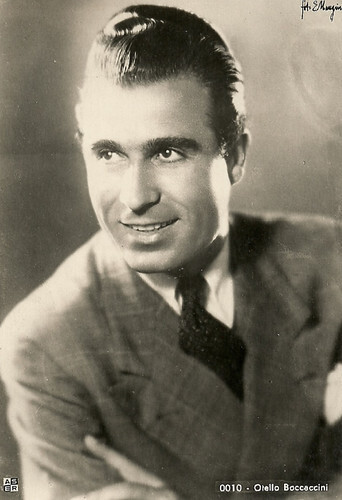
Italian postcard by ASER (Aldo Scarmiglia Ed. Roma), no. 10. Photo: E. Mangini.
Otello Boccaccini (1910-1992) was an Italian singer and actor. Boccaccini played himself in the film Ecco la radio! (Giacomo Gentilomo, 1940), dedicated to the glories of the state radio corporation. It was his only film performance.
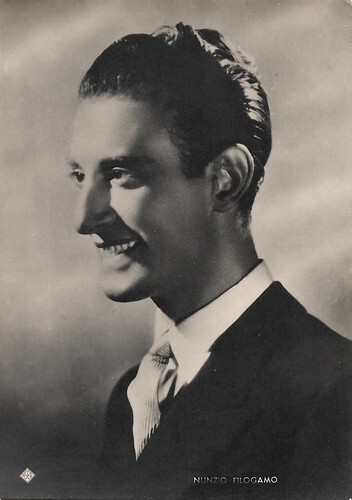
Italian postcard by ASER (Aldo Scarmiglia Ed. Roma), no. 31. Photo: Romeo / EIAR.
Nunzio Filogamo (1902-2002), was an Italian radio presenter, television host, actor, singer and radio director. After making his debut on the radio, he was one of the first television presenters on Italian television, in particular the first presenter of the music festival Festival di Sanremo, of which he hosted a total of five editions.
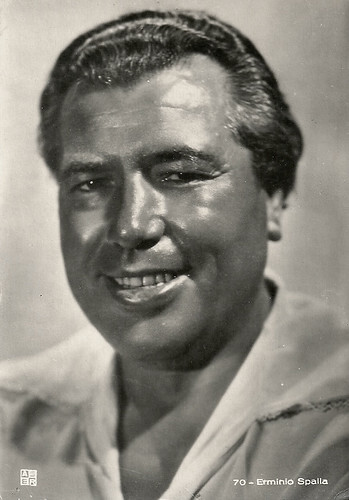
Italian postcard by ASER (Aldo Scarmiglia Ed. Roma), no. 70. Photographer: unknown.
Erminio Spalla (1897-1971) was an Italian professional heavyweight boxer, film actor and singer.
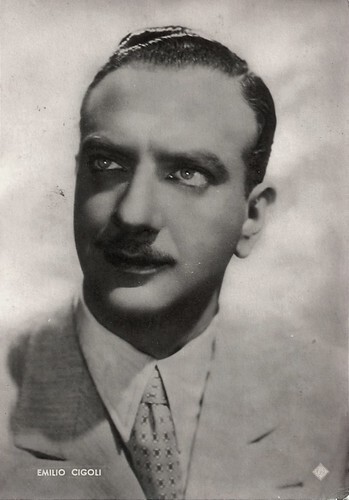
Italian postcard by ASER (Aldo Scarmiglia Ed. Roma), no. 71. Photo: Pesce / Scalera Film.
Emilio Cigoli (1909-1980) was an Italian actor, voice actor and dubbing director. His most important and best-known film performance remains that of the tragic father in Vittorio De Sica's I bambini ci guardano (1943). De Sica called him back a few years later in Sciuscià, but Cigoli's performance in Domenica d'agosto (Luciano Emer, 1950) is also worth remembering.
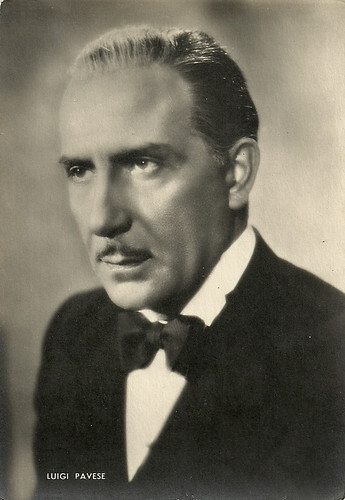
Italian postcard by ASER (Aldo Scarmiglia Ed. Roma), no. 89. Photo: Pesce / Scalera Film.
Italian actor and voice actor Luigi Pavese (1897-1969) was endowed with great versatility. Pavese was among the greatest character actors of Italian cinema. During his career, which lasted over forty years, he appeared in more than 170 films. Endowed with an unmistakable vocal timbre, deep and incisive, he was also an appreciated and prolific voice actor.
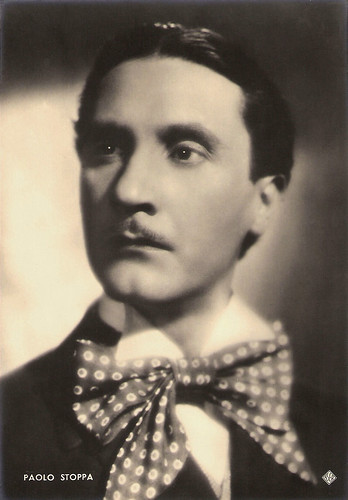
Italian postcard by ASER (A. Scarmiglia Ed., Roma), no. 96. Photo: Pesce.
Italian character actor Paolo Stoppa (1906–1988) is best known for his stage work with director Luchino Visconti. In a career of more than 50 years, he also appeared in such cinema classics as Miracolo a Milano (1951), Il Gattopardo (1962) and Once Upon a Time in the West (1968).

Italian postcard by ASER (Aldo Scarmiglia Ed. Roma), no. 134.
Italian actor and voice actor Cesare Fantoni (1905-1963) was a long-time performer in prose theatre and played in numerous works directed by Luchino Visconti, such as 'Life with Father' (1947), 'Eurydice' by Anouilh (1947), Shakespeare's 'As You Like It / Rosalinda' (1948), and Euripides' Medea (1953).
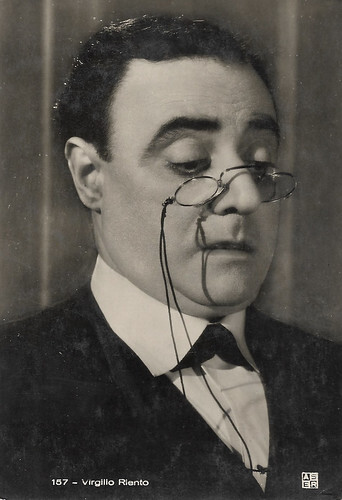
Italian postcard by ASER (Aldo Scarmiglia Ed. Roma), no. 157.
Virgilio Riento (1889-1959) was an Italian theatre and film actor. After being one of the best-loved and most popular Italian comedians of light theatre and variety in the 1920s and 1930s, Riento made his film debut in 1936 and became the sidekick of Vittorio De Sica in several films.
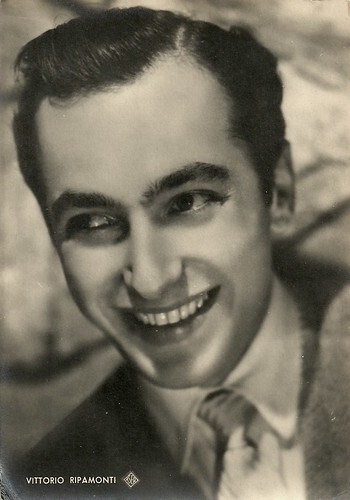
Italian postcard by ASER (Aldo Scarmiglia Ed. Roma), no. 184. Photo: Luxardo.
Vittorio Ripamonti (1916-2001) was an Italian actor.
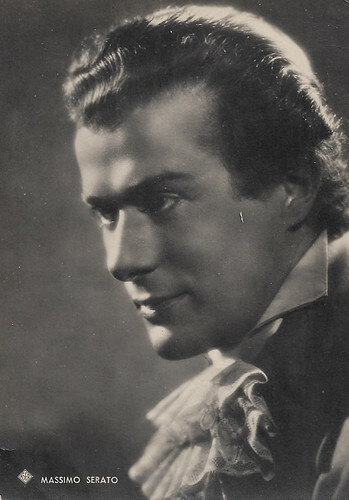
Italian postcard by ASER (Aldo Scarmiglia Ed. Roma), no. 189. Photo: Ciolfi / Aci Film.
Italian film actor Massimo Serato (1916-1989) had a career spanning over 40 years with more than 140 films. He was the virile hero of dozens of Peplum films and Spaghetti Westerns in Italy, but he also played roles in major international films.

Italian postcard by ASER (A. Scarmiglia Ed., Roma), no. 204. Photo: Vaselli / Lux Film.
Italian actor Roberto Villa (1915-2002) was the charming and relaxed star of numerous Italian comedies and adventure films of the 1930s and 1940s. After the war Villa dubbed many international films.
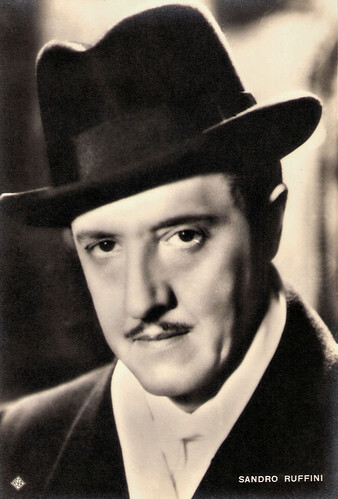
Italian postcard by ASER (Aldo Scarmiglia Ed. Roma), no. 315. Photo: Gneme.
Sandro Ruffini (1889–1954) had a prolific career in Italian cinema from the early 1910s to the mid-1950s.
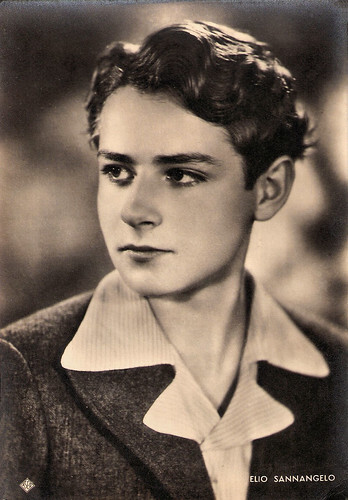
Italian postcard by ASER (Aldo Scarmiglia Ed. Roma), no. unknown.
Elio Sannangelo (1926) is an Italian actor, who was active between 1935 and 1940 in film and theatre as a child actor.
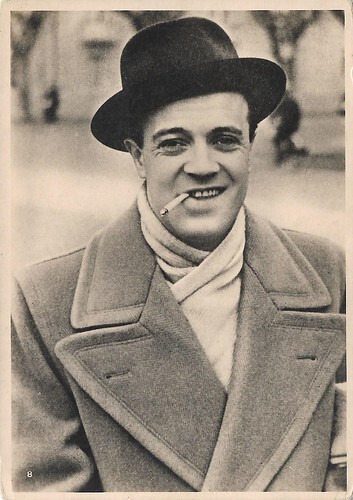
Italian postcard by ASER (Aldo Scarmiglia Ed. Roma), no. unknown. Foto: Stampa Angeli, Terni.
Fausto Tommei (1909-1978) was an Italian actor and voice actor.
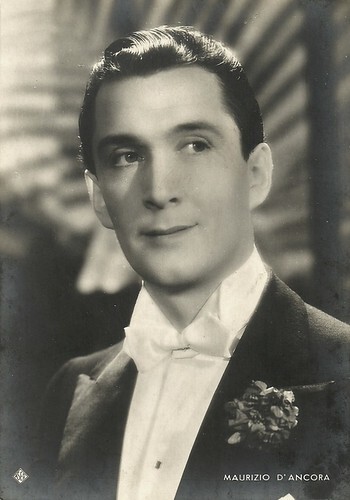
Italian postcard by ASER (Aldo Scarmiglia Ed. Roma), no. unknown.
Maurizio D'Ancora, stage name of Rodolfo Gucci (1912-1983), was an Italian actor and entrepreneur.

Italian postcard by ASER (Aldo Scarmiglia Ed. Roma), no. 10. Photo: E. Mangini.
Otello Boccaccini (1910-1992) was an Italian singer and actor. Boccaccini played himself in the film Ecco la radio! (Giacomo Gentilomo, 1940), dedicated to the glories of the state radio corporation. It was his only film performance.

Italian postcard by ASER (Aldo Scarmiglia Ed. Roma), no. 31. Photo: Romeo / EIAR.
Nunzio Filogamo (1902-2002), was an Italian radio presenter, television host, actor, singer and radio director. After making his debut on the radio, he was one of the first television presenters on Italian television, in particular the first presenter of the music festival Festival di Sanremo, of which he hosted a total of five editions.

Italian postcard by ASER (Aldo Scarmiglia Ed. Roma), no. 70. Photographer: unknown.
Erminio Spalla (1897-1971) was an Italian professional heavyweight boxer, film actor and singer.

Italian postcard by ASER (Aldo Scarmiglia Ed. Roma), no. 71. Photo: Pesce / Scalera Film.
Emilio Cigoli (1909-1980) was an Italian actor, voice actor and dubbing director. His most important and best-known film performance remains that of the tragic father in Vittorio De Sica's I bambini ci guardano (1943). De Sica called him back a few years later in Sciuscià, but Cigoli's performance in Domenica d'agosto (Luciano Emer, 1950) is also worth remembering.

Italian postcard by ASER (Aldo Scarmiglia Ed. Roma), no. 89. Photo: Pesce / Scalera Film.
Italian actor and voice actor Luigi Pavese (1897-1969) was endowed with great versatility. Pavese was among the greatest character actors of Italian cinema. During his career, which lasted over forty years, he appeared in more than 170 films. Endowed with an unmistakable vocal timbre, deep and incisive, he was also an appreciated and prolific voice actor.

Italian postcard by ASER (A. Scarmiglia Ed., Roma), no. 96. Photo: Pesce.
Italian character actor Paolo Stoppa (1906–1988) is best known for his stage work with director Luchino Visconti. In a career of more than 50 years, he also appeared in such cinema classics as Miracolo a Milano (1951), Il Gattopardo (1962) and Once Upon a Time in the West (1968).

Italian postcard by ASER (Aldo Scarmiglia Ed. Roma), no. 134.
Italian actor and voice actor Cesare Fantoni (1905-1963) was a long-time performer in prose theatre and played in numerous works directed by Luchino Visconti, such as 'Life with Father' (1947), 'Eurydice' by Anouilh (1947), Shakespeare's 'As You Like It / Rosalinda' (1948), and Euripides' Medea (1953).

Italian postcard by ASER (Aldo Scarmiglia Ed. Roma), no. 157.
Virgilio Riento (1889-1959) was an Italian theatre and film actor. After being one of the best-loved and most popular Italian comedians of light theatre and variety in the 1920s and 1930s, Riento made his film debut in 1936 and became the sidekick of Vittorio De Sica in several films.

Italian postcard by ASER (Aldo Scarmiglia Ed. Roma), no. 184. Photo: Luxardo.
Vittorio Ripamonti (1916-2001) was an Italian actor.

Italian postcard by ASER (Aldo Scarmiglia Ed. Roma), no. 189. Photo: Ciolfi / Aci Film.
Italian film actor Massimo Serato (1916-1989) had a career spanning over 40 years with more than 140 films. He was the virile hero of dozens of Peplum films and Spaghetti Westerns in Italy, but he also played roles in major international films.

Italian postcard by ASER (A. Scarmiglia Ed., Roma), no. 204. Photo: Vaselli / Lux Film.
Italian actor Roberto Villa (1915-2002) was the charming and relaxed star of numerous Italian comedies and adventure films of the 1930s and 1940s. After the war Villa dubbed many international films.

Italian postcard by ASER (Aldo Scarmiglia Ed. Roma), no. 315. Photo: Gneme.
Sandro Ruffini (1889–1954) had a prolific career in Italian cinema from the early 1910s to the mid-1950s.

Italian postcard by ASER (Aldo Scarmiglia Ed. Roma), no. unknown.
Elio Sannangelo (1926) is an Italian actor, who was active between 1935 and 1940 in film and theatre as a child actor.

Italian postcard by ASER (Aldo Scarmiglia Ed. Roma), no. unknown. Foto: Stampa Angeli, Terni.
Fausto Tommei (1909-1978) was an Italian actor and voice actor.

Italian postcard by ASER (Aldo Scarmiglia Ed. Roma), no. unknown.
Maurizio D'Ancora, stage name of Rodolfo Gucci (1912-1983), was an Italian actor and entrepreneur.
Published on January 07, 2023 22:00
January 6, 2023
ASER: 15 rediscovered Italian actresses
Aldo Scarmiglia created popular collector cards and postcards of Italian stars of the late 1930s and early 1940s. Scarmiglia published them under the abbreviation ASER (A. Scarmiglia Edizioni, Roma). Ivo Blom likes to collect these cards and here are 15 new finds of ASER cards with mostly forgotten Italian actresses.
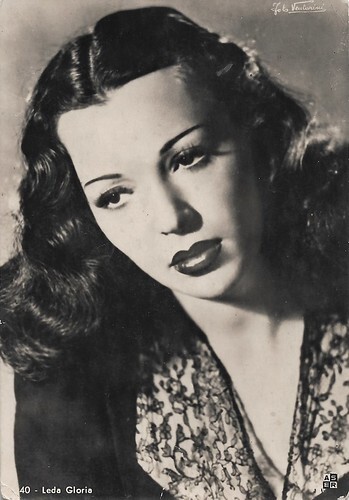
Italian postcard by ASER (A. Scarmiglia Ed., Roma), no. 40. Photo: Venturini.
Leda Gloria (1912-1997) was one of Federico Fellini’s favourite film actresses, having a prolific career in the 1930s and 1940s but is also remembered as the wife of Peppone in the Don Camillo films.
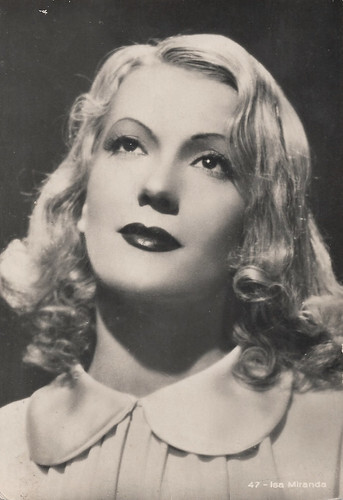
Italian postcard by ASER (Aldo Scarmiglia Edizioni, Roma), no. 47. Photo: Pesce / Scalera Film.
Isa Miranda (1905–1982) was the only international film star produced by the Italian fascist cinema. In Hollywood, she was billed as the ‘Italian Marlene Dietrich’ and played femme fatale roles. Later she became one of the most significant European film actresses during the 1940s and early 1950s.
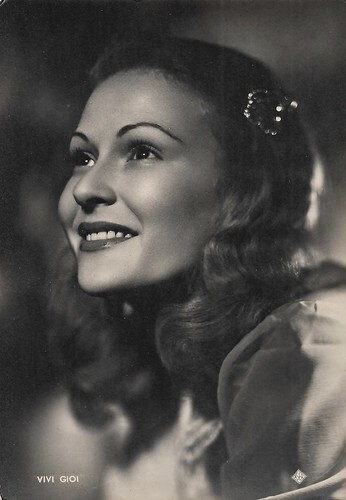
Italian postcard by ASER (A. Scarmiglia Ed., Roma), no. 57. Photo: De Antonis.
Vivi Gioi (1917–1975) was an Italian actress, who first excelled in the 'Telefoni Bianchi' comedies, later on in dramatic films during the war and the late 1940s. Her best-known role is in Giuseppe De Santis' Neorealist drama Caccia tragica/Tragic Hunt (1947). In the late 1940s, she was also a major stage actress under the direction of Luchino Visconti and others.
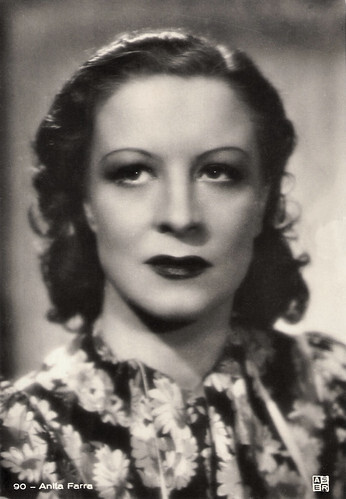
Italian postcard by ASER (Aldo Scarmiglia Ed., Roma), no. 90. Photo: Pesce / Scalera Film.
Anita Farra (1905–1979) was an Italian actress and scriptwriter, who also worked in Spain.
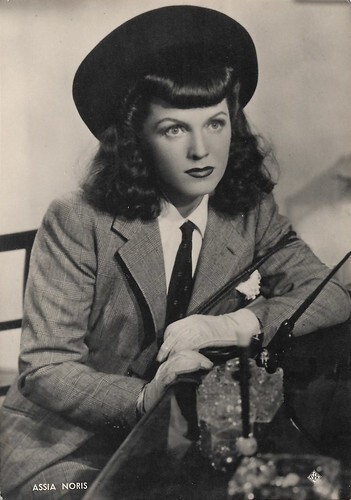
Italian postcard by ASER (A. Scarmiglia Ed., Roma), no. 135. Photo: Vaselli.
Assia Noris (1912-1998) is best remembered as the star of several 1930s romantic comedies, directed by Mario Camerini and co-starring Vittorio De Sica.
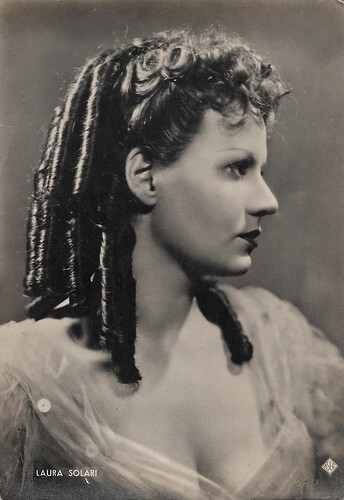
Italian postcard by ASER (A. Scarmiglia Ed., Roma), no. 195. Photo: Ciolfi / ACi Film.
Laura Solari (1913–1984) was an Italian film actress, who also appeared in German films. She appeared in 30 films between 1936 and 1969.
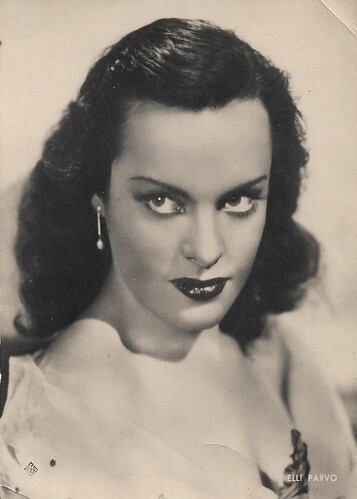
Italian postcard by ASER (A. Scarmiglia Ed., Roma), no. 209. Photo: Pesce / Scalera Film.
Elli Parvo (1914–2010) was an Italian screen actress between the mid-1930s and 1960 and known as the woman men fight over as in Desiderio (1943-45) or the femme fatale as in Il sole sorge ancora (1946). "Gorgeous, dark-haired, luscious-lipped, shapely-legged, not afraid of showing as much of her body as could be, Elli Parvo was THE femme fatale of post-war Italy." (Guy Bellinger on IMDb).
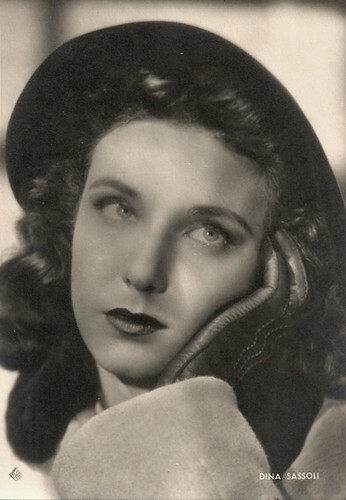
Italian postcard by ASER (A. Scarmiglia Ed., Roma), no. 212. Photo: Pesce / Scalera Film.
Dina Sassoli (1920-2008) was an Italian stage and screen actress, who broke through with I promessi sposi (Mario Camerini, 1941).
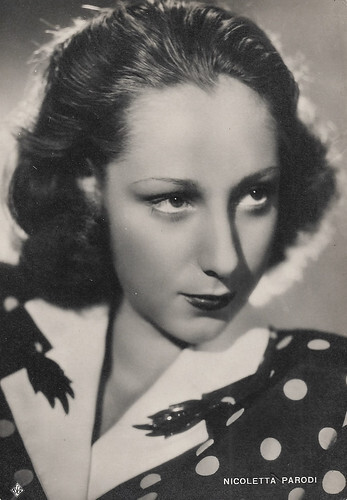
Italian postcard by ASER (A. Scarmiglia Ed., Roma), no. 299. Photo: Vaselli / Lux Film.
Nicoletta Parodi, born Maria Nicoletta Parodi (1920-2013), was an Italian actress of the 1940s.
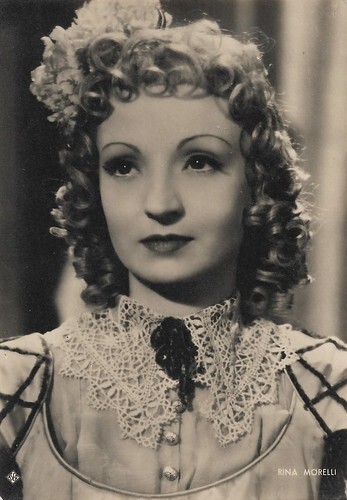
Italian postcard by ASER (Aldo Scarmiglia Ed., Roma), no. 215, Photo by Pesce / Scalera Film. Rina Morelli in Don Giovanni (Dino Falconi, 1942).
Italian actress and voice actor Rina Morelli (1908-1976), was the companion on stage and in the life of Paolo Stoppa. She played in Luchino Visconti's films Senso (1954), Il gattopardo (1963) and L'innocente (1976), as well as in many of his stage plays.
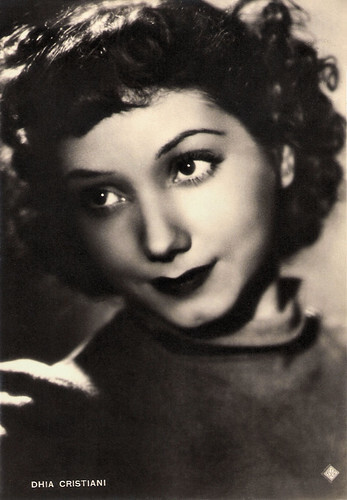
Italian postcard by ASER (A. Scarmiglia, Edizioni, Roma), no. 310. Photo: Vaselli / Europa Film. Dhia Cristiani in La statua vivente (Camillo Mastrocinque, 1943), starring Laura Solari and Fosco Giacchetti.
Dhia Cristiani (1921-1977) was an Italian actress and voice actor. From 1938 she played several supporting parts in such films as Mario Camerini's comedy I grandi magazzini (1939), as well as the chaste prostitute in Luchino Visconti's Ossessione (1943).
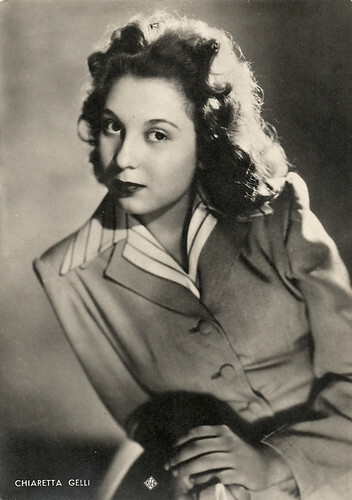
Italian postcard by ASER (A. Scarmiglia Ed., Roma), no. 354. Photo: Luxardo / Lux Film.
Chiaretta Gelli, the stage name of Yvette Da Todi (1925-2007), was an Italian singer and actress. Some considered her to be the new Italian Deanna Durbin.
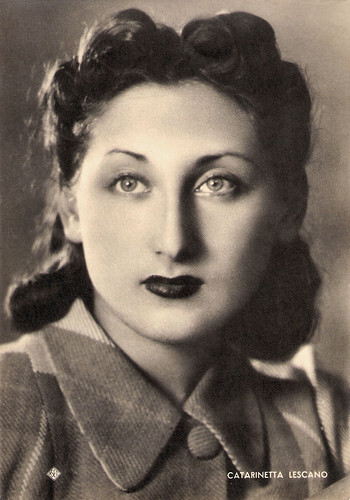
Italian postcard by Aser, Roma, no. N 0019. Photo: E.I.A.R. / Romeo.
Trio Lescano or Lescano Trio was a trio of Dutch sisters singing Italian swing: Alexandra (1910-1987), Judith (1913-2007), and Kitty Leschan (1919-1965), whose names were Italianized into Alessandra, Giuditta and Caterinetta (Caterina) Lescano. Trio Lescano was an Italian version of such American groups as the Boswell Sisters and the Andrews Sisters and became extremely popular in Italy in the 1930s and 1940s. Their hits 'Tulipan' and 'Ciribiribin' became evergreens in Italy. In 1940 they performed a musical number, 'Oh! Ma-ma!', in the film Ecco la radio!/Here Is the Radio! (Giacomo Gentilomo, 1940) dedicated to EIAR. In 1943, the golden career of the Jewish girls suddenly halted, but after the war two of them continued their careers in Argentina.
Tomorrow, 'ASER: 15 rediscovered Italian actors'. And check out our earlier post on ASER.

Italian postcard by ASER (A. Scarmiglia Ed., Roma), no. 40. Photo: Venturini.
Leda Gloria (1912-1997) was one of Federico Fellini’s favourite film actresses, having a prolific career in the 1930s and 1940s but is also remembered as the wife of Peppone in the Don Camillo films.

Italian postcard by ASER (Aldo Scarmiglia Edizioni, Roma), no. 47. Photo: Pesce / Scalera Film.
Isa Miranda (1905–1982) was the only international film star produced by the Italian fascist cinema. In Hollywood, she was billed as the ‘Italian Marlene Dietrich’ and played femme fatale roles. Later she became one of the most significant European film actresses during the 1940s and early 1950s.

Italian postcard by ASER (A. Scarmiglia Ed., Roma), no. 57. Photo: De Antonis.
Vivi Gioi (1917–1975) was an Italian actress, who first excelled in the 'Telefoni Bianchi' comedies, later on in dramatic films during the war and the late 1940s. Her best-known role is in Giuseppe De Santis' Neorealist drama Caccia tragica/Tragic Hunt (1947). In the late 1940s, she was also a major stage actress under the direction of Luchino Visconti and others.

Italian postcard by ASER (Aldo Scarmiglia Ed., Roma), no. 90. Photo: Pesce / Scalera Film.
Anita Farra (1905–1979) was an Italian actress and scriptwriter, who also worked in Spain.

Italian postcard by ASER (A. Scarmiglia Ed., Roma), no. 135. Photo: Vaselli.
Assia Noris (1912-1998) is best remembered as the star of several 1930s romantic comedies, directed by Mario Camerini and co-starring Vittorio De Sica.

Italian postcard by ASER (A. Scarmiglia Ed., Roma), no. 195. Photo: Ciolfi / ACi Film.
Laura Solari (1913–1984) was an Italian film actress, who also appeared in German films. She appeared in 30 films between 1936 and 1969.

Italian postcard by ASER (A. Scarmiglia Ed., Roma), no. 209. Photo: Pesce / Scalera Film.
Elli Parvo (1914–2010) was an Italian screen actress between the mid-1930s and 1960 and known as the woman men fight over as in Desiderio (1943-45) or the femme fatale as in Il sole sorge ancora (1946). "Gorgeous, dark-haired, luscious-lipped, shapely-legged, not afraid of showing as much of her body as could be, Elli Parvo was THE femme fatale of post-war Italy." (Guy Bellinger on IMDb).

Italian postcard by ASER (A. Scarmiglia Ed., Roma), no. 212. Photo: Pesce / Scalera Film.
Dina Sassoli (1920-2008) was an Italian stage and screen actress, who broke through with I promessi sposi (Mario Camerini, 1941).

Italian postcard by ASER (A. Scarmiglia Ed., Roma), no. 299. Photo: Vaselli / Lux Film.
Nicoletta Parodi, born Maria Nicoletta Parodi (1920-2013), was an Italian actress of the 1940s.

Italian postcard by ASER (Aldo Scarmiglia Ed., Roma), no. 215, Photo by Pesce / Scalera Film. Rina Morelli in Don Giovanni (Dino Falconi, 1942).
Italian actress and voice actor Rina Morelli (1908-1976), was the companion on stage and in the life of Paolo Stoppa. She played in Luchino Visconti's films Senso (1954), Il gattopardo (1963) and L'innocente (1976), as well as in many of his stage plays.

Italian postcard by ASER (A. Scarmiglia, Edizioni, Roma), no. 310. Photo: Vaselli / Europa Film. Dhia Cristiani in La statua vivente (Camillo Mastrocinque, 1943), starring Laura Solari and Fosco Giacchetti.
Dhia Cristiani (1921-1977) was an Italian actress and voice actor. From 1938 she played several supporting parts in such films as Mario Camerini's comedy I grandi magazzini (1939), as well as the chaste prostitute in Luchino Visconti's Ossessione (1943).

Italian postcard by ASER (A. Scarmiglia Ed., Roma), no. 354. Photo: Luxardo / Lux Film.
Chiaretta Gelli, the stage name of Yvette Da Todi (1925-2007), was an Italian singer and actress. Some considered her to be the new Italian Deanna Durbin.

Italian postcard by Aser, Roma, no. N 0019. Photo: E.I.A.R. / Romeo.
Trio Lescano or Lescano Trio was a trio of Dutch sisters singing Italian swing: Alexandra (1910-1987), Judith (1913-2007), and Kitty Leschan (1919-1965), whose names were Italianized into Alessandra, Giuditta and Caterinetta (Caterina) Lescano. Trio Lescano was an Italian version of such American groups as the Boswell Sisters and the Andrews Sisters and became extremely popular in Italy in the 1930s and 1940s. Their hits 'Tulipan' and 'Ciribiribin' became evergreens in Italy. In 1940 they performed a musical number, 'Oh! Ma-ma!', in the film Ecco la radio!/Here Is the Radio! (Giacomo Gentilomo, 1940) dedicated to EIAR. In 1943, the golden career of the Jewish girls suddenly halted, but after the war two of them continued their careers in Argentina.
Tomorrow, 'ASER: 15 rediscovered Italian actors'. And check out our earlier post on ASER.
Published on January 06, 2023 22:00
January 5, 2023
James Hall
James Hall (1900-1940) was an American actor of the silent and early talkies era. He was best known for playing the character roles of handsomely rugged good looking men during the late 1920s. Most notable was his role of 'Roy Rutledge' in the World War I aviation epic Hell's Angels (1930).
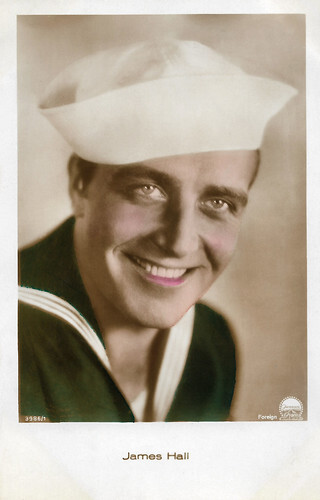
British postcard by Ross Verlag Foreign, no. 3986/1, 1928-1929. Photo: Paramount. James Hall in The Fleet’s In (Malcolm St. Clair, 1928).
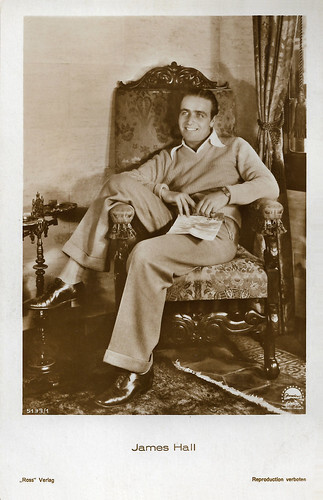
German postcard by Ross Verlag no. 5133/1, 1930-1931. Photo: Paramount.
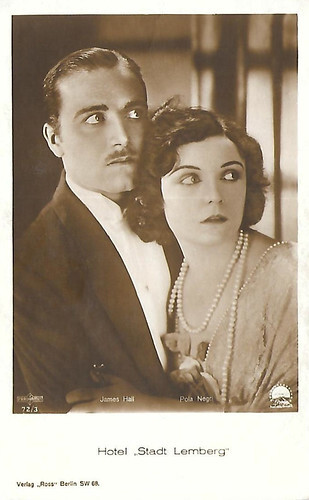
German postcard by Ross Verlag, Berlin, no. 72/3. Photo: Parufamet / Paramount. With Pola Negri in Hotel Imperial (Mauritz Stiller, 1927). Collection: Didier Hanson.
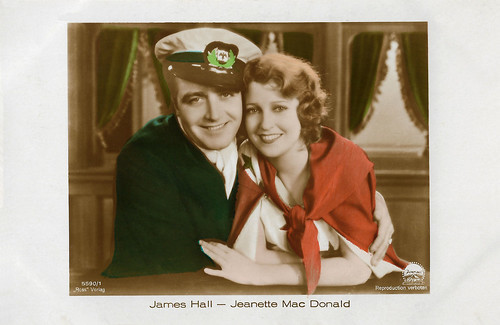
German postcard by Ross Verlag, no. 5590/1, 1930-1931. Photo: Paramount. James Hall and Jeanette MacDonald in Let's Go Native (Leo McCarey, 1930). Collection: Geoffrey Donaldson Institute.
Boyish and flattering
James Hall, whose real name was James E. Brown, was born in Dallas, Texas in 1900. He was one of four children of Clinton Pierce "Jack" Brown and his wife Alice Mckay Brown.
James was considered a talented athlete in his school days and joined an acting group at the age of 14. After a deployment in the First World War, he continued his acting career and appeared mainly in musical roles.
In the mid-1920s, he signed a studio contract with Paramount producer Jesse L. Lasky, whereupon the "boyish, flattering" Hall was a leading actor in the following years.
In 1928 he could be seen in the drama Four Sons, directed by John Ford as a German emigrant in the USA who is fighting against his homeland in the war.
Hall made his sound film debut in the crime mystery The Canary Murder Case (Malcolm St. Clair, 1929), opposite William Powell and Louise Brooks .
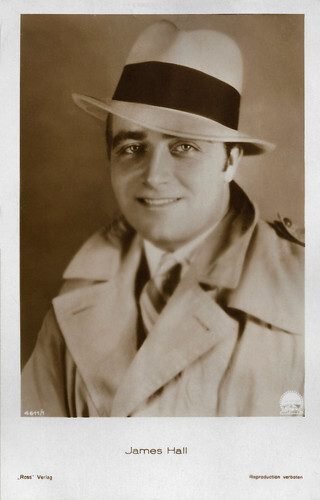
German postcard by Ross Verlag no. 4611/1, 1929-1930. Photo: Paramount.
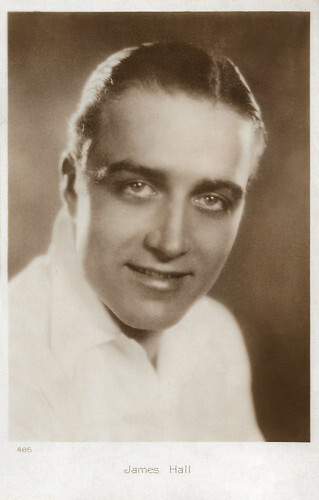
French postcard by Cinémagazine-Edition, Paris, no. 485.
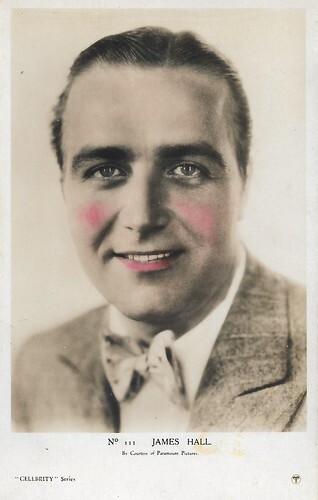
British postcard in the Celebrity Series, no. 111, by Associated Photo Printers, London. Photo: W & F Film Service / Paramount Pictures.
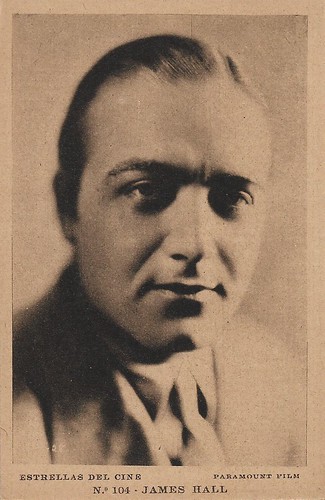
Spanish postcard in the Estrellas del cine series by Editorial Grafica, Barcelona, no. 104. Photo: Paramount Film.
Flying epic
With the dawn of the talkies at the end of the 1920s, James Hall's career was in descent, but in 1930 he was given what is probably his best-known role in Howard Hughes’ flying epic Hell's Angels. The film was directed by Hughes, Edmund Goulding, and James Whale and also starred Ben Lyon and Jean Harlow.
But while in 1928 he was still collecting $ 10,000 a week at The Fifty-Fifty Girl (Clarence Badger, 1928), two years later with Hell's Angels (Howard Hughes, 1930) it was only $ 2500.
After a few less noteworthy parts, James Hall's film career ended in 1932 and his last film role was in the drama Manhattan Tower (Frank R. Strayer, 1932).
Hall tried to gain a foothold in the theatre again. In the following years, he headlined in vaudeville at the Loew's State Theatres in 1932 and 1933 and in such independent stage productions as Ches Davis's 1934 edition of the 'Chicago Follies' and in another show, the 'Showboat Follies' at the Deadwood Theatre in South Dakota (1934). After that, he only received engagements for smaller nightclubs and cabaret shows.
Hall was married to Irene Gardner and the marriage ended in divorce. James Hall passed away in 1940 in Jersey City, New Jersey, USA, at age 39. He died of cirrhosis of the liver as a result of prolonged excessive alcohol consumption. He was buried in Holy Cross Cemetery in North Arlington.
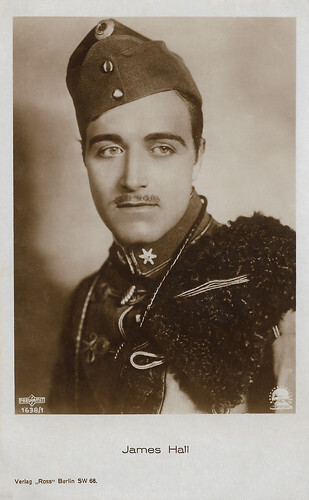
German postcard by Ross Verlag no. 1638/1, 1927-1928. Photo: ParUfaMet / Paramount. James Hall in Hotel Imperial (Mauritz Stiller, 1927). The German film title was Hotel "Stadt Lemberg".
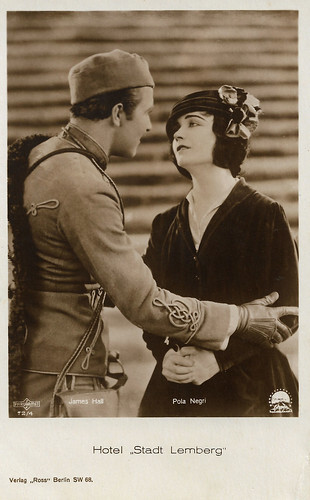
German postcard by Ross Verlag, Berlin, no. 72/4. Photo: ParUfaMet / Paramount. James Hall and Pola Negri in Hotel Imperial (Mauritz Stiller, 1927). The German film title was Hotel "Stadt Lemberg".
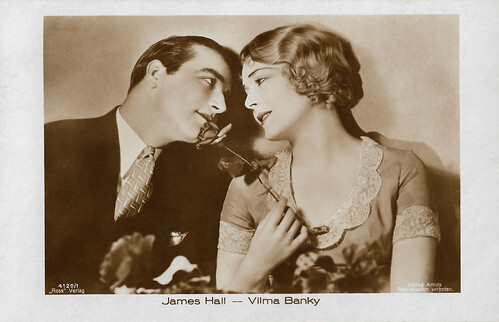
German postcard by Ross Verlag, no. 4120/1, 1929-1930. Photo: United Artists. James Hall and Vilma Banky in This is Heaven (Alfred Santell, 1929).
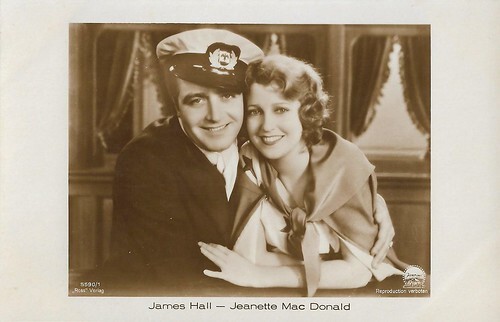
German postcard by Ross Verlag, no. 5590/1, 1930-1931. Photo: Paramount. James Hall and Jeanette MacDonald in Let's Go Native (Leo McCarey, 1930).
Sources: Kris 'Peterborough K' Peterson (Find A Grave), Wikipedia (German and English), and .

British postcard by Ross Verlag Foreign, no. 3986/1, 1928-1929. Photo: Paramount. James Hall in The Fleet’s In (Malcolm St. Clair, 1928).

German postcard by Ross Verlag no. 5133/1, 1930-1931. Photo: Paramount.

German postcard by Ross Verlag, Berlin, no. 72/3. Photo: Parufamet / Paramount. With Pola Negri in Hotel Imperial (Mauritz Stiller, 1927). Collection: Didier Hanson.

German postcard by Ross Verlag, no. 5590/1, 1930-1931. Photo: Paramount. James Hall and Jeanette MacDonald in Let's Go Native (Leo McCarey, 1930). Collection: Geoffrey Donaldson Institute.
Boyish and flattering
James Hall, whose real name was James E. Brown, was born in Dallas, Texas in 1900. He was one of four children of Clinton Pierce "Jack" Brown and his wife Alice Mckay Brown.
James was considered a talented athlete in his school days and joined an acting group at the age of 14. After a deployment in the First World War, he continued his acting career and appeared mainly in musical roles.
In the mid-1920s, he signed a studio contract with Paramount producer Jesse L. Lasky, whereupon the "boyish, flattering" Hall was a leading actor in the following years.
In 1928 he could be seen in the drama Four Sons, directed by John Ford as a German emigrant in the USA who is fighting against his homeland in the war.
Hall made his sound film debut in the crime mystery The Canary Murder Case (Malcolm St. Clair, 1929), opposite William Powell and Louise Brooks .

German postcard by Ross Verlag no. 4611/1, 1929-1930. Photo: Paramount.

French postcard by Cinémagazine-Edition, Paris, no. 485.

British postcard in the Celebrity Series, no. 111, by Associated Photo Printers, London. Photo: W & F Film Service / Paramount Pictures.

Spanish postcard in the Estrellas del cine series by Editorial Grafica, Barcelona, no. 104. Photo: Paramount Film.
Flying epic
With the dawn of the talkies at the end of the 1920s, James Hall's career was in descent, but in 1930 he was given what is probably his best-known role in Howard Hughes’ flying epic Hell's Angels. The film was directed by Hughes, Edmund Goulding, and James Whale and also starred Ben Lyon and Jean Harlow.
But while in 1928 he was still collecting $ 10,000 a week at The Fifty-Fifty Girl (Clarence Badger, 1928), two years later with Hell's Angels (Howard Hughes, 1930) it was only $ 2500.
After a few less noteworthy parts, James Hall's film career ended in 1932 and his last film role was in the drama Manhattan Tower (Frank R. Strayer, 1932).
Hall tried to gain a foothold in the theatre again. In the following years, he headlined in vaudeville at the Loew's State Theatres in 1932 and 1933 and in such independent stage productions as Ches Davis's 1934 edition of the 'Chicago Follies' and in another show, the 'Showboat Follies' at the Deadwood Theatre in South Dakota (1934). After that, he only received engagements for smaller nightclubs and cabaret shows.
Hall was married to Irene Gardner and the marriage ended in divorce. James Hall passed away in 1940 in Jersey City, New Jersey, USA, at age 39. He died of cirrhosis of the liver as a result of prolonged excessive alcohol consumption. He was buried in Holy Cross Cemetery in North Arlington.

German postcard by Ross Verlag no. 1638/1, 1927-1928. Photo: ParUfaMet / Paramount. James Hall in Hotel Imperial (Mauritz Stiller, 1927). The German film title was Hotel "Stadt Lemberg".

German postcard by Ross Verlag, Berlin, no. 72/4. Photo: ParUfaMet / Paramount. James Hall and Pola Negri in Hotel Imperial (Mauritz Stiller, 1927). The German film title was Hotel "Stadt Lemberg".

German postcard by Ross Verlag, no. 4120/1, 1929-1930. Photo: United Artists. James Hall and Vilma Banky in This is Heaven (Alfred Santell, 1929).

German postcard by Ross Verlag, no. 5590/1, 1930-1931. Photo: Paramount. James Hall and Jeanette MacDonald in Let's Go Native (Leo McCarey, 1930).
Sources: Kris 'Peterborough K' Peterson (Find A Grave), Wikipedia (German and English), and .
Published on January 05, 2023 22:00
January 4, 2023
Lina Millefleurs
Italian vaudeville singer of French origin Lina Millefleurs (?-?) was hired in 1914 by the film company Milano Films and appeared in several silent dramas. In 1921, she finished her film career after nearly 30 films.
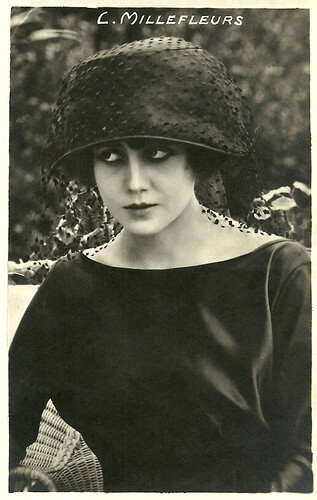
Italian postcard. Photo: Lina Millefleurs in Il padrone delle ferriere/The Owner of the Ironworks (Eugenio Perego, 1919). Collection: Didier Hanson.
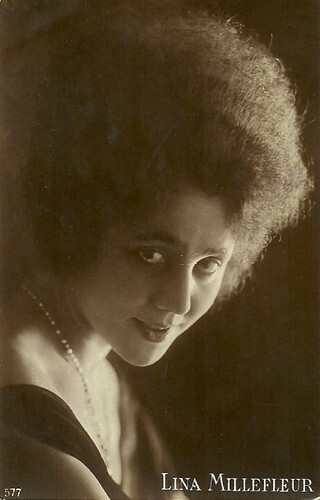
Italian postcard by Ed. A. Traldi, Milano, no. 577. The name is misspelt as Millefleur.
A young lady with a golden throat
Lina Millefleurs was born either as Carla Moneta in France or as Carla Tillosi in Italy (the sources differ). Nor her birthplace, nor her birth date, nor her parents are known.
She started her career as a singer in vaudeville. Reportedly, the great Eleonora Duse called her a "young lady with a golden throat". At the end of 1914, she was hired by the Italian film company Milano Films to star in Fiamme nell'ombra/Flames in the shadows (Baldassarre Negroni, 1915) alongside Hesperia .
She stayed there for years and acted in a series of 'pochades' such as L'appetito vien mangando/Appetite comes with eating (Eugenio Perego, 1915) and Una donna di spirito/A woman with spirit (Guglielmo Zorzi, 1915).
She also starred in dramas, such as Augusto Genina's La farfalla dalle ali d'oro/The butterfly with golden wings (Augusto Genina, 1915) with Ugo Gracci. In the latter film, a critic thought her "too clueless".
In 1915, probably on loan by Milano, she acted at Sabaudo Film in a series of dramas. In one she was the protagonist, Il Vortice/The Vortex (Salvatore Aversano,1915), based on the play by Noël Coward.
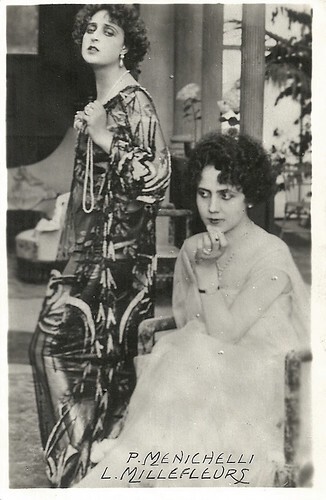
Italian postcard by C. Chierichetti, Milano, no. 02. Pina Menichelli and Lina Millefleurs in Il padrone delle ferriere/The Owner of the Ironworks (Eugenio Perego, 1919).
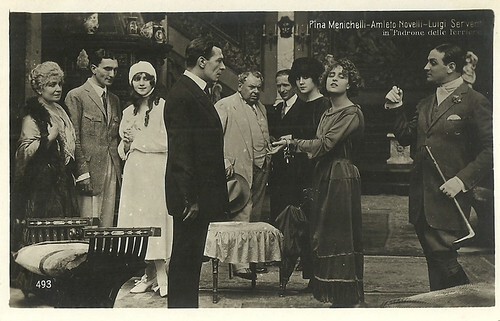
Italian postcard by Ed. Vettori, Bologna. Amleto Novelli , Lina Millefleurs, Pina Menichelli and Luigi Serventi in Il padrone delle ferrriere (Eugenio Perego, 1919), based on 'Le maitre des forges' by Georges Ohnet.
Praise for her naturalness and unaffected, un-diva-like acting
In 1916-1917, Lina Millefleurs was very active at Milano again, mainly under the guidance of Eugenio Perego. She had a notable part in Il vetturale del Moncenisio/The coachman of Mont Cenis (Leopoldo Carlucci, 1916) with Luigi Serventi .
One of her last films at Milano was Tristi amori/Sad loves (Giuseppe Sterni, 1917), based on the play by Giuseppe Giacosa and with actor-director Giuseppe Sterni in the male lead.
In 1917-1918 she acted in two films by another Milanese company, Mercurio. She received praise for her "naturalness and unaffected, un-diva-like acting" in Il Trionfo della morte/Triumph of Death (Domenico Gaido, 1918) based on a novel by Gabriele d'Annunzio .
Between 1919 and 1921 she was part of the cast at Itala Film. Here she played Athenaide in the drama Il padrone delle ferriere/The Railway Owner (Eugenio Perego, 1919). Then she moved to Rome where she worked for Tiber Film and Tespi Film. At Tiber Film she had leads in films by Giulio Antamoro and Alfredo De Antoni.
In 1921 she closed her film career with a supporting part in the serial La scimitarra del Barbarossa/The scimitar of Barbarossa (Mario Corsai, 1921). After that, Lina Millefleurs returned to the stage and continued her singing career.
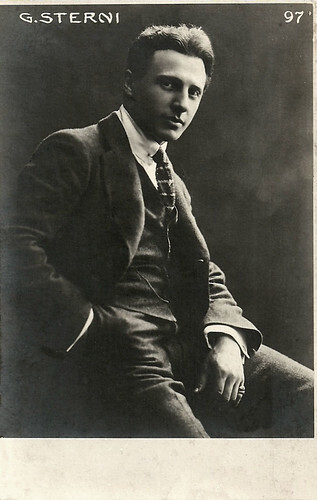
Vintage postcard, no. 97. Giuseppe Sterni.
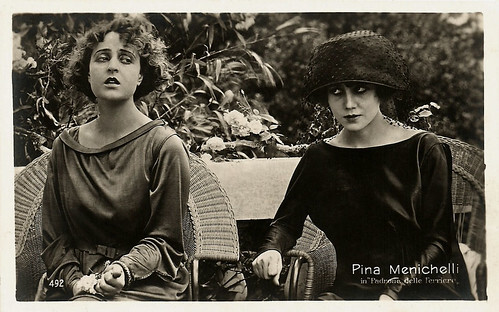
Italian postcard by Vettori, Bologna, no. 492. Photo: Pina Menichelli and Lina Millefleurs in Il padrone delle ferriere/The Owner of the Ironworks (Eugenio Perego, 1919).
Source: Aldo Bernardini (Cinema muto italiano protagonisti - Italian), Wikipedia (Italian) and .

Italian postcard. Photo: Lina Millefleurs in Il padrone delle ferriere/The Owner of the Ironworks (Eugenio Perego, 1919). Collection: Didier Hanson.

Italian postcard by Ed. A. Traldi, Milano, no. 577. The name is misspelt as Millefleur.
A young lady with a golden throat
Lina Millefleurs was born either as Carla Moneta in France or as Carla Tillosi in Italy (the sources differ). Nor her birthplace, nor her birth date, nor her parents are known.
She started her career as a singer in vaudeville. Reportedly, the great Eleonora Duse called her a "young lady with a golden throat". At the end of 1914, she was hired by the Italian film company Milano Films to star in Fiamme nell'ombra/Flames in the shadows (Baldassarre Negroni, 1915) alongside Hesperia .
She stayed there for years and acted in a series of 'pochades' such as L'appetito vien mangando/Appetite comes with eating (Eugenio Perego, 1915) and Una donna di spirito/A woman with spirit (Guglielmo Zorzi, 1915).
She also starred in dramas, such as Augusto Genina's La farfalla dalle ali d'oro/The butterfly with golden wings (Augusto Genina, 1915) with Ugo Gracci. In the latter film, a critic thought her "too clueless".
In 1915, probably on loan by Milano, she acted at Sabaudo Film in a series of dramas. In one she was the protagonist, Il Vortice/The Vortex (Salvatore Aversano,1915), based on the play by Noël Coward.

Italian postcard by C. Chierichetti, Milano, no. 02. Pina Menichelli and Lina Millefleurs in Il padrone delle ferriere/The Owner of the Ironworks (Eugenio Perego, 1919).

Italian postcard by Ed. Vettori, Bologna. Amleto Novelli , Lina Millefleurs, Pina Menichelli and Luigi Serventi in Il padrone delle ferrriere (Eugenio Perego, 1919), based on 'Le maitre des forges' by Georges Ohnet.
Praise for her naturalness and unaffected, un-diva-like acting
In 1916-1917, Lina Millefleurs was very active at Milano again, mainly under the guidance of Eugenio Perego. She had a notable part in Il vetturale del Moncenisio/The coachman of Mont Cenis (Leopoldo Carlucci, 1916) with Luigi Serventi .
One of her last films at Milano was Tristi amori/Sad loves (Giuseppe Sterni, 1917), based on the play by Giuseppe Giacosa and with actor-director Giuseppe Sterni in the male lead.
In 1917-1918 she acted in two films by another Milanese company, Mercurio. She received praise for her "naturalness and unaffected, un-diva-like acting" in Il Trionfo della morte/Triumph of Death (Domenico Gaido, 1918) based on a novel by Gabriele d'Annunzio .
Between 1919 and 1921 she was part of the cast at Itala Film. Here she played Athenaide in the drama Il padrone delle ferriere/The Railway Owner (Eugenio Perego, 1919). Then she moved to Rome where she worked for Tiber Film and Tespi Film. At Tiber Film she had leads in films by Giulio Antamoro and Alfredo De Antoni.
In 1921 she closed her film career with a supporting part in the serial La scimitarra del Barbarossa/The scimitar of Barbarossa (Mario Corsai, 1921). After that, Lina Millefleurs returned to the stage and continued her singing career.

Vintage postcard, no. 97. Giuseppe Sterni.

Italian postcard by Vettori, Bologna, no. 492. Photo: Pina Menichelli and Lina Millefleurs in Il padrone delle ferriere/The Owner of the Ironworks (Eugenio Perego, 1919).
Source: Aldo Bernardini (Cinema muto italiano protagonisti - Italian), Wikipedia (Italian) and .
Published on January 04, 2023 22:00
January 3, 2023
Diane McBain
On the morning of 21 December 2022, American actress Diane McBain (1941-2022) passed away. As a bouncy, blonde-coiffed Warner Brothers starlet, she reached a brief peak of popularity during the early 1960s as a "bad girl" and "spoiled rich girl". She was best known for playing an adventurous socialite in the television series Surfside 6 (1960–1962) and as one of Elvis Presley's leading ladies in Spinout (1966).
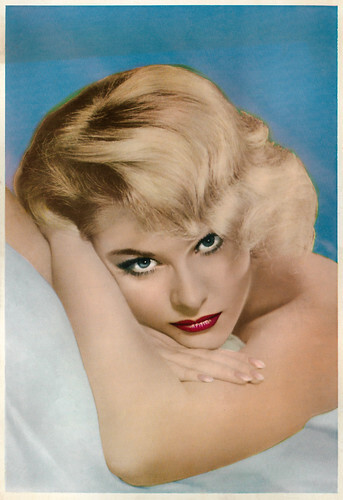
Spanish postcard by Archivo Bermejo, no. C-124, presented by Kores Carboplan. Photo: Warner Bros. Publicity still for the television series Surfside 6 (1960–1962). The Spanish title was Rompeolas 6.
A potential star
Diane Jean MacBain was born in 1941 in Cleveland, Ohio. Her parents were Walter George McBain Jr. and Cleo Lyda Ferguson. McBain moved to the Hollywood area at an early age and began her show business career as an adolescent model in print and television advertisements. During her senior year at Glendale High School, while appearing in a Los Angeles play, she was spotted by a Warner Bros talent scout and added to the studio's roster of contract performers.
Starting with the premiere of the hour-long, three-shows-in-one Warner Brothers Presents, the studio's TV arm, Warner Brothers Television, provided ABC with nearly 20 shows, including seven Westerns and four detective series. At 17, she was immediately put to work, making her television acting debut in two episodes of Maverick (1959), with Jack Kelly and James Garner, and an episode of Sunset Strip (1960). Having received a positive reaction to McBain's initial performances, the studio realised it had a potential star under contract.
She was given a prominent ingenue role in her first feature, the $3.5 million Ice Palace (Vincent Sherman, 1960) alongside Richard Burton and Robert Ryan. The filmed-on-location Technicolor epic was released in 1960, to mixed reviews, but McBain's notices were generally favourable. McBain had a banner year in 1960. She was assigned two more theatrical features. The first offered her one of three ingenue roles in a major "A" film, Parrish (Delmer Daves, 1961), supporting beefcake star Troy Donahue ; the others were Connie Stevens and Sharon Hugueny. The film was a hit and made over $4 million.
Warners then gave McBain the star part in her own "B"-film vehicle, Claudelle Inglish (Gordon Douglas, 1961) when she replaced the original choice for the lead, Anne Francis, in the title role. It was based on a novel by Erskine Caldwell. Warner Bros continued to keep McBain busy during 1960 with numerous appearances on its TV shows. She returned to 77 Sunset Strip and had a guest role in The Alaskans, starring Roger Moore . She was also in Bourbon Street Beat (1960), Sugarfoot (1960) and Lawman (1960). Then Warners gave McBain a regular role on Surfside 6 (1960–1962), supporting Troy Donahue , Van Williams, and Lee Patterson. Surfside 6 ran for two seasons.
Warners gave her another lead role in a feature, Black Gold (Leslie H. Martinson, 1962), but it was not a success. She returned to guest starring on shows like Hawaiian Eye. Producer Hall Bartlett borrowed McBain for a role in The Caretakers (Hall Bartlett, 1963) with Polly Bergen and Joan Crawford . When 77 Sunset Strip kicked off its sixth and final season in 1963 with a special five-part story called 'Five', McBain played opposite Efrem Zimbalist, Jr. as "Carla Stevens". She then supported Debbie Reynolds in Mary, Mary (Mervyn LeRoy, 1963). Her last film for Warners was the Western A Distant Trumpet (Raoul Walsh, 1964) with Donahue and Suzanne Pleshette, the final film of director Raoul Walsh. In a 1964 interview, she said she had "mostly been cast as the spoilt rich girl". Warners announced her for Sex and the Single Girl (Richard Quine, 1964) as a secretary. She turned down the role and Warners elected not to renew her contract.
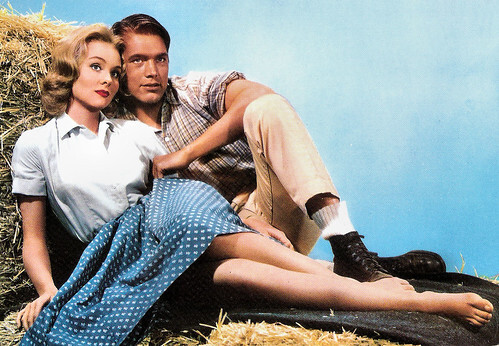
Spanish postcard by CyA, no. 56. Photo: Warner Bros. Diane McBain and Chad Everett in Claudelle Inglish (Gordon Douglas, 1961).
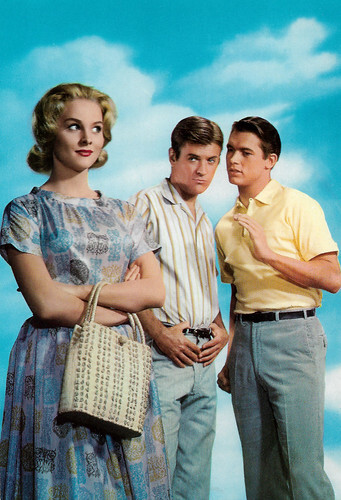
Spanish postcard by CyA, no. 67. Photo: Warner Bros. Diane McBain, Chad Everett and Will Hutchins in Claudelle Inglish (Gordon Douglas, 1961).
White Anglo-Saxon, pretty people were low on the totem pole
Diane McBain guest starred in Arrest and Trial (1964), The Wild Wild West (1965-1967), The Man from UNCLE (1965-1967), and other series. She was announced for the films Spring Is for Crying and Halcyon Years but neither was made. "I was very stupid about money," McBain said later. "My mother had always made my clothes, and I was embarrassed about it. I became a shopaholic and spent a fortune on store-bought clothes. Tammy Bakker probably copied the way I did my shopping and eyelashes."
Work began to dry up. "We were going through a revolution in society with the civil rights movement and the Vietnam War," she said. "Now, white Anglo-Saxon, pretty people were low on the totem pole. We were thought to be on the other side, conservatives who were the cause of the war and the civil-rights problem. Dustin Hoffman , yes. Troy Donahue , no. Nobody wanted beautiful people on the screen. They wanted people like them, average. I didn't get much work."
In August 1965 McBain's parents reported her as missing. It turned out she had checked herself into a hotel in San Diego under the name "Marilyn Miller" for "a change of faces, scenery and attitudes... I just wanted to be Miss Nobody from Nowhere." She said she had been despondent over a slackening income and not getting the type of roles she wanted.
She was Elvis Presley 's leading lady in Spinout (Norman Taurog, 1966) alongside Shelley Fabares and Deborah Walley, and later that year she guest-starred on the second season of the ABC series Batman (1966). She played socialite Pinkie Pinkston, with pink hair, pink outfits and a pink dog, a friend of Batman's alias Bruce Wayne (Adam West).
McBain made two films with Fabian Forte at American International Pictures, Thunder Alley (Richard Rush, 1967), and Maryjane (Maury Dexter, 1968). Dexter then put McBain in the lead of AIP's The Mini-Skirt Mob (Maury Dexter, 1968), a hit at the box office. McBain supported Gardner McKay in I Sailed to Tahiti with an All Girl Crew (Richard L. Bare, 1968) and went to Crown International Pictures for Five the Hard Way (Gus Trikonis, 1969). She toured Vietnam in 1968 with Tippi Hedren and Joey Bishop.
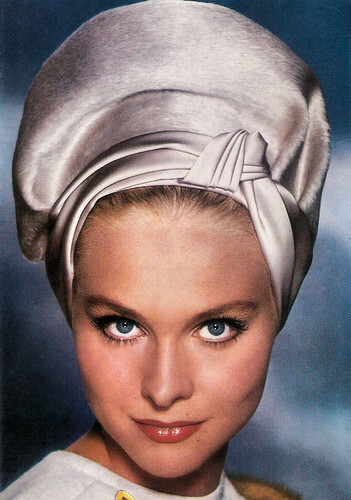
Spanish postcard by Postal Oscarcolor, no. 365.
"The stupidest screenplay I ever had to work with"
During the 1970s, Diane McBain slowed her career somewhat to care for her son Evan, though she continued to make guest appearances in a number of television series. She was married to Evan's father, Rodney Leroy Burke, from 1972 till 1974. "I never really cared about superstardom, I only cared about the roles that were available to those who were superstars," she later said. "I was motivated to continue on in the face of total failure because I had a child to rear on my own with little help from his father. The acting was the best way for me to make money and the best way for me to be a more present mom in my son's life. Full-time jobs brought in money but kept me away from the day-to-day life of my child."
McBain guest starred in Love, American Style (1969), Mannix (1970), To Rome with Love (1970), Land of the Giants (1970), and The Mod Squad (1971). She had roles in the features The Delta Factor (Tay Garnett, 1970) with Yvette Mimieux , The Wild Season (1971), Huyendo del halcón/Flying from the Hawk (Cecil Barker, 1973), Wicked, Wicked (Richard L. Bare, 1973), and The Deathhead Virgin (Norman Foster, 1974), which she later called "the stupidest screenplay I ever had to work with."
McBain also guested on the TV series The Wide World of Mystery (1974), Police Story (1974), Barbary Coast (1975), and Marcus Welby, M.D (1976). Towards the end of the 1970s and in the early 1980s McBain was in the TV movie Donner Pass: The Road to Survival (James L. Conway, 1978), and such TV series as The Life and Times of Grizzly Adams (1978), Hawaii Five-O (1980), Charlie's Angels (1979-1981), Days of Our Lives (1982-1984), Dallas (1982), Airwolf (1984) and Knight Rider (1985). She also worked steadily in regional theatre.
In 1982, McBain was beaten, robbed, and raped by two men in her garage at West Hollywood at 1:30 am on Christmas Day, after she came home from a party. She began a second career as a rape victim counsellor. They never found the culprits. "The shock of what happened caused loss of memory, inability to concentrate, and I'm still startled out of proportion," she said in 1990. In 1990 she was seeking financing for her screenplay 'The Spilling Moon' about the first woman to trek along the Colorado River through the Grand Canyon.
The still young-looking and ever-elegant Diane was out and about in the 1990s as well, playing good-looking grandmas in such series as Jake and the Fatman (1990), Puppet Master 5 (1994), Sabrina, the Teenage Witch (1996), Dr. Quinn, Medicine Woman (1998), Invisible Mom II (1999), and The Young and the Restless (1999). In the cinema, she could be seen in the gay comedy The Broken Hearts Club (Greg Berlanti, 2000), starring Timothy Olyphant and Dean Cain, Besotted (Holly Hardman, 2001). Her final screen appearance was in the TV series Strong Medicine (2002). She was also in the TV movie Cab to Canada (Christopher Leitch, 1998) which she said: "was enough to make me never want to act again". Diane McBain died from liver cancer in 2022, at the Motion Picture Country Home in Los Angeles, California, where she had lived for a number of years. She was 81.
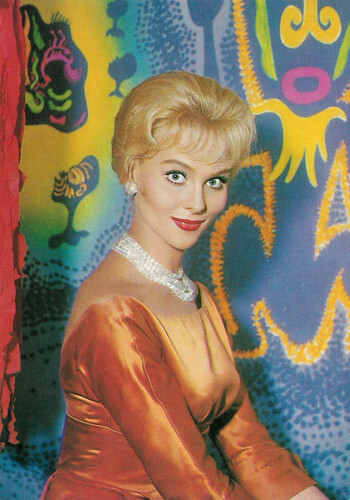
Spanish postcard by Postal Oscarcolor, no. 299.
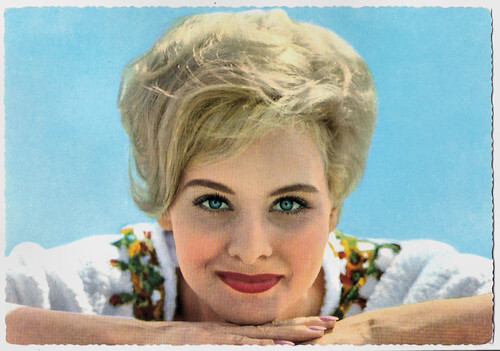
West German postcard by Krüger, no. 902/241.
Source: (IMDb), Wikipedia and .

Spanish postcard by Archivo Bermejo, no. C-124, presented by Kores Carboplan. Photo: Warner Bros. Publicity still for the television series Surfside 6 (1960–1962). The Spanish title was Rompeolas 6.
A potential star
Diane Jean MacBain was born in 1941 in Cleveland, Ohio. Her parents were Walter George McBain Jr. and Cleo Lyda Ferguson. McBain moved to the Hollywood area at an early age and began her show business career as an adolescent model in print and television advertisements. During her senior year at Glendale High School, while appearing in a Los Angeles play, she was spotted by a Warner Bros talent scout and added to the studio's roster of contract performers.
Starting with the premiere of the hour-long, three-shows-in-one Warner Brothers Presents, the studio's TV arm, Warner Brothers Television, provided ABC with nearly 20 shows, including seven Westerns and four detective series. At 17, she was immediately put to work, making her television acting debut in two episodes of Maverick (1959), with Jack Kelly and James Garner, and an episode of Sunset Strip (1960). Having received a positive reaction to McBain's initial performances, the studio realised it had a potential star under contract.
She was given a prominent ingenue role in her first feature, the $3.5 million Ice Palace (Vincent Sherman, 1960) alongside Richard Burton and Robert Ryan. The filmed-on-location Technicolor epic was released in 1960, to mixed reviews, but McBain's notices were generally favourable. McBain had a banner year in 1960. She was assigned two more theatrical features. The first offered her one of three ingenue roles in a major "A" film, Parrish (Delmer Daves, 1961), supporting beefcake star Troy Donahue ; the others were Connie Stevens and Sharon Hugueny. The film was a hit and made over $4 million.
Warners then gave McBain the star part in her own "B"-film vehicle, Claudelle Inglish (Gordon Douglas, 1961) when she replaced the original choice for the lead, Anne Francis, in the title role. It was based on a novel by Erskine Caldwell. Warner Bros continued to keep McBain busy during 1960 with numerous appearances on its TV shows. She returned to 77 Sunset Strip and had a guest role in The Alaskans, starring Roger Moore . She was also in Bourbon Street Beat (1960), Sugarfoot (1960) and Lawman (1960). Then Warners gave McBain a regular role on Surfside 6 (1960–1962), supporting Troy Donahue , Van Williams, and Lee Patterson. Surfside 6 ran for two seasons.
Warners gave her another lead role in a feature, Black Gold (Leslie H. Martinson, 1962), but it was not a success. She returned to guest starring on shows like Hawaiian Eye. Producer Hall Bartlett borrowed McBain for a role in The Caretakers (Hall Bartlett, 1963) with Polly Bergen and Joan Crawford . When 77 Sunset Strip kicked off its sixth and final season in 1963 with a special five-part story called 'Five', McBain played opposite Efrem Zimbalist, Jr. as "Carla Stevens". She then supported Debbie Reynolds in Mary, Mary (Mervyn LeRoy, 1963). Her last film for Warners was the Western A Distant Trumpet (Raoul Walsh, 1964) with Donahue and Suzanne Pleshette, the final film of director Raoul Walsh. In a 1964 interview, she said she had "mostly been cast as the spoilt rich girl". Warners announced her for Sex and the Single Girl (Richard Quine, 1964) as a secretary. She turned down the role and Warners elected not to renew her contract.

Spanish postcard by CyA, no. 56. Photo: Warner Bros. Diane McBain and Chad Everett in Claudelle Inglish (Gordon Douglas, 1961).

Spanish postcard by CyA, no. 67. Photo: Warner Bros. Diane McBain, Chad Everett and Will Hutchins in Claudelle Inglish (Gordon Douglas, 1961).
White Anglo-Saxon, pretty people were low on the totem pole
Diane McBain guest starred in Arrest and Trial (1964), The Wild Wild West (1965-1967), The Man from UNCLE (1965-1967), and other series. She was announced for the films Spring Is for Crying and Halcyon Years but neither was made. "I was very stupid about money," McBain said later. "My mother had always made my clothes, and I was embarrassed about it. I became a shopaholic and spent a fortune on store-bought clothes. Tammy Bakker probably copied the way I did my shopping and eyelashes."
Work began to dry up. "We were going through a revolution in society with the civil rights movement and the Vietnam War," she said. "Now, white Anglo-Saxon, pretty people were low on the totem pole. We were thought to be on the other side, conservatives who were the cause of the war and the civil-rights problem. Dustin Hoffman , yes. Troy Donahue , no. Nobody wanted beautiful people on the screen. They wanted people like them, average. I didn't get much work."
In August 1965 McBain's parents reported her as missing. It turned out she had checked herself into a hotel in San Diego under the name "Marilyn Miller" for "a change of faces, scenery and attitudes... I just wanted to be Miss Nobody from Nowhere." She said she had been despondent over a slackening income and not getting the type of roles she wanted.
She was Elvis Presley 's leading lady in Spinout (Norman Taurog, 1966) alongside Shelley Fabares and Deborah Walley, and later that year she guest-starred on the second season of the ABC series Batman (1966). She played socialite Pinkie Pinkston, with pink hair, pink outfits and a pink dog, a friend of Batman's alias Bruce Wayne (Adam West).
McBain made two films with Fabian Forte at American International Pictures, Thunder Alley (Richard Rush, 1967), and Maryjane (Maury Dexter, 1968). Dexter then put McBain in the lead of AIP's The Mini-Skirt Mob (Maury Dexter, 1968), a hit at the box office. McBain supported Gardner McKay in I Sailed to Tahiti with an All Girl Crew (Richard L. Bare, 1968) and went to Crown International Pictures for Five the Hard Way (Gus Trikonis, 1969). She toured Vietnam in 1968 with Tippi Hedren and Joey Bishop.

Spanish postcard by Postal Oscarcolor, no. 365.
"The stupidest screenplay I ever had to work with"
During the 1970s, Diane McBain slowed her career somewhat to care for her son Evan, though she continued to make guest appearances in a number of television series. She was married to Evan's father, Rodney Leroy Burke, from 1972 till 1974. "I never really cared about superstardom, I only cared about the roles that were available to those who were superstars," she later said. "I was motivated to continue on in the face of total failure because I had a child to rear on my own with little help from his father. The acting was the best way for me to make money and the best way for me to be a more present mom in my son's life. Full-time jobs brought in money but kept me away from the day-to-day life of my child."
McBain guest starred in Love, American Style (1969), Mannix (1970), To Rome with Love (1970), Land of the Giants (1970), and The Mod Squad (1971). She had roles in the features The Delta Factor (Tay Garnett, 1970) with Yvette Mimieux , The Wild Season (1971), Huyendo del halcón/Flying from the Hawk (Cecil Barker, 1973), Wicked, Wicked (Richard L. Bare, 1973), and The Deathhead Virgin (Norman Foster, 1974), which she later called "the stupidest screenplay I ever had to work with."
McBain also guested on the TV series The Wide World of Mystery (1974), Police Story (1974), Barbary Coast (1975), and Marcus Welby, M.D (1976). Towards the end of the 1970s and in the early 1980s McBain was in the TV movie Donner Pass: The Road to Survival (James L. Conway, 1978), and such TV series as The Life and Times of Grizzly Adams (1978), Hawaii Five-O (1980), Charlie's Angels (1979-1981), Days of Our Lives (1982-1984), Dallas (1982), Airwolf (1984) and Knight Rider (1985). She also worked steadily in regional theatre.
In 1982, McBain was beaten, robbed, and raped by two men in her garage at West Hollywood at 1:30 am on Christmas Day, after she came home from a party. She began a second career as a rape victim counsellor. They never found the culprits. "The shock of what happened caused loss of memory, inability to concentrate, and I'm still startled out of proportion," she said in 1990. In 1990 she was seeking financing for her screenplay 'The Spilling Moon' about the first woman to trek along the Colorado River through the Grand Canyon.
The still young-looking and ever-elegant Diane was out and about in the 1990s as well, playing good-looking grandmas in such series as Jake and the Fatman (1990), Puppet Master 5 (1994), Sabrina, the Teenage Witch (1996), Dr. Quinn, Medicine Woman (1998), Invisible Mom II (1999), and The Young and the Restless (1999). In the cinema, she could be seen in the gay comedy The Broken Hearts Club (Greg Berlanti, 2000), starring Timothy Olyphant and Dean Cain, Besotted (Holly Hardman, 2001). Her final screen appearance was in the TV series Strong Medicine (2002). She was also in the TV movie Cab to Canada (Christopher Leitch, 1998) which she said: "was enough to make me never want to act again". Diane McBain died from liver cancer in 2022, at the Motion Picture Country Home in Los Angeles, California, where she had lived for a number of years. She was 81.

Spanish postcard by Postal Oscarcolor, no. 299.

West German postcard by Krüger, no. 902/241.
Source: (IMDb), Wikipedia and .
Published on January 03, 2023 22:00
January 2, 2023
Valentina Thielová
On 15 October 2022, Czech actress Valentina Thielová (1930-2022) died in her hometown Prague of natural causes. She was known for such Czech films as Zizkovská romance/Suburban Romance (1958), Bláznova kronika/The Jester's Tale (1964) and Na kolejích ceká vrah (1970).
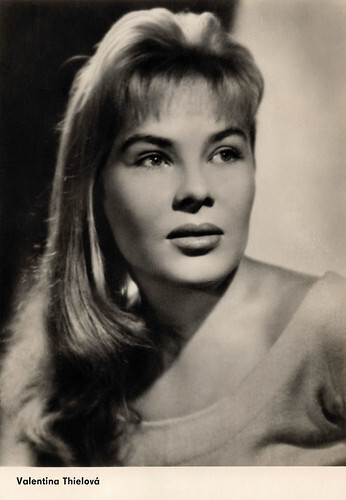
East German postcard by VEB Progress Film-Vertrieb, Berlin, no. 1405, 1961.
Unforgettable eyes full of temperament
Valentina Thielová was born Valentina Strachovová in 1933 in Prague, Czechoslovakia, now the Czech Republic. Her parents emigrated from Russia but met in Prague. There they had three children, Valentina was the middle one.
The Nazi occupation fatefully interfered with her family's life when her father, Grigory Mitrofanovich Strachov, was arrested by the Gestapo. Her mother worked as a seamstress and Valentina helped her with sewing. The family believed that her father had perished, but this was not the case. However, he did not return home after the war and went to Venezuela, where he started a new family and had a son, Gregory. In 1955, he emigrated to the USA and died in 1975 in Paterson (New Jersey).
In school, Valentina recited, and in high school, she also performed in amateur theatre. She had to abandon her dream of becoming a ballerina because of joint problems. She did not finish her studies in high school and started to work as a clerk.
Her first husband was the poet Vladimír Thiele, who introduced her to Prague's bohemian community. She got her first small opportunity in the cinema in the short film Something has changed (1955), in which she played a nurse. Her expressive face with her blonde hair and unforgettable eyes full of temperament opened the doors to her acting career.
By chance, she met the director Josef Mach at a congress of Czechoslovak writers. He cast her in one of the lead roles in his film Florenc 13.30/Florence 13.30 (Josef Mach, 1957) as the seductive Miriam alongside Josef Bek. Her film debut was an unexpected popular success.
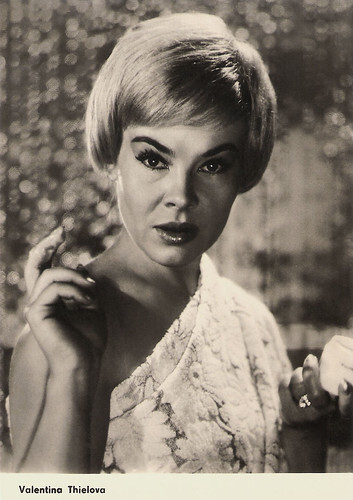
East German postcard by VEB Progress Film-Vertrieb, Berlin, no. 1885, 1963. Photo: DEFA / Blasig. Valentina Thielová in Das Stacheltier - Der Dieb von San Marengo/The Thief of Marengo (Günter Reisch, 1963).
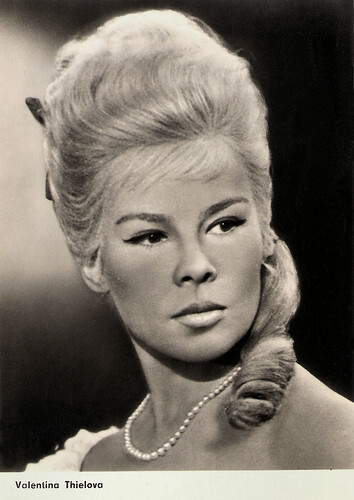
East German postcard by VEB Progress Film-Vertrieb, Berlin, no. 2.298, 1965. Valentina Thielová in Bláznova kronika/The Jester's Tale (Karel Zeman, 1964).
A flair for drama
This successful debut definitely launched Valentina Thielová's career as an actress. She became the emcee in the Laterna magika troupe, with which she participated in the World Expo 58 in Brussels.
Another success was Zizkovská romance/Suburban Romance (Zbynek Brynych, 1958) in which she played a divorced woman with an irresistible sex appeal. Other major film roles followed, both at home and abroad.
She showed a flair for drama in such distinguished films as Destivý den/Rainy Day (Jiri Belka, 1962), and Boxer a smrt/Boxer and Death (Peter Solan, 1962) with Stefan Kvietik and Manfred Krug . She then received an offer from the DEFA in East Germany to appear in Der Dieb von San Marengo/The Thief of San Marengo (Günter Reisch, 1963) with Horst Drinda.
Of the Czech films of the 1960s, her most artistically valuable roles were probably in the historical comedy Bláznova kronika/The Jester's Tale (Karel Zeman, 1964) and Transit Carlsbad (Zbyněk Brynych, 1966) in which she played the lead role of Madame Elisabeth. After 1968, her artistic possibilities were limited, mainly due to the political attitudes of her second husband, Arpad Vilcek, and she was forced to perform with various touring theatres and variety troupes.
She reunited with Josef Mach for the thriller Na kolejích ceká vrah/There's a killer waiting in the dorms (Josef Mach, 1970), but her role was small. Her next major film role came more than ten years later as Professor Bozhenka in the film Sněženky a machři/Snowdrops and Aces (Karel Smyczek, 1982), a Czech film comedy about a group of high school students learning to ski in the mountains. This was followed by a number of smaller roles in films and TV series, mainly in the roles of grandmothers.
Valentina Thielová passed away in 2022 in the Czech Republic at the age of 89.
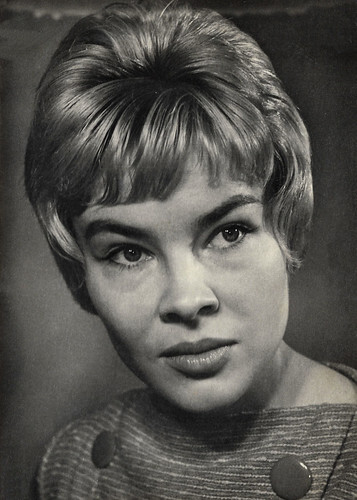
Big Czech postcard by Nakladatekstvi Orbis, Praha (Prague), no. F14-10147. Photo: V. Rosegnal.
Sources: Josef "tahit" B. (CSFD - Czech) Wikipedia (Czech and English) and .

East German postcard by VEB Progress Film-Vertrieb, Berlin, no. 1405, 1961.
Unforgettable eyes full of temperament
Valentina Thielová was born Valentina Strachovová in 1933 in Prague, Czechoslovakia, now the Czech Republic. Her parents emigrated from Russia but met in Prague. There they had three children, Valentina was the middle one.
The Nazi occupation fatefully interfered with her family's life when her father, Grigory Mitrofanovich Strachov, was arrested by the Gestapo. Her mother worked as a seamstress and Valentina helped her with sewing. The family believed that her father had perished, but this was not the case. However, he did not return home after the war and went to Venezuela, where he started a new family and had a son, Gregory. In 1955, he emigrated to the USA and died in 1975 in Paterson (New Jersey).
In school, Valentina recited, and in high school, she also performed in amateur theatre. She had to abandon her dream of becoming a ballerina because of joint problems. She did not finish her studies in high school and started to work as a clerk.
Her first husband was the poet Vladimír Thiele, who introduced her to Prague's bohemian community. She got her first small opportunity in the cinema in the short film Something has changed (1955), in which she played a nurse. Her expressive face with her blonde hair and unforgettable eyes full of temperament opened the doors to her acting career.
By chance, she met the director Josef Mach at a congress of Czechoslovak writers. He cast her in one of the lead roles in his film Florenc 13.30/Florence 13.30 (Josef Mach, 1957) as the seductive Miriam alongside Josef Bek. Her film debut was an unexpected popular success.

East German postcard by VEB Progress Film-Vertrieb, Berlin, no. 1885, 1963. Photo: DEFA / Blasig. Valentina Thielová in Das Stacheltier - Der Dieb von San Marengo/The Thief of Marengo (Günter Reisch, 1963).

East German postcard by VEB Progress Film-Vertrieb, Berlin, no. 2.298, 1965. Valentina Thielová in Bláznova kronika/The Jester's Tale (Karel Zeman, 1964).
A flair for drama
This successful debut definitely launched Valentina Thielová's career as an actress. She became the emcee in the Laterna magika troupe, with which she participated in the World Expo 58 in Brussels.
Another success was Zizkovská romance/Suburban Romance (Zbynek Brynych, 1958) in which she played a divorced woman with an irresistible sex appeal. Other major film roles followed, both at home and abroad.
She showed a flair for drama in such distinguished films as Destivý den/Rainy Day (Jiri Belka, 1962), and Boxer a smrt/Boxer and Death (Peter Solan, 1962) with Stefan Kvietik and Manfred Krug . She then received an offer from the DEFA in East Germany to appear in Der Dieb von San Marengo/The Thief of San Marengo (Günter Reisch, 1963) with Horst Drinda.
Of the Czech films of the 1960s, her most artistically valuable roles were probably in the historical comedy Bláznova kronika/The Jester's Tale (Karel Zeman, 1964) and Transit Carlsbad (Zbyněk Brynych, 1966) in which she played the lead role of Madame Elisabeth. After 1968, her artistic possibilities were limited, mainly due to the political attitudes of her second husband, Arpad Vilcek, and she was forced to perform with various touring theatres and variety troupes.
She reunited with Josef Mach for the thriller Na kolejích ceká vrah/There's a killer waiting in the dorms (Josef Mach, 1970), but her role was small. Her next major film role came more than ten years later as Professor Bozhenka in the film Sněženky a machři/Snowdrops and Aces (Karel Smyczek, 1982), a Czech film comedy about a group of high school students learning to ski in the mountains. This was followed by a number of smaller roles in films and TV series, mainly in the roles of grandmothers.
Valentina Thielová passed away in 2022 in the Czech Republic at the age of 89.

Big Czech postcard by Nakladatekstvi Orbis, Praha (Prague), no. F14-10147. Photo: V. Rosegnal.
Sources: Josef "tahit" B. (CSFD - Czech) Wikipedia (Czech and English) and .
Published on January 02, 2023 22:00
January 1, 2023
Dani
French actress and singer Dani (1944-2022) started her career as a mannequin and nightclub singer. She became known for her role as the scriptgirl Lilliane in François Truffaut's La nuit américaine/Day for Night (1973) and L'amour en fuite/Love on the Run (1979).
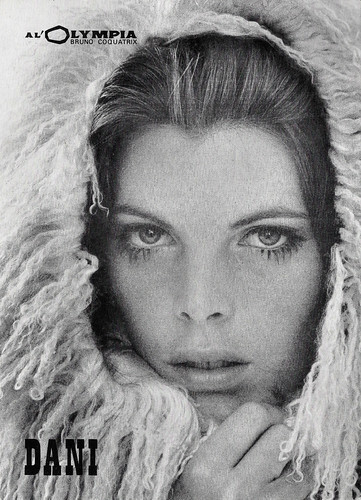
French promotion card by Olympia, Bruno Coquatrix.
La nuit américaine
Dani was the stage name of Danièle Graule, initially listed as Dany Graule. She was born in 1944 in Castres, Tarn, France. She was the eldest of three children. Her father was a shoemaker and her mother, of Catalan origin, was a shoe saleswoman.
In 1963, at the age of 19, she left Perpignan to attend the École des Beaux-Arts in Paris. She was hired by the newspaper Jours de France to take photos and began a career as a model with Catherine Harlé's agency. She attended fashionable parties at the Café de Flore, La Rhumerie, Castel and the Publicis drugstore. She met Zouzou and Jimi Hendrix at a festival in Juan-les-Pins, posed for Jacques Séguéla on the cover of L'Express and got involved with Benjamin Auger, a photographer from Salut les copains.
In 1965, she appeared in the video clip for the hit 'Tout se passe dans les yeux' performed by Dick Rivers . In 1966 she was contracted to Pathé-Marconi and released her first single 'Garçon manqué' (Tomboy). In 1968 her song 'Papa vient d'épouser la bonne' (Daddy just married the maid) sold a million copies and was a major hit.
She made her film debut with a small role in La ronde/Circle of Love (Roger Vadim, 1964) with Jane Fonda . Roles followed in such films as La fille d'en face/The Girl Across the Way (Jean-Daniel Simon, 1968), Delphine (Eric Le Hung, 1969) with Dany Carrel , and Tumuc Humac (Jean-Marie Périer, 1971) opposite Marc Porel .
She had her breakthrough in the cinema when she played the script-girl Liliane in François Truffaut 's La nuit américaine/Day for Night (1974). Liliane is the fickle girlfriend of actor Alphonse ( Jean-Pierre Léaud ) who is recruited as a script trainee, but she is pinching for the English stuntman. In 1978, this Liliane became the friend of Christine Doinel alias Claude Jade in the final film of the Antoine Doinel cycle, L'amour en fuite/Love on the Run (1979). Later, she has an affair with her friend's husband Antoine, again Jean-Pierre Léaud . Thanks to the installation of new and old scenes, Claude Jade also mounted in the flashbacks of Day for Night, it seems Dani was already part of the Doinel Cycle.
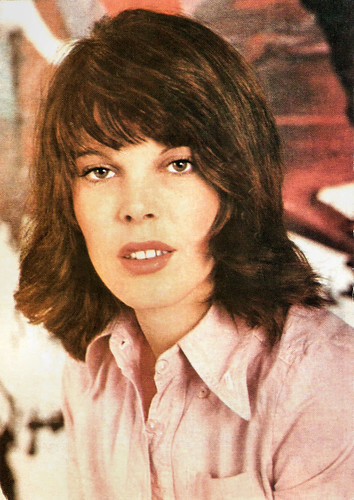
Romanian postcard by Casa Filmului Acin.
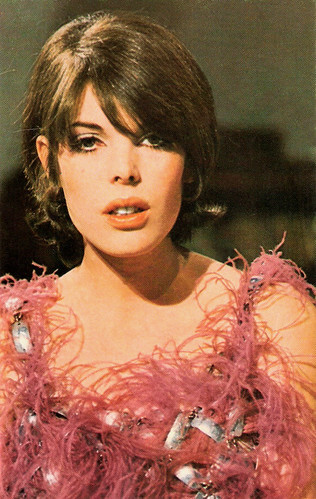
French postcard by Corvisart, Epinal.
Her dark years and her resurrection
Dani was topbilled in Quelques messieurs trop tranquilles/Some Too Quiet Gentlemen (Georges Lautner, 1973), and appeared opposite Les Charlots in Et vive la liberté!/And Long Live Liberty (Serge Korber, 1978). In 1974, she was to represent France in the Eurovision Song Contest with the song 'La Vie a 25 ans' (Life at 25), written by Christine Fontane, but the entry was withdrawn due to the death of President Georges Pompidou in the week of the competition.
Her only English language record release to date was 'That Old Familiar Feeling', which had the same music as 'La Vie à 25 ans' but with English lyrics by British singer-songwriter Lynsey de Paul. In 1975, Dani was again offered Eurovision. She imposed Serge Gainsbourg as her songwriter, who wrote and composed the song 'Comme un boomerang' (Like a Boomerang). However, her application was rejected because Antenne 2 considered some of the lyrics unsuitable for the contest. Dani and Gainsbourg, not wanting to change the song or even certain passages, withdrew.
Dani opened L'Aventure, a trendy nightclub in Paris, a mythical place that made her the muse of Parisian nights until the early 1980s. Having retired to her house in the Vaucluse, she published the book 'Drogue, la galère' in 1987, in which she recounts her dark years and her resurrection. Throughout her career, Dani rarely appeared on stage or in the cinema. She mostly worked in her flower shops.
Dani's later films included Une affaire de femmes/A Story of Women (Claude Chabrol, 1988) starring Isabelle Huppert , J'ai pas sommeil/I can't sleep (Claire Denis, 1994), and À mort la mort!/Death to death! (Romain Goupil, 1999). In the new century, she had her biggest hit song with 'Comme un boomerang', the song written in 1975 by Serge Gainsbourg . She re-recorded it as a duet with Étienne Daho in 2001.
In the cinema, she appeared in supporting roles in Violence des échanges en milieu tempéré/Work Hard, Play Hard! (Jean-Marc Moutout, 2003) with Jérémie Renier, Les clefs de bagnole/The Car Keys (Laurent Baffie, 2003), Fauteuils d'orchestre/Orchestra Seats (Danièle Thompson, 2006), and Parlez-moi de vous/On Air (Pierre Pinaud, 2012) starring Karin Viard. For her part in Fauteuils d'orchestre, Dani was nominated for a César award for the Best Supporting Actress.
In the last decade, she played parts in such films as Mon roi/My King (Maïwenn, 2015) starring Vincent Cassel, Carbone/Carbon (Olivier Marchal, 2017), Guy (Alex Lutz, 2018) and Bronx (Olivier Marchal, 2020), her final film. In 2016, she published another autobiography, 'La nuit ne dure pas'. Last year, in 2022, Dani died in her home in Tours, following a heart attack. She was 77. Dani had a son, Julien (born 1969) from her union with photographer Benjamin Auger, whom she met in 1964. She also raised Benjamin Auger's eldest son Emmanuel (1964). After twenty years together, the couple separated without divorcing in the mid-1980s.
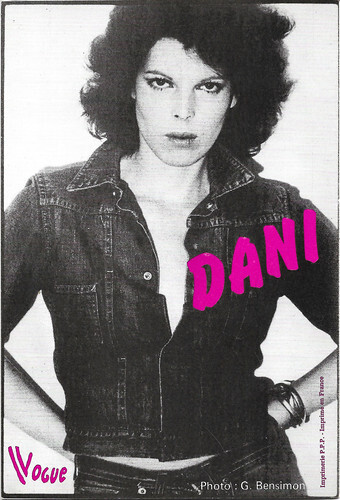
French promotion card by Vogue. Photo: G. Bensimon.
Sources: Hans Beerekamp (Het Schimmenrijk - Dutch), Wikipedia (French), and .

French promotion card by Olympia, Bruno Coquatrix.
La nuit américaine
Dani was the stage name of Danièle Graule, initially listed as Dany Graule. She was born in 1944 in Castres, Tarn, France. She was the eldest of three children. Her father was a shoemaker and her mother, of Catalan origin, was a shoe saleswoman.
In 1963, at the age of 19, she left Perpignan to attend the École des Beaux-Arts in Paris. She was hired by the newspaper Jours de France to take photos and began a career as a model with Catherine Harlé's agency. She attended fashionable parties at the Café de Flore, La Rhumerie, Castel and the Publicis drugstore. She met Zouzou and Jimi Hendrix at a festival in Juan-les-Pins, posed for Jacques Séguéla on the cover of L'Express and got involved with Benjamin Auger, a photographer from Salut les copains.
In 1965, she appeared in the video clip for the hit 'Tout se passe dans les yeux' performed by Dick Rivers . In 1966 she was contracted to Pathé-Marconi and released her first single 'Garçon manqué' (Tomboy). In 1968 her song 'Papa vient d'épouser la bonne' (Daddy just married the maid) sold a million copies and was a major hit.
She made her film debut with a small role in La ronde/Circle of Love (Roger Vadim, 1964) with Jane Fonda . Roles followed in such films as La fille d'en face/The Girl Across the Way (Jean-Daniel Simon, 1968), Delphine (Eric Le Hung, 1969) with Dany Carrel , and Tumuc Humac (Jean-Marie Périer, 1971) opposite Marc Porel .
She had her breakthrough in the cinema when she played the script-girl Liliane in François Truffaut 's La nuit américaine/Day for Night (1974). Liliane is the fickle girlfriend of actor Alphonse ( Jean-Pierre Léaud ) who is recruited as a script trainee, but she is pinching for the English stuntman. In 1978, this Liliane became the friend of Christine Doinel alias Claude Jade in the final film of the Antoine Doinel cycle, L'amour en fuite/Love on the Run (1979). Later, she has an affair with her friend's husband Antoine, again Jean-Pierre Léaud . Thanks to the installation of new and old scenes, Claude Jade also mounted in the flashbacks of Day for Night, it seems Dani was already part of the Doinel Cycle.

Romanian postcard by Casa Filmului Acin.

French postcard by Corvisart, Epinal.
Her dark years and her resurrection
Dani was topbilled in Quelques messieurs trop tranquilles/Some Too Quiet Gentlemen (Georges Lautner, 1973), and appeared opposite Les Charlots in Et vive la liberté!/And Long Live Liberty (Serge Korber, 1978). In 1974, she was to represent France in the Eurovision Song Contest with the song 'La Vie a 25 ans' (Life at 25), written by Christine Fontane, but the entry was withdrawn due to the death of President Georges Pompidou in the week of the competition.
Her only English language record release to date was 'That Old Familiar Feeling', which had the same music as 'La Vie à 25 ans' but with English lyrics by British singer-songwriter Lynsey de Paul. In 1975, Dani was again offered Eurovision. She imposed Serge Gainsbourg as her songwriter, who wrote and composed the song 'Comme un boomerang' (Like a Boomerang). However, her application was rejected because Antenne 2 considered some of the lyrics unsuitable for the contest. Dani and Gainsbourg, not wanting to change the song or even certain passages, withdrew.
Dani opened L'Aventure, a trendy nightclub in Paris, a mythical place that made her the muse of Parisian nights until the early 1980s. Having retired to her house in the Vaucluse, she published the book 'Drogue, la galère' in 1987, in which she recounts her dark years and her resurrection. Throughout her career, Dani rarely appeared on stage or in the cinema. She mostly worked in her flower shops.
Dani's later films included Une affaire de femmes/A Story of Women (Claude Chabrol, 1988) starring Isabelle Huppert , J'ai pas sommeil/I can't sleep (Claire Denis, 1994), and À mort la mort!/Death to death! (Romain Goupil, 1999). In the new century, she had her biggest hit song with 'Comme un boomerang', the song written in 1975 by Serge Gainsbourg . She re-recorded it as a duet with Étienne Daho in 2001.
In the cinema, she appeared in supporting roles in Violence des échanges en milieu tempéré/Work Hard, Play Hard! (Jean-Marc Moutout, 2003) with Jérémie Renier, Les clefs de bagnole/The Car Keys (Laurent Baffie, 2003), Fauteuils d'orchestre/Orchestra Seats (Danièle Thompson, 2006), and Parlez-moi de vous/On Air (Pierre Pinaud, 2012) starring Karin Viard. For her part in Fauteuils d'orchestre, Dani was nominated for a César award for the Best Supporting Actress.
In the last decade, she played parts in such films as Mon roi/My King (Maïwenn, 2015) starring Vincent Cassel, Carbone/Carbon (Olivier Marchal, 2017), Guy (Alex Lutz, 2018) and Bronx (Olivier Marchal, 2020), her final film. In 2016, she published another autobiography, 'La nuit ne dure pas'. Last year, in 2022, Dani died in her home in Tours, following a heart attack. She was 77. Dani had a son, Julien (born 1969) from her union with photographer Benjamin Auger, whom she met in 1964. She also raised Benjamin Auger's eldest son Emmanuel (1964). After twenty years together, the couple separated without divorcing in the mid-1980s.

French promotion card by Vogue. Photo: G. Bensimon.
Sources: Hans Beerekamp (Het Schimmenrijk - Dutch), Wikipedia (French), and .
Published on January 01, 2023 22:00
December 31, 2022
Stars who passed away in 2022
On the first day of 2023, EFSP remembers the stars of the international cinema we had to say farewell to in 2022. Thank you, for your films and postcards. We salute you!
7 January 2022: Sidney Poitier (1927-2022)
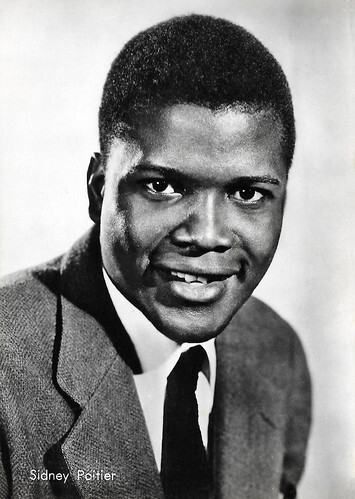
Italian postcard by Bromostampa, Milano, no. 267.
Sidney Poitier (1927) was a Bahamian-American actor, film director, activist, and ambassador. He was one of the last surviving stars from the Golden Age of Hollywood. In 1964, Poitier won the Oscar for Best Actor becoming the first black male and Bahamian actor to win that award. In 1955, he had his breakthrough as a high school student in Blackboard Jungle (1955). In 1958, Poitier starred with Tony Curtis as chained-together escaped convicts in The Defiant Ones, for which he received a nomination for Best Actor - the first for a black actor. In 1964, he won the Academy Award and the Golden Globe for Lilies of the Field (1963). He continued to break ground in such films as Guess Who's Coming to Dinner (1967) and In the Heat of the Night (1967). Poitier was 94.
13 January 2022: Jean-Jacques Beineix (1946-2022)
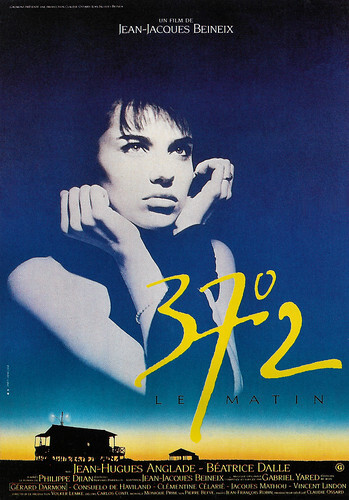
French postcard by Editions F. Nugeron, no. E 309. Image: French film poster for 37°2 le matin/Betty Blue (Jean-Jacques Beineix, 1986).
French director, screenwriter and producer Jean-Jacques Beineix (1946) had his breakthrough with his first feature film. The psychological thriller Diva (1980), about a young postman obsessed with an opera diva, received four Césars. An even bigger success was his third film, 37°2 le matin/Betty Blue (1986). The erotic drama was nominated for the best foreign-language film at the Oscars and became the eighth highest-grossing film of the year in France. Beineix, who suffered from leukaemia was 75.
16 January 2022: Carmela Corren (1938-2022)
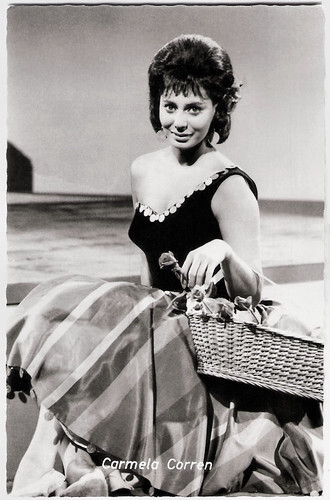
West-German postcard by Kolibri-Verlag G.m.b.H., Minden/Westf., no. 1658.
Israeli-born singer and actress Carmela Corren (1938-2022) represented Austria at the Eurovision Song Contest 1963 with her song 'Vielleicht Geschieht Ein Wunder'. In the early 1960s, she starred in several Schlager- and Heimatfilms in Austria end Germany. After retiring, Corren lived in Florida. She was 83.
17 January 2022: Michel Subor (1935-2022)
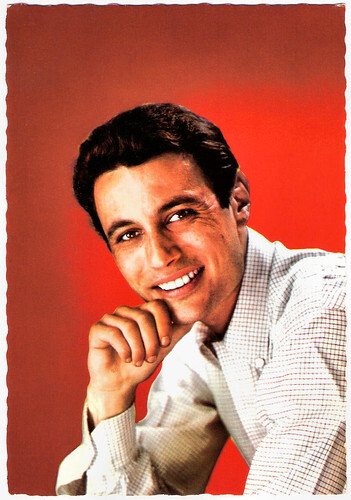
French postcard by E.D.U.G., no. 164. Photo: Sam Lévin.
French actor Michel Subor gained initial fame with the starring role in Jean-Luc Godard's second feature, Le Petit Soldat (1960). He acted in a couple of American films, including Alfred Hitchcock's Topaz (1969) as Claude Jade's husband. In 1999, he played Forestier in Beau Travail, a highly praised variation of Billy Budd, directed by Claire Denis. He continued to work with her. Subor was 86.
18 January 2022: Yvette Mimieux (1942-2022)
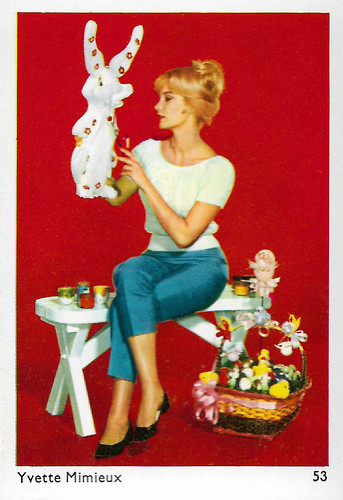
West-German collectors card, no. 53.
American actress and writer Yvette Mimieux (1942) died from natural causes at her home in Los Angeles. She was known for The Time Machine (1960), and several other popular films of the 1960s. Mimieux was nominated for three Golden Globe awards during her acting career. She passed away overnight in her sleep at the age of 80.
19 January 2022: Gaspard Ulliel (1984-2022)
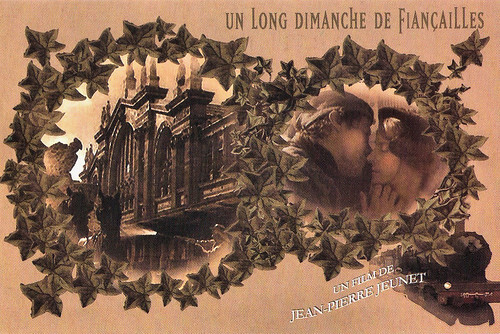
French postcard by Warner Bros, France / Tapioca Films / TF1 Films Production. Gaspard Ulliel and Audrey Tautou on the English poster for Un long dimanche de fiançailles/A Very Long Engagement (Jean-Pierre Jeunet, 2004).
French actor Gaspard Ulliel (1984) died in Grenoble, France. The Cesar-winning star of Un long dimanche de fiançailles/A Very Long Engagement (2004) and Hannibal Rising (2007) was involved in a skiing accident in the Alps. He was only 37.
19 January: Hardy Krüger (1928–2022)
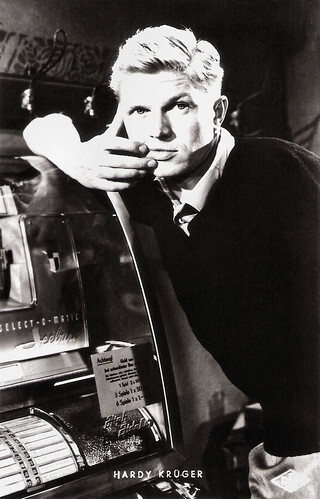
West-German postcard by Netter's Star Verlag, Berlin, no. 1256.
German actor and writer Hardy Krüger (1928) was a blond heartthrob in numerous European films of the 1950s and 1960s. He also played in several classic American films. He played friendly soldiers and adventurers in numerous German, British and French films and also in some Hollywood classics. Although he often was typecasted as the Aryan Nazi, he hated wearing the brown uniform. Krüger was 93.
21 January 2022: Joyce Holden (1930-2022)
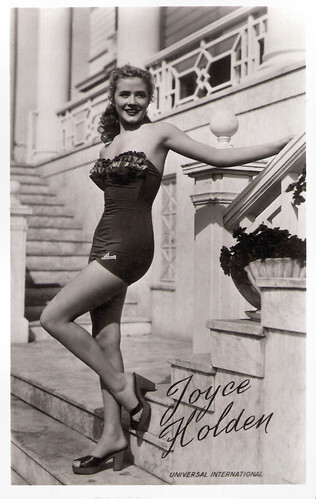
Dutch postcard, no. 587. Photo: Universal International.
Joyce Holden was a beautiful Hollywood starlet in B-films and TV productions of the 1950s. She played a 'delinquent daughter' in the crime drama Girls in the Night (1953), a femme fatale with a mink in the comedy Private Eyes (1953) and the lady-in-distress in the horror film The Werewolf (1956). In 1958, she married and retired. As a Jehovah’s Witness, she knocked on front doors to deliver her sermon: "Christ went from city to city, from door to door, preaching his way."
25 January: Etchika Choureau (1929-2022)
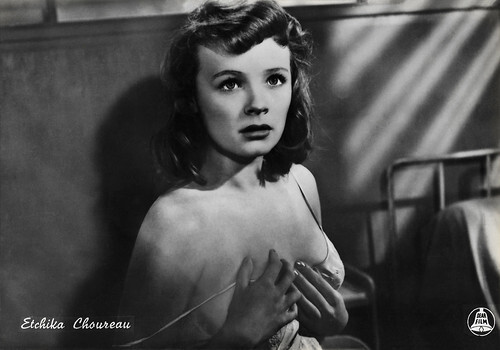
Italian postcard by Bromofoto, Milano, no. 947. Photo: Dear Film. Etchika Choureau in Les Enfants de l'amour/Children of Love (Léonide Moguy, 1953).
French actress Etchika Choureau 's film career started very promisingly with three films and an award in 1953. During the 1950s, the beauty with green eyes and long blond hair graced films in France, Germany, Italy, and Hollywood. After a long affair with the Crown prince of Morocco, she tried to make a come-back but failed and retired. She died at the age of 92.
2 February 2022: Monica Vitti (1931-2022)
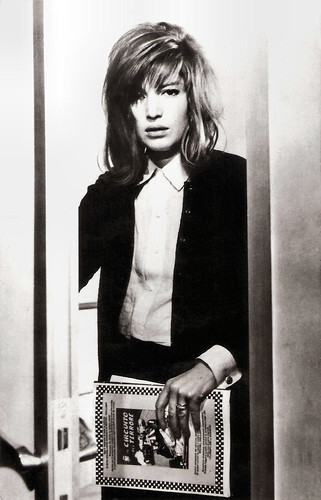
Romanian postcard by Casa Filmuluii Acin, no. 467. Monica Vitti in Ridere! Ridere! Ridere!/Laugh! Laugh! Laugh! (Edoardo Anton, 1954).
Legendary Italian actress Monica Vitti passed away in Rome at the age of 90. She was most widely noted in the early 1960s for her starring roles in four classic avant-garde films directed by Michelangelo Antonioni. Later the glamorous blonde became the queen of the 'Commedia all’Italiana', a film genre previously restricted to men.
27 February 2022: Veronica Carlson (1944-2022)
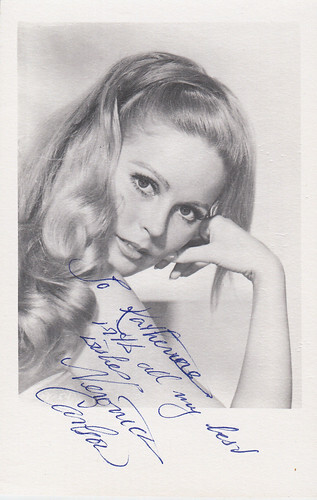
Vintage autographed card. Collection: Marlene Pilaete.
Striking, pale-complexioned, blonde English actress Veronica Carlson was known as the female lead of several late 1960s Hammer horror films, including the hapless Maria being terrorised by fanged Christopher Lee in Dracula Has Risen from the Grave (1968), brutalised by the evil Peter Cushing in Frankenstein Must Be Destroyed (1969) and chased by monster David Prowse in The Horror of Frankenstein (1970).
13 March 2022: William Hurt (1950-2022)
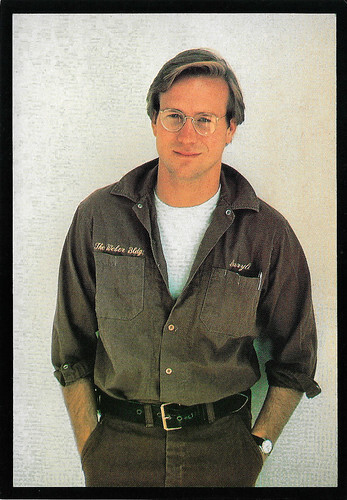
French postcard by Humour a la carte, Paris, no. ST 156.
American actor William Hurt died at the age of 71. Hurt started out as a stage actor and his career as a film actor lasted more than forty years. In the early 1980s, he starred in the brooding Film Noir Body Heat (1981), the midlife drama The Big Chill (1983) and Children of a Lesser God (1986), about a teacher at a school for the deaf. In the 1980s, Hurt was nominated for an Oscar for best actor three times in a row. He won it in 1985 for his role in Kiss of the Spider Woman (1985). In 2005, he was nominated for the fourth time, for the film A History of Violence (2005). In later years, Hurt played General Thaddeus Ross in five Marvel superhero films.
21 March 2022: Eva Ingeborg Scholz (1928-2022)
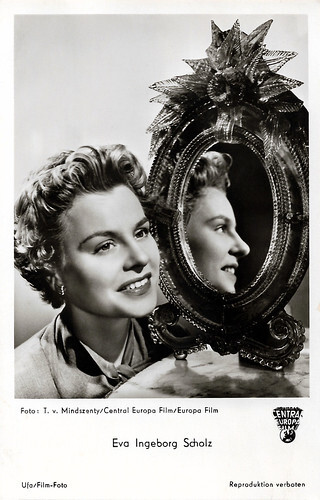
West-German postcard by Ufa/Film-Foto, Berlin-Tempelhof, no. 1652. Photo: T. v. Mindszenty / Central Europa Film / Europa Film. Eva Ingeborg Scholz in Ball im Savoy/Ball at the Savoy (Paul Martin, 1955).
German film and television actress Eva Ingeborg Scholz passed away at the age of 94. Since her East-German debut in 1948, she played in more than 110 film and television productions.
5 April 2022: Bobby Rydell (1942-2022)
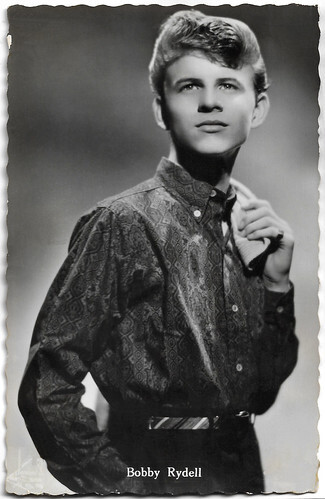
Dutch postcard by N.V. v.h. Weenenk & Snel, Baarn.
American singer and actor Bobby Rydell passed away at 79. The teen idol had big hits like 'Kissin' Time' (1959), 'Wild One' (1960), 'Forget Him' (1963), and the English cover version of 'Volare' (1960). Rydell also starred in some films of the early 1960s.
17 April 2022: Catherine Spaak (1945-2022)

Italian postcard by Rotalfoto (Rotalcolor), Milano, no. 244.
French actress and singer Catherine Spaak appeared in some 100 films. She started as a Lolita-like vamp in Italian films of the early 1960s, made records and became a teenage star. Later, she played in several classic Italian comedies and was a popular TV host.
21 April 2022: Jacques Perrin (1941-2022)
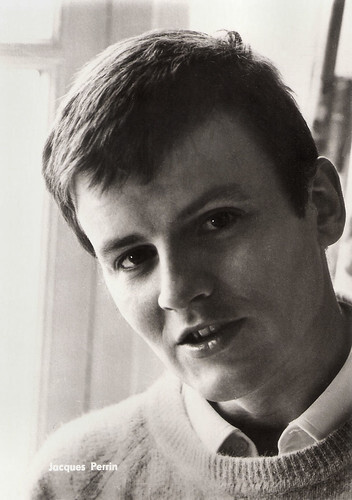
East-German postcard by Progress Film-Vertrieb, Berlin, no 3263, 1963.
Jacques Perrin (1941-2022) was a handsome and talented French actor who started his career as the romantic hero in the films of Italian director Valerio Zurlini. Later he made powerful films with Costa-Gravas and played the adult Salvatore in the international hit Cinema Paradiso (1988). With his own studio, he produced successful political films such as Z (1969) and nature documentaries such as Microcosmos (1996).
21 April 2022: Renate Holm (1931-2022)
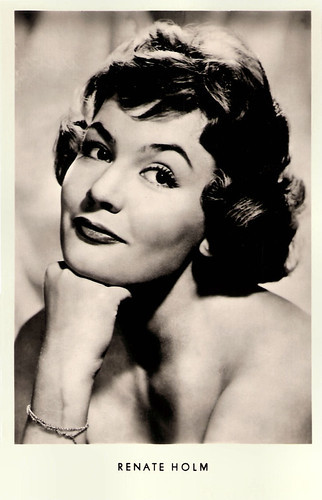
East-German postcard by VEB Volkskunstverlag Reichenbach I.V., no. G 740, 1957. Retail price: 0,15 DM. Photo: Teldec.
Renate Holm (1931-2022) was a German-Austrian film actress and operatic soprano. During the 1950s she was a popular star of Schlager films and operettas. In the 1960s, she became a star at the Vienna State Opera under the direction of Herbert von Karajan.
1 May 2022: Régine (1929-2022)
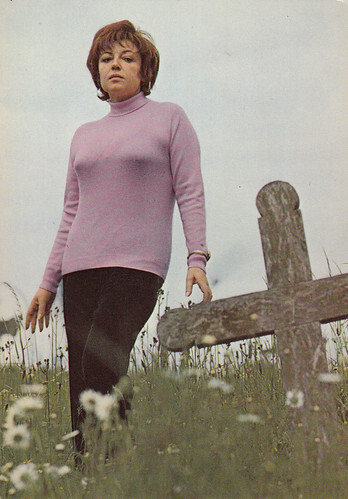
French postcard by Editions Lyna, Paris, no. 2010. Photo: Tony Frank. Collection: Marlene Pilaete.
Régine was a French singer, actress and nightclub impresario. Born in Belgium to Polish Jewish parents, she started life hiding from the Nazis in occupied wartime France. After the war, Régine became a torch singer and by 1953 was a nightclub manager in Paris. In 1957, she opened Chez Régine in the Latin Quarter, which became the place to be seen for visiting celebrities, socialites and royalty. As her celebrity expanded she established other venues under the name Chez Régine's in London, New York City, Monte Carlo and elsewhere, all featuring her signature "disco-style" layout. She dubbed herself the "Queen of the Night" and had a hit single with the French version of Gloria Gaynor's 'I will survive'. She had supporting parts in such films as Le couteau dans la plaie/Five Miles to Midnight (1962) and The Seven-Per-Cent Solution (1976).
10 May 2022: Joanna Barnes (1934-2022)
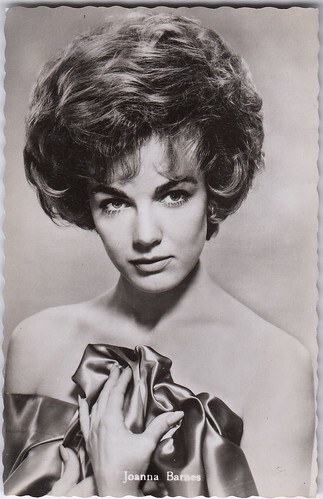
Dutch postcard by Uitgave “Emdeeha” de Hond Oosterbeek, no. 16. Collection: Marlene Pilaete.
American actress, novelist and journalist Joanna Barnes had roles in more than twenty films, including Spartacus (1960) and The Parent Trap (1961) and made guest appearances on many television shows, including Have Gun - Will Travel (1957), Maverick (1957) and Fantasy Island (1978-1979).
14 May 2022: Robert Cogoi (1939-2022)
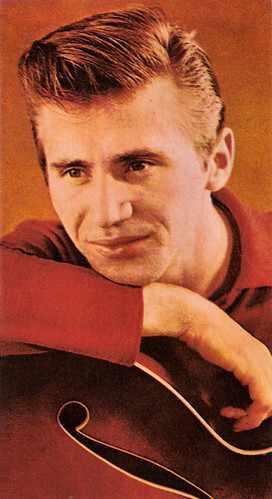
Belgian postcard by S. Best, Antwerp, for Victoria, no. 14.
One day after the Eurovision Song Contest in Turin, Belgian singer Robert Cogoi passed away. He represented his country in the 1964 Eurovision Song Contest. In the 1960s, Cogoi was one of the most popular Walloon singers, together with Salvatore Adamo.
17 May 2022: María Duval (1926-2022)
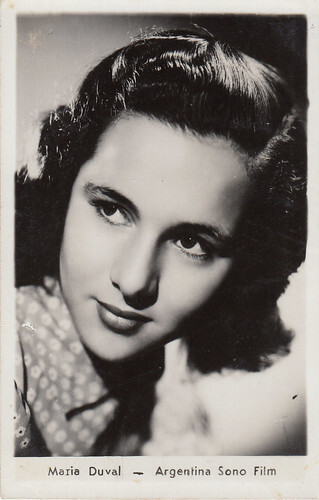
Argentinian postcard by Argentina Sono Film. Collection: Marlene Pilaete.
Argentinian actress María Duval known for such films as Casi un sueño (1943), Milagro de amor (1946) and La serpiente de cascabel (1948). She was previously married to Joseph Grosman.
17 June 2022: Jean-Louis Trintignant (1930-2022)
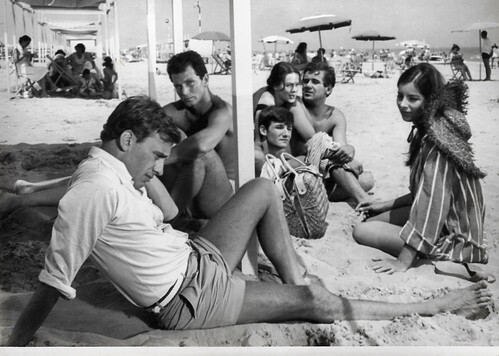
Vintage press photo. Jean-Louis Trintignant and Jacqueline Sassard in Estate violenta/Violent Summer (Valerio Zurlini, 1959).
Jean-Louis Trintignant (1930-2022) was one of the most gifted French actors of the post-war era. He starred in more than 100 films and enjoyed international acclaim with films like Et Dieu... créa la femme/And God Created Woman (1956), Un homme et une femme/A Man And A Woman (1966), Z (1969) and Il Conformista/The Conformist (1970 ). He showed a special talent for dark characters like murderers or jealous husbands and won several awards for it. Trintignant passed away on 17 June 2022 in Uzès. He was 91.
20 June 2022: Regimantas Adomaitis (1937-2022)
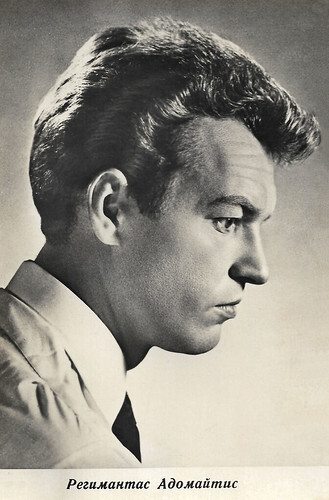
Soviet-Russian postcard by Izdanije Byuro Propogandy Sovietskogo Kinoiskusstva, no. M-31293 9/IV-68. This postcard was printed in an edition of 150,000 cards. The retail price was 8 kop.
Lithuanian film and stage actor Regimantas Adomaitis (1937) was particularly active in Soviet and East German cinema, for example in Korol Lir/King Lear (1970) and Jeto sladkoje slovo - svoboda!//That Sweet Word: Liberty! (1972).
23 June 2022: Ernst Jacobi (1933-2022)
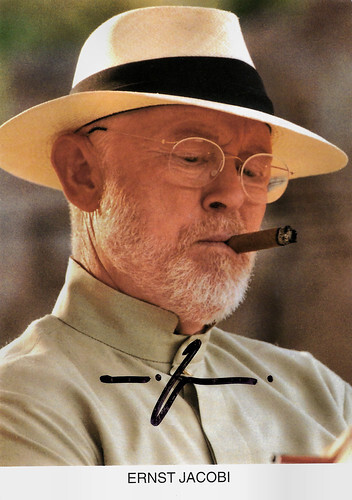
West-German postcard by Franz Josef Rüdel, Filmpostkartenverlag, Hamburg. Photo: Christian Kohlund, München (Munich).
On 23 June 2022, German actor and writer Ernst Jacobi (1933) passed away in Vienna, Austria at the age of 88. He was a character actor best known for the acclaimed films Volker Schlöndorf's Die Blechtrommel/The Tin Drum (1979) and Michael Haneke's Das weiße Band/The White Ribbon (2009). He was also the German voice of Peter Pan.
6 July 2022: James Caan (1940-2022)
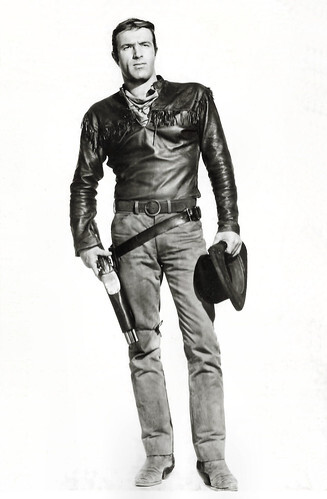
Romanian postcard by Casa Filmului Acin, no. 212. James Caan in El Dorado (Howard Hawks, 1967).
American actor James Caan (1940) was best known for his role as Sonny Corleone in Francis Ford Coppola's classic The Godfather (1972), for which he received an Oscar nomination. Caan was 82.
18 July 2022: Dani (1944-2022)

French postcard by Corvisart, Epinal.
French actress and singer Dani (1944) started her career as a mannequin and nightclub singer. She became known for her role as the scriptgirl Lilliane in François Truffaut's La nuit américaine/Day for Night (1973) and L'amour en fuite/Love on the Run (1979). Dani was 77.
20 July 2022: Nichelle Nichols (1932-2022)

West-German postcard by Xtreme, Wuppertal, no. 32733. Nichelle Nichols with DeForest Kelley, William Shatner and Leonard Nimoy in the TV series Star Trek (1966-1969).
American actress Nichelle Nichols (1932) passed away in Silver City. We remember her as Lieutenant Nyota Uhura in the space adventure TV series Star Trek (1966-1969). The lieutenant on the bridge of Starship Enterprise was a groundbreaking example of representation for Black Americans in Hollywood. She also played Uhura in the first six Star Trek feature films, that continue the adventures of the cast of the original series.
29 July 2022: Janine van Wely (1937)
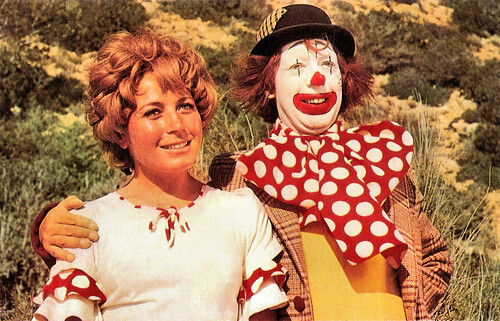
Dutch collectors card by Bros, Bensdorp N.V., Bussum. Janine van Wely as Mammaloe and Cees van Ooyen as Pipo in the TV series Pipo op Bizarra/Pipo on Bizarra (1971).
Dutch actress and artist Janine van Wely (1937) acted in Dutch films and such classic TV series as Pipo de Clown. She was 84.
4 August 2022: Margot Eskens (1936-2022)
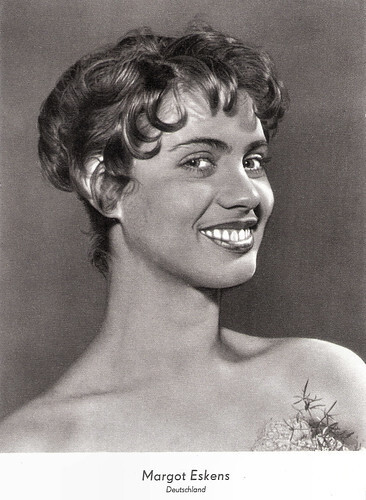
German card.
German schlager singer Margot Eskens (1936) achieved her success mainly in the 1950s and 1960s and represented Germany in 1966 in the Eurovision Song Contest. She also appeared in the film Auf Wiedersehn (1961).
6 August 2022: Carlo Bonomi (1937-2022)
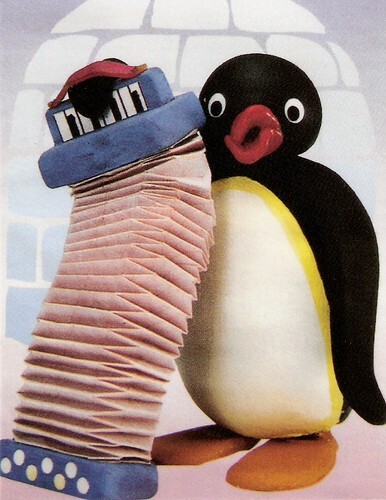
Dutch postcard. Caption: Pingu with accordion.
Carlo Bonomi (1937) died in Milan, Italy at the age of 85. He was an Italian voice actor and clown who was known for his voiceover work as the voice of Pingu as well as various other characters in the stop-motion children's television series of the same name. He also gave his voice to Mr. Linea in the classic animated series La Linea.
8 August 2022: Olivia Newton-John (1948-2022)
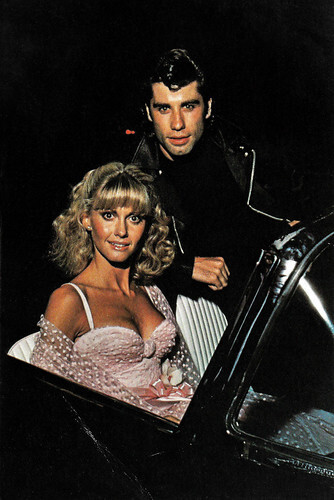
French postcard by Star, Paris, in the Collection John Travolta. John Travolta and Olivia Newton-John in Grease (Randal Kleiser, 1978).
British-Australian singer and actress Olivia Newton-John (1948) passed away at the age of 73. She was best known for the musical film Grease (1978). Olivia had been suffering from breast cancer for some time. She died at her home in California in the presence of her family and friends.
16 August 2022: Eva-Maria Hagen (1934-2022)
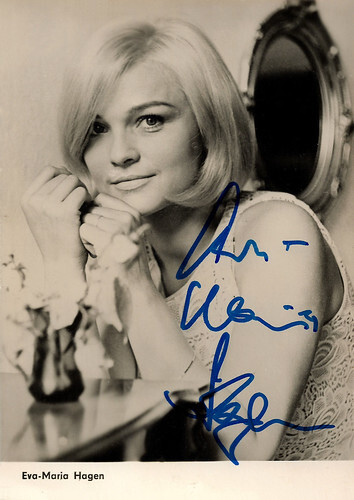
East-German postcard by VEB Progress Film-Vertrieb, Berlin, no. 3092, 1968. Photo: Schwarz / DEFA.
The German actress Eva-Maria Hagen died at the age of 87. From 1957 to 1965 she appeared in some 50 films and TV productions and became known as 'East Germany’s Brigitte Bardot'. Her daughter, the well-known singer Nina Hagen, and two of her grandchildren told the German newspaper Bild on Friday. It is not known how she died. Eva-Maria Hagen was also a well-known singer, painter and author.
7 September 2022: Marsha Hunt (1917-2022)
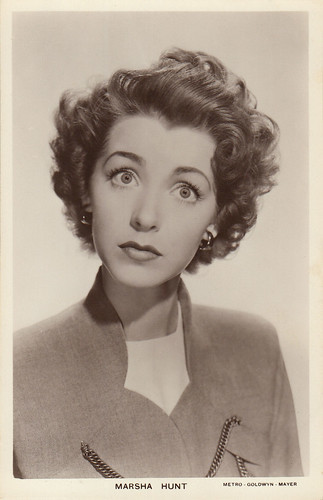
British postcard in the Picturegoer Series, no. W105. Photo: Metro-Goldwyn-Mayer. Collection: Marlene Pilaete.
American retired actress, model, and activist Marsha Hunt had a career spanning 73 years and appeared in many popular films including Pride and Prejudice (1940), Blossoms in the Dust (1942), Cry 'Havoc' (1943), The Human Comedy (1943), and Raw Deal (1948). She was blacklisted by Hollywood film studio executives in the 1950s during McCarthyism. In her later years, she has aided homeless shelters, supported same-sex marriage, raised awareness of climate change, and promoted peace in Third World countries.
13 September 2022: Jean-Luc Godard (1930-2022)
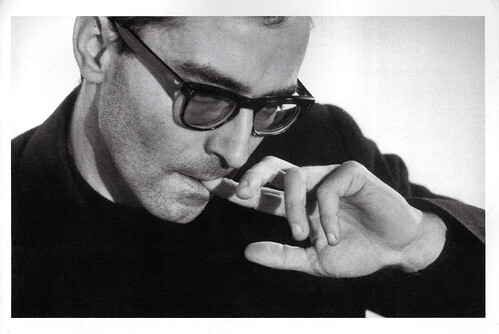
French postcard by La Cinémathèque française. Photo: Georges Pierre. Caption: Jean-Luc Godard , photo of the shooting of Pierrot le Fou, 1965.
French film director and screenwriter Jean-Luc Godard (1930) was one of the most important members of the Nouvelle Vague (New Wave). Godard first received global acclaim for his feature À bout de souffle/Breathless (1959), helping to establish the New Wave movement. Godard's films have inspired many directors including Martin Scorsese, Quentin Tarantino, Robert Altman, Rainer Werner Fassbinder, and Wong Kar-wai. He has been married twice, to actresses Anna Karina and Anne Wiazemsky, both of whom starred in several of his films.
14 September 2022: Irene Papas (1926-2022)
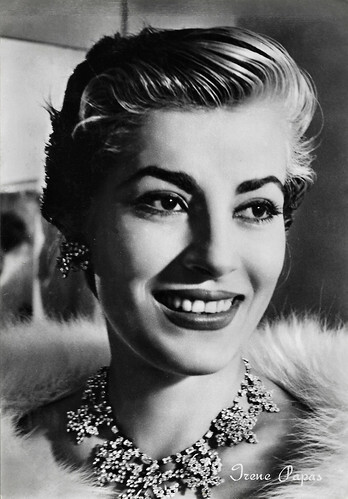
Italian postcard by Rotalfoto, Milano, no. 142. Photo: Ponti - De Laurentiis. Irene Papas in Le infedeli/The Unfaithfuls (Mario Monicelli, Steno, 1953).
Greek actress of international fame, Irene Papas (1926) passed away at the age of 96. In a career spanning more than fifty years, she starred in over seventy films, including such classics as The Guns of Navarone (1961) and Zorba the Greek (1964). Papas also portrayed ancient Greek heroines in Antigoni/Antigone(1961), Ilektra/Electra (1962), Helen in The Trojan Women (1972), and Clytemnestra in Iphigenia (1977).
15 September 2022: Diana Maggi (1925-2022)
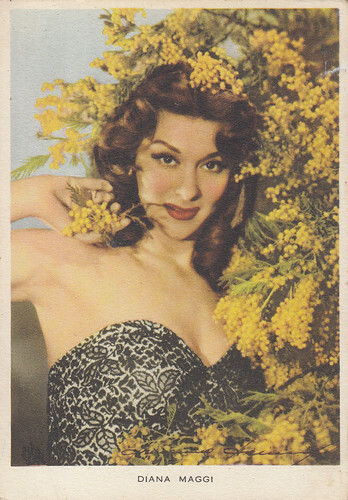
Argentinian postcard by Cromocart G.W., no. A10. Collection: Marlene Pilaete.
Volcanic redhead Diana Maggi was born in Italy and raised in Argentina. Her secondary rol in Luis César Amadori's Nacha Regules (1950) was acclaimed and, in the 1950s, she starred mostly in dramatic films in Argentina and was directed by Leopoldo Torre Nilsson. After a brief stay in Spain, in the early 1960s she returned to Buenos Aires, starting a successful career as comic actress. From early 1970s, she was married to actor Juan Carlos Dual.
26 September 2022: Venetia Stevenson (1938-2022)
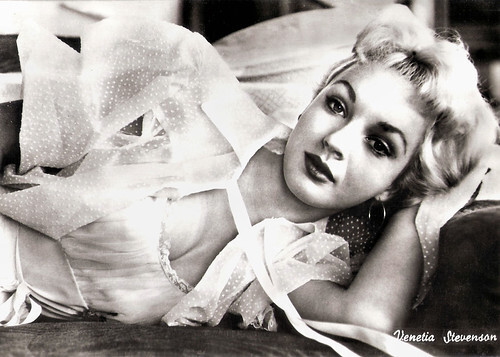
Italian postcard in the series Divi del Cinema, no. 33, by Vetta Traldi, Milano.
Sultry, glamorous blonde Venetia Stevenson (1938-2022) was a British-born Hollywood starlet of the late 1950s.
29 September 2022: Jerry Lee Lewis (1935-2022)
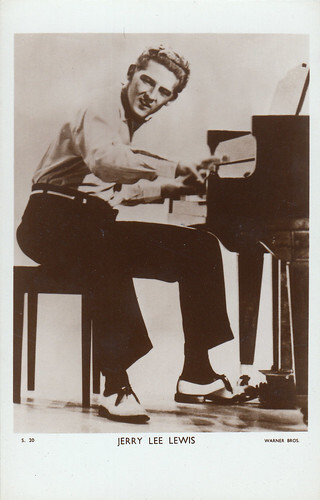
British postcard by Picturegoer, no. S20. Photo: Warner Bros. Collection: Marlene Pilaete.
American Rock and Roll singer Jerry Lee Lewis got his big break in 1957, when appeared on The Steve Allen Show with the song 'Whole Lotta Shakin' Goin' On'. A couple of #1 hits would soon follow including 'Great Balls of Fire', which became his signature song, 'Breathless' and 'High School Confidential'. Lewis often played with his fists, elbows, feet, and backside, sometimes climbing on top of the piano during gigs and even apocryphally setting it on fire. He also appeared in the cult film High School Confidential! (1958).
4 October 2022: Günter Lamprecht (1930-2022)
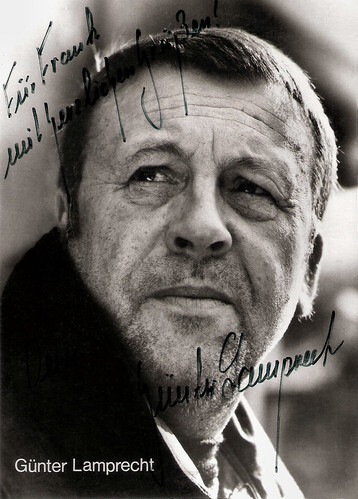
German postcard by Franz Josef Rüdel, Filmpostkartenverlag, Hamburg. Photo: Mara Eggert.
German actor Günter Lamprecht (1930-2022) played many complex character roles in theatre, film and television and had his big breakthrough as Franz Biberkopf in Rainer Werner Fassbinder's monumental television series Berlin Alexanderplatz (1980). Later he became popular as commissioner Franz Markowitz in the Krimi series Tatort (1991-1995). He also appeared in such films as Die Ehe der Maria Braun (1978), Das Boot (1981) and Comedian Harmonists (1997). Lamprecht was 92.
11 October 2022: Angela Lansbury (1925-2022)
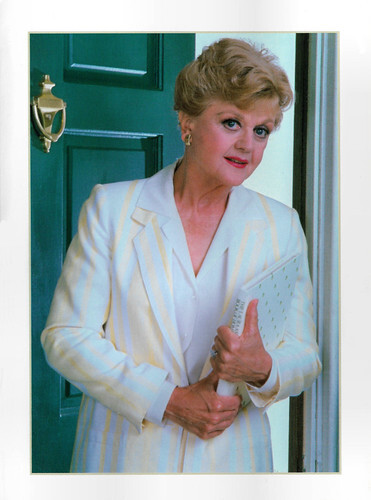
French double postcard by Polygram for the 2007 DVD release of Murder, She Wrote (1984-1985). Photo: Polygram / Universal. The French title of the series is Arabesque.
British-born character actress and TV star Angela Lansbury (1925) worked in the United States since the Second World War began. She began her career as a teenager in the films Gaslight (1944) and The Picture of Dorian Gray (1945). She was later known for her mother's roles in films like The Manchurian Candidate (1962). In the 1980s, she obtained her greatest fame on TV as Jessica Fletcher in the mystery series Murder, She Wrote (1984). Angela Lansbury was 96.
14 October 2022: Robbie Coltrane (1950-2022)
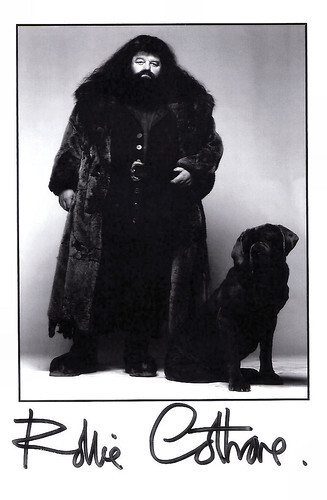
Vintage autograph card.
British actor and comedian Robbie Coltrane (1950) with his massive frame starred in several films and television series from the late 1970s but was best known for his role as half-giant Rubeus Hagrid in the Harry Potter film series. He also played in two James Bond films. Coltrane died at the age of 72 in a hospital in Scotland.
15 October 2022: Ralf Wolter (1926-2022)
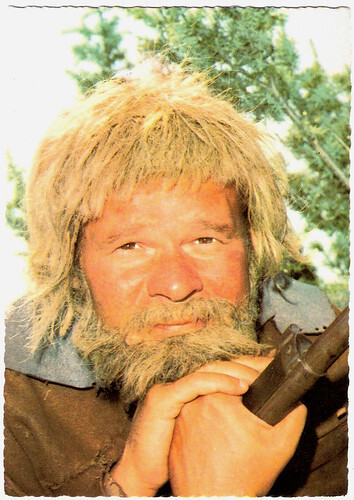
German postcard, no. 20. Photo: Rialto / Constantin. Ralf Wolter in Winnetou - 3. Teil/Desperado Trail (Harald Reinl, 1965).
Ralf Wolter (1926) was the 'King of the Supporting Parts' in countless German comedies, musicals, and Euro-Westerns. Unforgettable is his performance as Sam Hawkens, the loyal companion of Winnetou and Old Shatterhand in the classic Karl May Westerns of the 1960s. Wolter died in Munich, Germany at the age of 95.
15 October 2022: Valentina Thielová (1930-2022)

East German postcard by VEB Progress Film-Vertrieb, Berlin, no. 1885, 1963. Photo: DEFA / Blasig. Valentina Thielová in Das Stacheltier - Der Dieb von San Marengo/The Thief of Marengo (Günter Reisch, 1963).
Czech actress Valentina Thielová (1930-2022) died in her hometown Prague of natural causes. She was known for such Czech films as Zizkovská romance (1958), Bláznova kronika (1964) and Na kolejích ceká vrah (1970).
20 October 2022: June Blair (1932-2022)
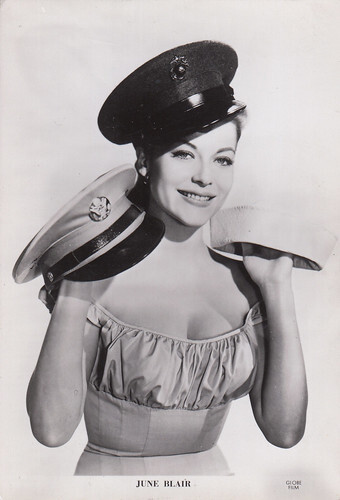
Italian postcard by Foto S.P.E.S. Roma, no. 683. Photo: Globe Film. Collection: Marlene Pilaete.
June Blair was a San Francisco-born model who provided eye candy in a few 1950s and 60s films and early TV episodes. She was often cast as chorines or good time girls.
8 November 2022: Will Ferdy (1927-2022)
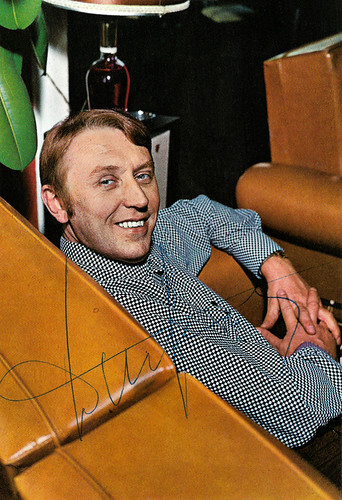
Belgian postcard by Publistar, Brussels, no. 1421. Photo: Cardinal Records / Will Ferdy-Produkties, Antwerpen.
Flemish singer Will Ferdy (1927-2022) became known for the songs 'Christine', 'Belijdenis', 'De stervende', 'Ziede gij me gere' and 'Het Schrijverke', based on Guido Gezelle's poem of the same name. Ferdy also appeared in Belgian films. He was an icon for the LGBTI+ community, being the first Flemish person to come out of the closet.
15 November 2022: Veronica Hurst (1931-2022)
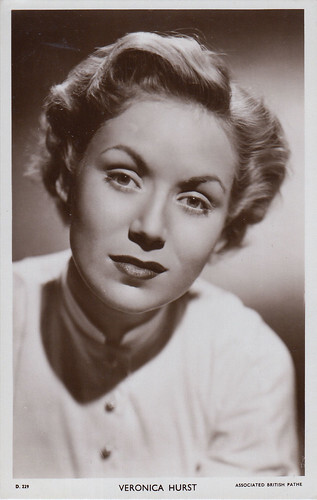
British postcard by Picturegoer, no. D229. Photo: Associated British Pathe. Collection: Marlene Pilaete.
Honey-blonde, green-eyed British actress Veronica Hurst debuted in Mario Zampi's comedy Laughter in Paradise (1951), alongside fellow screen newcomer Audrey Hepburn. She signed to a seven year contract by Associated British Pictures at Elstree Studios and provided elegance and glamour for several lightweight comedies.
28 November 2022: Ana Esmeralda (1931-2022)
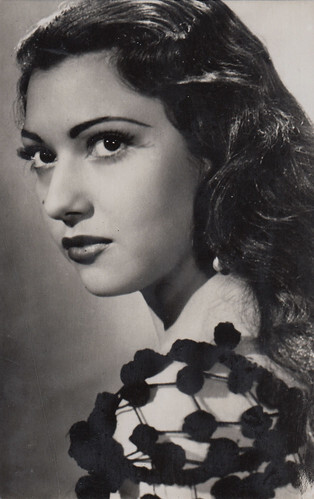
Spanish postcard, no. 2327. Collection: Marlene Pilaete.
Ana Esmeralda was born in Morocco, but started her screen career as a dancer in in Spanish films in 1948. As an actress, she had her breakthrough as the star of the crime drama María Dolores (1953) and continued to appear in Spanish films dying the 9150 and 1960s. She died in Sao Paulo, Brazil.
30 November 2022: Christiane Hörbiger (1938-2022)
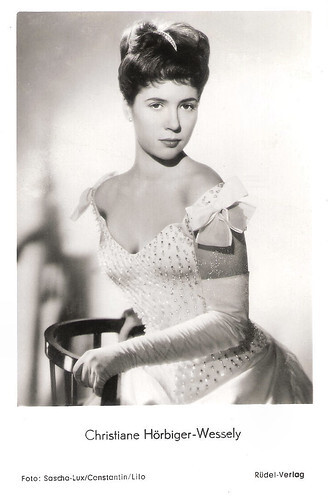
German postcard by Rüdel-Verlag, Hamburg-Bergedorf, no. 1617. Photo: Sascha-Lux / Constantin / Lilo. Publicity still for Kronprinz Rudolfs letzte Liebe/Mayerling (Rudolf Jugert, 1956).
Christiane Hörbiger (1938-2022) was an Austrian television and film actress, born into a well-known actors family. Since 1955, she made a name for herself on stage and television and in several films.
1 December 2022: Mylene Demongeot (1936-2022)
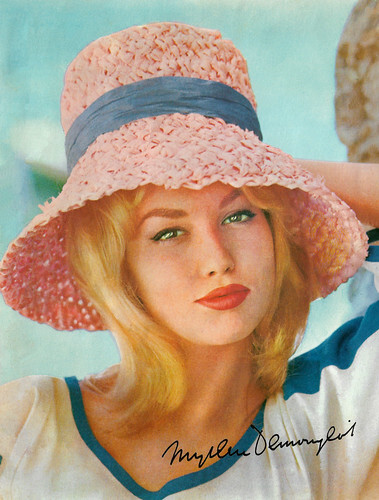
Big Dutch collectors card.
Beautiful and talented Myléne Demongeot (1936) passed away in Paris. In 1957, she became one of the blond sex symbols of the French cinema when she seduced Yves Montand in Les sorcières de Salem. The coquettish French actress would go on to co-star in the three Fantômas adventures and many other European films of the 1950s and 1960s. In the 1980s she also became a producer.
9 December 2022: Miha Baloh (1928-2022)
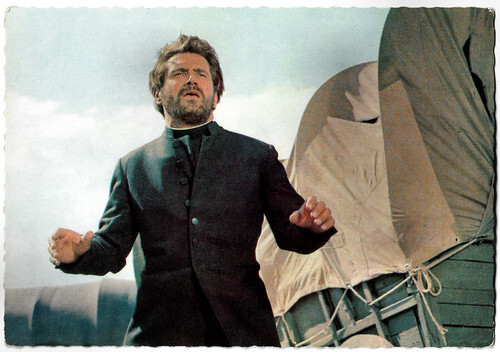
German postcard, no. 54 (of 64). Photo: Constantin. Miha Baloh in Unter Geiern/Among Vultures (Alfred Vohrer, 1964). Caption: The false preacher Weller also flees in the general turmoil of battle and is able to save himself in the nearby mountains with the remaining vultures.
Slovenian actor Miha Baloh (1928) played a bad priest in the Euro-Western Unter Geiern/Among Vultures (Alfred Vohrer, 1964), based on one of the Winnetou novels by Karl May. He was also known for such films as Operacija Ticijan (1963), Grajski biki (1967), and Les évasions célèbres (1972).
21 December 2022: Diane McBain (1941-2022)

Spanish postcard by Archivo Bermejo, no. C-124, presented by Kores Carboplan. Photo: Warner Bros. Publicity still for the television series Surfside 6 (1960–1962). The Spanish title was Rompeolas 6.
American actress Diane McBain (1941-2022) was a bouncy, blonde-coiffed Warner Brothers starlet. She reached a brief peak of popularity during the early 1960s as a "bad girl" and "spoiled rich girl". She was best known for playing an adventurous socialite in the television series Surfside 6 (1960–1962) and as one of Elvis Presley's leading ladies in Spinout (1966).
With thanks to Marlene Pilaete! For a more complete list of the stars and other film people who passed away in 2022, check out Les gens du cinema - Décédés en 2022.
7 January 2022: Sidney Poitier (1927-2022)

Italian postcard by Bromostampa, Milano, no. 267.
Sidney Poitier (1927) was a Bahamian-American actor, film director, activist, and ambassador. He was one of the last surviving stars from the Golden Age of Hollywood. In 1964, Poitier won the Oscar for Best Actor becoming the first black male and Bahamian actor to win that award. In 1955, he had his breakthrough as a high school student in Blackboard Jungle (1955). In 1958, Poitier starred with Tony Curtis as chained-together escaped convicts in The Defiant Ones, for which he received a nomination for Best Actor - the first for a black actor. In 1964, he won the Academy Award and the Golden Globe for Lilies of the Field (1963). He continued to break ground in such films as Guess Who's Coming to Dinner (1967) and In the Heat of the Night (1967). Poitier was 94.
13 January 2022: Jean-Jacques Beineix (1946-2022)

French postcard by Editions F. Nugeron, no. E 309. Image: French film poster for 37°2 le matin/Betty Blue (Jean-Jacques Beineix, 1986).
French director, screenwriter and producer Jean-Jacques Beineix (1946) had his breakthrough with his first feature film. The psychological thriller Diva (1980), about a young postman obsessed with an opera diva, received four Césars. An even bigger success was his third film, 37°2 le matin/Betty Blue (1986). The erotic drama was nominated for the best foreign-language film at the Oscars and became the eighth highest-grossing film of the year in France. Beineix, who suffered from leukaemia was 75.
16 January 2022: Carmela Corren (1938-2022)

West-German postcard by Kolibri-Verlag G.m.b.H., Minden/Westf., no. 1658.
Israeli-born singer and actress Carmela Corren (1938-2022) represented Austria at the Eurovision Song Contest 1963 with her song 'Vielleicht Geschieht Ein Wunder'. In the early 1960s, she starred in several Schlager- and Heimatfilms in Austria end Germany. After retiring, Corren lived in Florida. She was 83.
17 January 2022: Michel Subor (1935-2022)

French postcard by E.D.U.G., no. 164. Photo: Sam Lévin.
French actor Michel Subor gained initial fame with the starring role in Jean-Luc Godard's second feature, Le Petit Soldat (1960). He acted in a couple of American films, including Alfred Hitchcock's Topaz (1969) as Claude Jade's husband. In 1999, he played Forestier in Beau Travail, a highly praised variation of Billy Budd, directed by Claire Denis. He continued to work with her. Subor was 86.
18 January 2022: Yvette Mimieux (1942-2022)

West-German collectors card, no. 53.
American actress and writer Yvette Mimieux (1942) died from natural causes at her home in Los Angeles. She was known for The Time Machine (1960), and several other popular films of the 1960s. Mimieux was nominated for three Golden Globe awards during her acting career. She passed away overnight in her sleep at the age of 80.
19 January 2022: Gaspard Ulliel (1984-2022)

French postcard by Warner Bros, France / Tapioca Films / TF1 Films Production. Gaspard Ulliel and Audrey Tautou on the English poster for Un long dimanche de fiançailles/A Very Long Engagement (Jean-Pierre Jeunet, 2004).
French actor Gaspard Ulliel (1984) died in Grenoble, France. The Cesar-winning star of Un long dimanche de fiançailles/A Very Long Engagement (2004) and Hannibal Rising (2007) was involved in a skiing accident in the Alps. He was only 37.
19 January: Hardy Krüger (1928–2022)

West-German postcard by Netter's Star Verlag, Berlin, no. 1256.
German actor and writer Hardy Krüger (1928) was a blond heartthrob in numerous European films of the 1950s and 1960s. He also played in several classic American films. He played friendly soldiers and adventurers in numerous German, British and French films and also in some Hollywood classics. Although he often was typecasted as the Aryan Nazi, he hated wearing the brown uniform. Krüger was 93.
21 January 2022: Joyce Holden (1930-2022)

Dutch postcard, no. 587. Photo: Universal International.
Joyce Holden was a beautiful Hollywood starlet in B-films and TV productions of the 1950s. She played a 'delinquent daughter' in the crime drama Girls in the Night (1953), a femme fatale with a mink in the comedy Private Eyes (1953) and the lady-in-distress in the horror film The Werewolf (1956). In 1958, she married and retired. As a Jehovah’s Witness, she knocked on front doors to deliver her sermon: "Christ went from city to city, from door to door, preaching his way."
25 January: Etchika Choureau (1929-2022)

Italian postcard by Bromofoto, Milano, no. 947. Photo: Dear Film. Etchika Choureau in Les Enfants de l'amour/Children of Love (Léonide Moguy, 1953).
French actress Etchika Choureau 's film career started very promisingly with three films and an award in 1953. During the 1950s, the beauty with green eyes and long blond hair graced films in France, Germany, Italy, and Hollywood. After a long affair with the Crown prince of Morocco, she tried to make a come-back but failed and retired. She died at the age of 92.
2 February 2022: Monica Vitti (1931-2022)

Romanian postcard by Casa Filmuluii Acin, no. 467. Monica Vitti in Ridere! Ridere! Ridere!/Laugh! Laugh! Laugh! (Edoardo Anton, 1954).
Legendary Italian actress Monica Vitti passed away in Rome at the age of 90. She was most widely noted in the early 1960s for her starring roles in four classic avant-garde films directed by Michelangelo Antonioni. Later the glamorous blonde became the queen of the 'Commedia all’Italiana', a film genre previously restricted to men.
27 February 2022: Veronica Carlson (1944-2022)

Vintage autographed card. Collection: Marlene Pilaete.
Striking, pale-complexioned, blonde English actress Veronica Carlson was known as the female lead of several late 1960s Hammer horror films, including the hapless Maria being terrorised by fanged Christopher Lee in Dracula Has Risen from the Grave (1968), brutalised by the evil Peter Cushing in Frankenstein Must Be Destroyed (1969) and chased by monster David Prowse in The Horror of Frankenstein (1970).
13 March 2022: William Hurt (1950-2022)

French postcard by Humour a la carte, Paris, no. ST 156.
American actor William Hurt died at the age of 71. Hurt started out as a stage actor and his career as a film actor lasted more than forty years. In the early 1980s, he starred in the brooding Film Noir Body Heat (1981), the midlife drama The Big Chill (1983) and Children of a Lesser God (1986), about a teacher at a school for the deaf. In the 1980s, Hurt was nominated for an Oscar for best actor three times in a row. He won it in 1985 for his role in Kiss of the Spider Woman (1985). In 2005, he was nominated for the fourth time, for the film A History of Violence (2005). In later years, Hurt played General Thaddeus Ross in five Marvel superhero films.
21 March 2022: Eva Ingeborg Scholz (1928-2022)

West-German postcard by Ufa/Film-Foto, Berlin-Tempelhof, no. 1652. Photo: T. v. Mindszenty / Central Europa Film / Europa Film. Eva Ingeborg Scholz in Ball im Savoy/Ball at the Savoy (Paul Martin, 1955).
German film and television actress Eva Ingeborg Scholz passed away at the age of 94. Since her East-German debut in 1948, she played in more than 110 film and television productions.
5 April 2022: Bobby Rydell (1942-2022)

Dutch postcard by N.V. v.h. Weenenk & Snel, Baarn.
American singer and actor Bobby Rydell passed away at 79. The teen idol had big hits like 'Kissin' Time' (1959), 'Wild One' (1960), 'Forget Him' (1963), and the English cover version of 'Volare' (1960). Rydell also starred in some films of the early 1960s.
17 April 2022: Catherine Spaak (1945-2022)

Italian postcard by Rotalfoto (Rotalcolor), Milano, no. 244.
French actress and singer Catherine Spaak appeared in some 100 films. She started as a Lolita-like vamp in Italian films of the early 1960s, made records and became a teenage star. Later, she played in several classic Italian comedies and was a popular TV host.
21 April 2022: Jacques Perrin (1941-2022)

East-German postcard by Progress Film-Vertrieb, Berlin, no 3263, 1963.
Jacques Perrin (1941-2022) was a handsome and talented French actor who started his career as the romantic hero in the films of Italian director Valerio Zurlini. Later he made powerful films with Costa-Gravas and played the adult Salvatore in the international hit Cinema Paradiso (1988). With his own studio, he produced successful political films such as Z (1969) and nature documentaries such as Microcosmos (1996).
21 April 2022: Renate Holm (1931-2022)

East-German postcard by VEB Volkskunstverlag Reichenbach I.V., no. G 740, 1957. Retail price: 0,15 DM. Photo: Teldec.
Renate Holm (1931-2022) was a German-Austrian film actress and operatic soprano. During the 1950s she was a popular star of Schlager films and operettas. In the 1960s, she became a star at the Vienna State Opera under the direction of Herbert von Karajan.
1 May 2022: Régine (1929-2022)

French postcard by Editions Lyna, Paris, no. 2010. Photo: Tony Frank. Collection: Marlene Pilaete.
Régine was a French singer, actress and nightclub impresario. Born in Belgium to Polish Jewish parents, she started life hiding from the Nazis in occupied wartime France. After the war, Régine became a torch singer and by 1953 was a nightclub manager in Paris. In 1957, she opened Chez Régine in the Latin Quarter, which became the place to be seen for visiting celebrities, socialites and royalty. As her celebrity expanded she established other venues under the name Chez Régine's in London, New York City, Monte Carlo and elsewhere, all featuring her signature "disco-style" layout. She dubbed herself the "Queen of the Night" and had a hit single with the French version of Gloria Gaynor's 'I will survive'. She had supporting parts in such films as Le couteau dans la plaie/Five Miles to Midnight (1962) and The Seven-Per-Cent Solution (1976).
10 May 2022: Joanna Barnes (1934-2022)

Dutch postcard by Uitgave “Emdeeha” de Hond Oosterbeek, no. 16. Collection: Marlene Pilaete.
American actress, novelist and journalist Joanna Barnes had roles in more than twenty films, including Spartacus (1960) and The Parent Trap (1961) and made guest appearances on many television shows, including Have Gun - Will Travel (1957), Maverick (1957) and Fantasy Island (1978-1979).
14 May 2022: Robert Cogoi (1939-2022)

Belgian postcard by S. Best, Antwerp, for Victoria, no. 14.
One day after the Eurovision Song Contest in Turin, Belgian singer Robert Cogoi passed away. He represented his country in the 1964 Eurovision Song Contest. In the 1960s, Cogoi was one of the most popular Walloon singers, together with Salvatore Adamo.
17 May 2022: María Duval (1926-2022)

Argentinian postcard by Argentina Sono Film. Collection: Marlene Pilaete.
Argentinian actress María Duval known for such films as Casi un sueño (1943), Milagro de amor (1946) and La serpiente de cascabel (1948). She was previously married to Joseph Grosman.
17 June 2022: Jean-Louis Trintignant (1930-2022)

Vintage press photo. Jean-Louis Trintignant and Jacqueline Sassard in Estate violenta/Violent Summer (Valerio Zurlini, 1959).
Jean-Louis Trintignant (1930-2022) was one of the most gifted French actors of the post-war era. He starred in more than 100 films and enjoyed international acclaim with films like Et Dieu... créa la femme/And God Created Woman (1956), Un homme et une femme/A Man And A Woman (1966), Z (1969) and Il Conformista/The Conformist (1970 ). He showed a special talent for dark characters like murderers or jealous husbands and won several awards for it. Trintignant passed away on 17 June 2022 in Uzès. He was 91.
20 June 2022: Regimantas Adomaitis (1937-2022)

Soviet-Russian postcard by Izdanije Byuro Propogandy Sovietskogo Kinoiskusstva, no. M-31293 9/IV-68. This postcard was printed in an edition of 150,000 cards. The retail price was 8 kop.
Lithuanian film and stage actor Regimantas Adomaitis (1937) was particularly active in Soviet and East German cinema, for example in Korol Lir/King Lear (1970) and Jeto sladkoje slovo - svoboda!//That Sweet Word: Liberty! (1972).
23 June 2022: Ernst Jacobi (1933-2022)

West-German postcard by Franz Josef Rüdel, Filmpostkartenverlag, Hamburg. Photo: Christian Kohlund, München (Munich).
On 23 June 2022, German actor and writer Ernst Jacobi (1933) passed away in Vienna, Austria at the age of 88. He was a character actor best known for the acclaimed films Volker Schlöndorf's Die Blechtrommel/The Tin Drum (1979) and Michael Haneke's Das weiße Band/The White Ribbon (2009). He was also the German voice of Peter Pan.
6 July 2022: James Caan (1940-2022)

Romanian postcard by Casa Filmului Acin, no. 212. James Caan in El Dorado (Howard Hawks, 1967).
American actor James Caan (1940) was best known for his role as Sonny Corleone in Francis Ford Coppola's classic The Godfather (1972), for which he received an Oscar nomination. Caan was 82.
18 July 2022: Dani (1944-2022)

French postcard by Corvisart, Epinal.
French actress and singer Dani (1944) started her career as a mannequin and nightclub singer. She became known for her role as the scriptgirl Lilliane in François Truffaut's La nuit américaine/Day for Night (1973) and L'amour en fuite/Love on the Run (1979). Dani was 77.
20 July 2022: Nichelle Nichols (1932-2022)

West-German postcard by Xtreme, Wuppertal, no. 32733. Nichelle Nichols with DeForest Kelley, William Shatner and Leonard Nimoy in the TV series Star Trek (1966-1969).
American actress Nichelle Nichols (1932) passed away in Silver City. We remember her as Lieutenant Nyota Uhura in the space adventure TV series Star Trek (1966-1969). The lieutenant on the bridge of Starship Enterprise was a groundbreaking example of representation for Black Americans in Hollywood. She also played Uhura in the first six Star Trek feature films, that continue the adventures of the cast of the original series.
29 July 2022: Janine van Wely (1937)

Dutch collectors card by Bros, Bensdorp N.V., Bussum. Janine van Wely as Mammaloe and Cees van Ooyen as Pipo in the TV series Pipo op Bizarra/Pipo on Bizarra (1971).
Dutch actress and artist Janine van Wely (1937) acted in Dutch films and such classic TV series as Pipo de Clown. She was 84.
4 August 2022: Margot Eskens (1936-2022)

German card.
German schlager singer Margot Eskens (1936) achieved her success mainly in the 1950s and 1960s and represented Germany in 1966 in the Eurovision Song Contest. She also appeared in the film Auf Wiedersehn (1961).
6 August 2022: Carlo Bonomi (1937-2022)

Dutch postcard. Caption: Pingu with accordion.
Carlo Bonomi (1937) died in Milan, Italy at the age of 85. He was an Italian voice actor and clown who was known for his voiceover work as the voice of Pingu as well as various other characters in the stop-motion children's television series of the same name. He also gave his voice to Mr. Linea in the classic animated series La Linea.
8 August 2022: Olivia Newton-John (1948-2022)

French postcard by Star, Paris, in the Collection John Travolta. John Travolta and Olivia Newton-John in Grease (Randal Kleiser, 1978).
British-Australian singer and actress Olivia Newton-John (1948) passed away at the age of 73. She was best known for the musical film Grease (1978). Olivia had been suffering from breast cancer for some time. She died at her home in California in the presence of her family and friends.
16 August 2022: Eva-Maria Hagen (1934-2022)

East-German postcard by VEB Progress Film-Vertrieb, Berlin, no. 3092, 1968. Photo: Schwarz / DEFA.
The German actress Eva-Maria Hagen died at the age of 87. From 1957 to 1965 she appeared in some 50 films and TV productions and became known as 'East Germany’s Brigitte Bardot'. Her daughter, the well-known singer Nina Hagen, and two of her grandchildren told the German newspaper Bild on Friday. It is not known how she died. Eva-Maria Hagen was also a well-known singer, painter and author.
7 September 2022: Marsha Hunt (1917-2022)

British postcard in the Picturegoer Series, no. W105. Photo: Metro-Goldwyn-Mayer. Collection: Marlene Pilaete.
American retired actress, model, and activist Marsha Hunt had a career spanning 73 years and appeared in many popular films including Pride and Prejudice (1940), Blossoms in the Dust (1942), Cry 'Havoc' (1943), The Human Comedy (1943), and Raw Deal (1948). She was blacklisted by Hollywood film studio executives in the 1950s during McCarthyism. In her later years, she has aided homeless shelters, supported same-sex marriage, raised awareness of climate change, and promoted peace in Third World countries.
13 September 2022: Jean-Luc Godard (1930-2022)

French postcard by La Cinémathèque française. Photo: Georges Pierre. Caption: Jean-Luc Godard , photo of the shooting of Pierrot le Fou, 1965.
French film director and screenwriter Jean-Luc Godard (1930) was one of the most important members of the Nouvelle Vague (New Wave). Godard first received global acclaim for his feature À bout de souffle/Breathless (1959), helping to establish the New Wave movement. Godard's films have inspired many directors including Martin Scorsese, Quentin Tarantino, Robert Altman, Rainer Werner Fassbinder, and Wong Kar-wai. He has been married twice, to actresses Anna Karina and Anne Wiazemsky, both of whom starred in several of his films.
14 September 2022: Irene Papas (1926-2022)

Italian postcard by Rotalfoto, Milano, no. 142. Photo: Ponti - De Laurentiis. Irene Papas in Le infedeli/The Unfaithfuls (Mario Monicelli, Steno, 1953).
Greek actress of international fame, Irene Papas (1926) passed away at the age of 96. In a career spanning more than fifty years, she starred in over seventy films, including such classics as The Guns of Navarone (1961) and Zorba the Greek (1964). Papas also portrayed ancient Greek heroines in Antigoni/Antigone(1961), Ilektra/Electra (1962), Helen in The Trojan Women (1972), and Clytemnestra in Iphigenia (1977).
15 September 2022: Diana Maggi (1925-2022)

Argentinian postcard by Cromocart G.W., no. A10. Collection: Marlene Pilaete.
Volcanic redhead Diana Maggi was born in Italy and raised in Argentina. Her secondary rol in Luis César Amadori's Nacha Regules (1950) was acclaimed and, in the 1950s, she starred mostly in dramatic films in Argentina and was directed by Leopoldo Torre Nilsson. After a brief stay in Spain, in the early 1960s she returned to Buenos Aires, starting a successful career as comic actress. From early 1970s, she was married to actor Juan Carlos Dual.
26 September 2022: Venetia Stevenson (1938-2022)

Italian postcard in the series Divi del Cinema, no. 33, by Vetta Traldi, Milano.
Sultry, glamorous blonde Venetia Stevenson (1938-2022) was a British-born Hollywood starlet of the late 1950s.
29 September 2022: Jerry Lee Lewis (1935-2022)

British postcard by Picturegoer, no. S20. Photo: Warner Bros. Collection: Marlene Pilaete.
American Rock and Roll singer Jerry Lee Lewis got his big break in 1957, when appeared on The Steve Allen Show with the song 'Whole Lotta Shakin' Goin' On'. A couple of #1 hits would soon follow including 'Great Balls of Fire', which became his signature song, 'Breathless' and 'High School Confidential'. Lewis often played with his fists, elbows, feet, and backside, sometimes climbing on top of the piano during gigs and even apocryphally setting it on fire. He also appeared in the cult film High School Confidential! (1958).
4 October 2022: Günter Lamprecht (1930-2022)

German postcard by Franz Josef Rüdel, Filmpostkartenverlag, Hamburg. Photo: Mara Eggert.
German actor Günter Lamprecht (1930-2022) played many complex character roles in theatre, film and television and had his big breakthrough as Franz Biberkopf in Rainer Werner Fassbinder's monumental television series Berlin Alexanderplatz (1980). Later he became popular as commissioner Franz Markowitz in the Krimi series Tatort (1991-1995). He also appeared in such films as Die Ehe der Maria Braun (1978), Das Boot (1981) and Comedian Harmonists (1997). Lamprecht was 92.
11 October 2022: Angela Lansbury (1925-2022)

French double postcard by Polygram for the 2007 DVD release of Murder, She Wrote (1984-1985). Photo: Polygram / Universal. The French title of the series is Arabesque.
British-born character actress and TV star Angela Lansbury (1925) worked in the United States since the Second World War began. She began her career as a teenager in the films Gaslight (1944) and The Picture of Dorian Gray (1945). She was later known for her mother's roles in films like The Manchurian Candidate (1962). In the 1980s, she obtained her greatest fame on TV as Jessica Fletcher in the mystery series Murder, She Wrote (1984). Angela Lansbury was 96.
14 October 2022: Robbie Coltrane (1950-2022)

Vintage autograph card.
British actor and comedian Robbie Coltrane (1950) with his massive frame starred in several films and television series from the late 1970s but was best known for his role as half-giant Rubeus Hagrid in the Harry Potter film series. He also played in two James Bond films. Coltrane died at the age of 72 in a hospital in Scotland.
15 October 2022: Ralf Wolter (1926-2022)

German postcard, no. 20. Photo: Rialto / Constantin. Ralf Wolter in Winnetou - 3. Teil/Desperado Trail (Harald Reinl, 1965).
Ralf Wolter (1926) was the 'King of the Supporting Parts' in countless German comedies, musicals, and Euro-Westerns. Unforgettable is his performance as Sam Hawkens, the loyal companion of Winnetou and Old Shatterhand in the classic Karl May Westerns of the 1960s. Wolter died in Munich, Germany at the age of 95.
15 October 2022: Valentina Thielová (1930-2022)

East German postcard by VEB Progress Film-Vertrieb, Berlin, no. 1885, 1963. Photo: DEFA / Blasig. Valentina Thielová in Das Stacheltier - Der Dieb von San Marengo/The Thief of Marengo (Günter Reisch, 1963).
Czech actress Valentina Thielová (1930-2022) died in her hometown Prague of natural causes. She was known for such Czech films as Zizkovská romance (1958), Bláznova kronika (1964) and Na kolejích ceká vrah (1970).
20 October 2022: June Blair (1932-2022)

Italian postcard by Foto S.P.E.S. Roma, no. 683. Photo: Globe Film. Collection: Marlene Pilaete.
June Blair was a San Francisco-born model who provided eye candy in a few 1950s and 60s films and early TV episodes. She was often cast as chorines or good time girls.
8 November 2022: Will Ferdy (1927-2022)

Belgian postcard by Publistar, Brussels, no. 1421. Photo: Cardinal Records / Will Ferdy-Produkties, Antwerpen.
Flemish singer Will Ferdy (1927-2022) became known for the songs 'Christine', 'Belijdenis', 'De stervende', 'Ziede gij me gere' and 'Het Schrijverke', based on Guido Gezelle's poem of the same name. Ferdy also appeared in Belgian films. He was an icon for the LGBTI+ community, being the first Flemish person to come out of the closet.
15 November 2022: Veronica Hurst (1931-2022)

British postcard by Picturegoer, no. D229. Photo: Associated British Pathe. Collection: Marlene Pilaete.
Honey-blonde, green-eyed British actress Veronica Hurst debuted in Mario Zampi's comedy Laughter in Paradise (1951), alongside fellow screen newcomer Audrey Hepburn. She signed to a seven year contract by Associated British Pictures at Elstree Studios and provided elegance and glamour for several lightweight comedies.
28 November 2022: Ana Esmeralda (1931-2022)

Spanish postcard, no. 2327. Collection: Marlene Pilaete.
Ana Esmeralda was born in Morocco, but started her screen career as a dancer in in Spanish films in 1948. As an actress, she had her breakthrough as the star of the crime drama María Dolores (1953) and continued to appear in Spanish films dying the 9150 and 1960s. She died in Sao Paulo, Brazil.
30 November 2022: Christiane Hörbiger (1938-2022)

German postcard by Rüdel-Verlag, Hamburg-Bergedorf, no. 1617. Photo: Sascha-Lux / Constantin / Lilo. Publicity still for Kronprinz Rudolfs letzte Liebe/Mayerling (Rudolf Jugert, 1956).
Christiane Hörbiger (1938-2022) was an Austrian television and film actress, born into a well-known actors family. Since 1955, she made a name for herself on stage and television and in several films.
1 December 2022: Mylene Demongeot (1936-2022)

Big Dutch collectors card.
Beautiful and talented Myléne Demongeot (1936) passed away in Paris. In 1957, she became one of the blond sex symbols of the French cinema when she seduced Yves Montand in Les sorcières de Salem. The coquettish French actress would go on to co-star in the three Fantômas adventures and many other European films of the 1950s and 1960s. In the 1980s she also became a producer.
9 December 2022: Miha Baloh (1928-2022)

German postcard, no. 54 (of 64). Photo: Constantin. Miha Baloh in Unter Geiern/Among Vultures (Alfred Vohrer, 1964). Caption: The false preacher Weller also flees in the general turmoil of battle and is able to save himself in the nearby mountains with the remaining vultures.
Slovenian actor Miha Baloh (1928) played a bad priest in the Euro-Western Unter Geiern/Among Vultures (Alfred Vohrer, 1964), based on one of the Winnetou novels by Karl May. He was also known for such films as Operacija Ticijan (1963), Grajski biki (1967), and Les évasions célèbres (1972).
21 December 2022: Diane McBain (1941-2022)

Spanish postcard by Archivo Bermejo, no. C-124, presented by Kores Carboplan. Photo: Warner Bros. Publicity still for the television series Surfside 6 (1960–1962). The Spanish title was Rompeolas 6.
American actress Diane McBain (1941-2022) was a bouncy, blonde-coiffed Warner Brothers starlet. She reached a brief peak of popularity during the early 1960s as a "bad girl" and "spoiled rich girl". She was best known for playing an adventurous socialite in the television series Surfside 6 (1960–1962) and as one of Elvis Presley's leading ladies in Spinout (1966).
With thanks to Marlene Pilaete! For a more complete list of the stars and other film people who passed away in 2022, check out Les gens du cinema - Décédés en 2022.
Published on December 31, 2022 22:00
December 29, 2022
La Collectionneuse: Theda Bara
In 1915, Theda Bara became the first sex symbol in American cinema. She was also responsible for the emergence of the word 'vamp' and the quote "Kiss Me My Fool" in popular culture.

American postcard by Kline Poster Co. Inc., Philadelphia. Photo: Fox. Theda Bara in Carmen (Raoul Walsh, 1915).
To introduce her to the public, two Fox publicity agents, John Goldfrap and Al Selig launched an astonishing advertising campaign, inventing a foreign background for their new star. They claimed that Theda was born in Egypt, in the shadow of the Sphinx, to an Italian artist and a French actress and that she had been a stage star in Paris before coming to the U.S.A. None of this was true. It’s commonly assumed that those rather far-fetched stories were not meant to be taken seriously but that they were created to offer entertaining and escapist reading to thrill-seeking audiences. Anyway, it should be noted that, as early as mid-1915, several newspapers had begun to reveal that Theda was, in fact, a Cincinnati-born girl. With her heavily kohl-rimmed eyes and her racy on-screen persona, she offered for sure a distinct contrast to child women such as Mary Pickford or healthy and spunky serial heroines such as Pearl White. The public was delighted to see an actress whose primary attraction was her sexuality.
Later, Fox's publicity department came up with other weird stories, declaring e.g. that the souls of Delilah, Lucrezia Borgia and the bloody countess Elizabeth Bathory were reincarnated in Theda’s mind, that a physician had discovered that the actress had the muscular system of a serpent or that her contract included several special clauses, such as forbidding her to marry or to appear in public without veils. Photos of an unveiled and smiling Theda selling Liberty Bonds in New York in the fall of 1917 seems to indicate that this bizarre contract either was not intended to be fulfilled or only existed in Goldfrap and Selig’s minds.
Theda Bara herself was quite ambivalent about this kind of publicity. On the one hand, she knew that such outlandish press coverage stereotyped her. On the other hand, she was well aware of the value of her transgressive and exotic image. So she played the game by mentioning for example an emerald ring which "had been given to her by a blind sheikh", by declaring that she was deeply attached to two statuettes of Egyptian God Amen Ra which "have been bought in a Paris shop when she was a child" or by pretending, at the time of Carmen, that she had lived in Spain in one previous life.
From 1915 to 1919, she starred in an amazing output of thirty-nine movies and her successes enabled William Fox to lay the groundwork for his empire. In private, Theda Bara was quite unlike her image. In her heyday at Fox, she lived quietly with her mother and her sister, her off-screen reputation unblemished by any scandal or misbehaviour. She only married once, to director Charles Brabin in 1921, and their happy union lasted until her death in 1955.
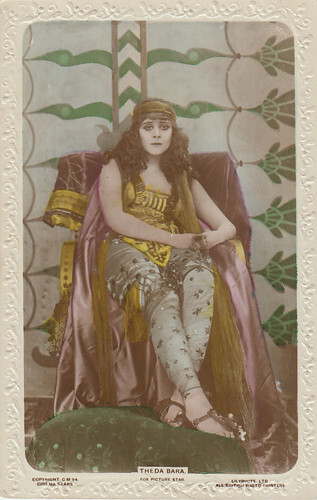
British postcard by Lilywhite in the Cinema Stars series, no. C.M. 94. Photo: William Fox. Theda Bara in Salome (J. Gordon Edwards, 1918).
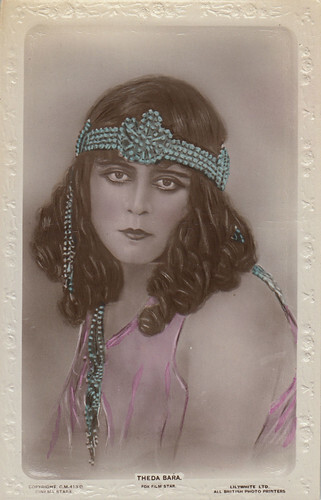
British postcard by Lilywhite in the Cinema Stars series, no. C.M. 413D. Photo: William Fox. Theda Bara in Salome (J. Gordon Edwards, 1918).
Theda Bara before she became the queen of vamps
Theda Bara was born Theodosia Goodman on the 29th of June 1885 in Cincinnati, Ohio, U.S.A. Her father was a Jewish Polish-born tailor and her mother was born in Switzerland.
From an early age, she was fascinated by acting and, after having spent two years at Cincinnati University, she dropped out in 1905 to go on stage. The following years are not very well documented.
Confirmed appearances include a small role in Ferenc Molnar’s 'The Devil on Broadway' in 1908 and touring in a road company with the musical 'The Quaker Girl' in 1911.
Her stage career going nowhere, she decided to give it a try to movies. She made her film debut at Pathe with a bit role in Frank Powell’s The Stain (1914). He took interest in her as he liked the way she photographed and reacted to direction.
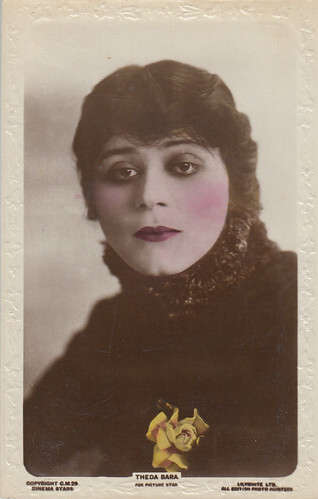
British postcard by Lilywhite Ltd, no. C.M. 29. Photo: William Fox.
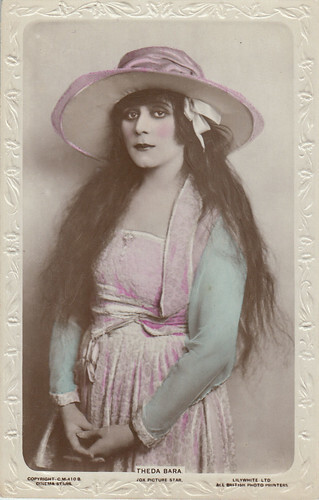
British postcard by Lilywhite Ltd, no. C.M. 410 B. Photo: William Fox.
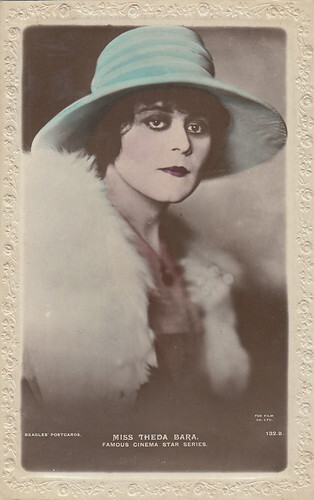
British postcard in the Famous Cinema Stars series by J. Beagles & Co. Ltd. London, no. 132. B.
A Fool There Was
'A Fool There Was' was a 1909 Broadway play, inspired by an 1897 Rudyard Kipling poem called 'The Vampire', itself inspired by a painting. The play, which was also adapted into a book, tells the story of a diplomat falling into the clutches of an evil seductress, who ruins his life. William Fox bought the rights and hired Frank Powell to direct the film version.
At his suggestion, Fox signed, in the fall of 1914, the unknown Theodosia to play the leading female role. She was quickly rebaptised Theda Bara, Theda being a diminutive of Theodosia and Bara coming for her maternal grandfather’s name, Baranger. A Fool There Was was released in January 1915. It was a huge hit and made Theda Bara a star overnight.
Of course, it was not the first time that a temptress had been depicted in an American movie but it was certainly the first time that it was done with such force and carnal power. The heroine has absolutely no redeeming features in her actions. In the course of the plot, we see for example that one of her former victims had become a skid-row bum.
"See what you have done to me, and still you prosper, you hellcat", he says to a haughty Theda, who quickly asks a policeman to move the poor chap away. When another of her discarded ex-boyfriends confronts her, armed with a gun, she just calmly answers him "Kiss me my Fool" and, still under her spell, he shoots himself. Furthermore, her unnamed character, simply called 'The Vampire' all through the film, is not even punished in the end. Indeed, a triumphant Theda is seen in the final reel scattering flower petals over her lover’s lifeless body and we are left to imagine her ready to move on to other prey.
We can easily imagine the shock it had been to audiences at that time to see such an evil, unrepentant and erotically charged character. The New York Dramatic Mirror wrote: "Miss Bara misses no chance for sensuous appeal in her portrayal of the Vampire. She is a horribly fascinating woman, vicious to the core, and cruel". And, for the New York Morning Telegraph, the Vampire was "quite the most revolting but fascinating character that has appeared upon the screen for some time".
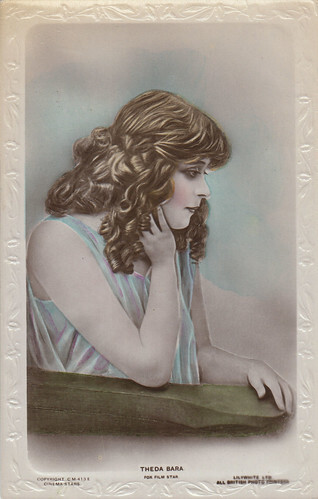
British postcard by Lilywhite Ltd, no. C.M. 413 E. Photo: William Fox.
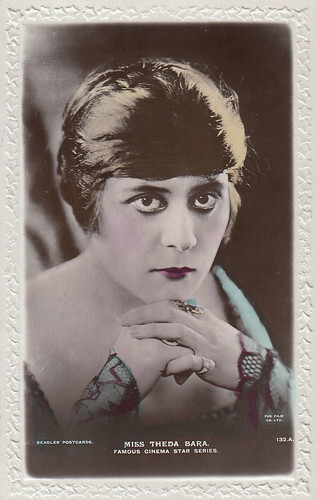
British postcard in the Famous Cinema Stars series by J. Beagles & Co. Ltd. London, no. 132a. Photo: William Fox.
Fox’s undisputed queen
After A Fool There Was, Theda Bara stole her sister’s husband in Kreutzer Sonata (1915), was an unfaithful and depraved wife in The Clemenceau Case (1915) and wrecked a sculptor’s marital bliss in The Devil’s Daughter (1915). By now, she had become firmly associated with vampire roles and the abbreviation 'vamp' soon became a household word. After the disappointing box-office receipts of Lady Audley’s Secret (1915) and The Two Orphans (1915), in which she played more restrained characters, Fox wisely put her back on the vamping track in films such as Sin (1915), Carmen (1915), Destruction (1915), The Serpent (1915) or Gold and the Woman (1916). Needless to say, some of her films met with censorship problems.
From time to time, usually at her demand, she was again given non-vamping parts such as in East Lynne (1916), Under Two Flags (1916), Romeo and Juliet (1916), Her Greatest Love (1917) or Heart and Soul (1917) but it seemed that her fans always preferred her as a femme fatale. They were thrilled to see her for example in The Vixen (1916), in which her character proclaims: "It’s true that I have no heart but then, I am more comfortable without one", and in The Tiger Woman (1917), which caused one reviewer to write: "The wholesome damage that strews her pathway would put a Kansas cyclone to shame".
Just after having played the famous French courtesan Marguerite Gautier in Camille (1917), she starred in the most prestigious film of her career, the lavish Cleopatra (1917). Never to be outdone, Fox advertising services reported the discovery, in a tomb of the ancient Egyptian city of Thebes, of an inscription found on an antique stone wall forecasting the coming of Theda Bara several centuries later. The fact that her pseudonym was an anagram of 'Arab Death' added extra spice to this odd story. Theda herself suggested that she was a reincarnation of the last queen of Egypt.
All this was good publicity playfulness and was great fun to read. The risqué costumes she wore (such as a snake bra and other revealing brassieres) didn’t go unnoticed and attracted much comment. She most probably had never displayed so much flesh before. Cleopatra was one of the most popular films of 1917 and cemented her position as Fox’s nr 1 moneymaker. She later appeared in two other special big-budgeted productions, Madame du Barry (1917) and Salome (1918). In August 1918, the actress came tenth in a popularity poll held by Motion Picture Magazine, above Charlie Chaplin , who ranked 17th.
As 1919 went by, the Theda Bara vogue was beginning to wane. When Men Desire (1919), The Siren’s Song (1919) and A Woman There Was (1919) didn’t do too well at the box office. Tired of vamp roles, she then elected to play a virginal Irish peasant in Kathleen Mavourneen (1919). Unfortunately, Irish societies strongly objected to the movie. Faced with threats and riots, several theatres quickly withdrew Kathleen Mavourneen and some even preferred not to show it. After this debacle, Theda’s high hopes to give a new impetus to her career were dashed and her Fox contract came to an end with two more films, La Belle Russe (1919) and The Lure of Ambition (1919).
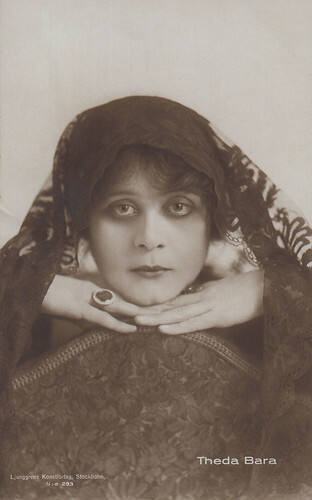
Swedish postcard by Ljunggrens Konstförlag Stockholm, no. 293.
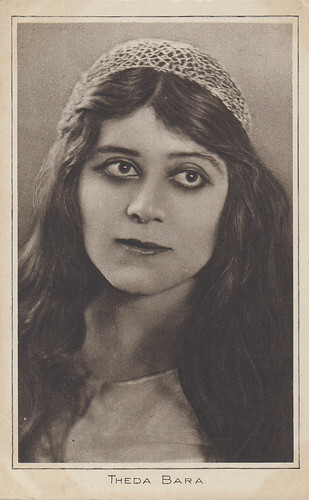
British postcard by Pictures Portrait Gallery, no. 4. Photo: Fox. Theda Bara in Romeo and Juliet (J. Gordon Edwards, 1916).
A former vamp’s new lease on life
As film offers didn’t pour in, she accepted to star in the play 'The Blue Flame'. She played it to very good business in several cities before it hit Broadway on the 15th of March 1920. The critics were merciless but newspapers noted that, nevertheless, it drew large crowds. Audiences were eager to see Theda in person. On top of her regular salary, Theda had shrewdly negotiated a fifty percent interest in the play, which brought her a hefty profit.
After 'The Blue Flame' closed on Broadway, she went on a successful tour with it. In 1921, she accepted a lucrative offer to appear in a vaudeville act and went on tour again all across the U.S.A. In 1922, it was announced that she had signed a one-film contract with Lewis Selznick but nothing ever came of it.
Theda came back on the screen in The Unchastened Woman (1925), produced by a small company called Chadwick Pictures, but it failed to generate much interest. She then signed with Hal Roach to appear in a series of comedy shorts. She only made one, Madame Mystery (1926), and soon asked to cancel her contract. It was her last movie.
Later, she made her final stage appearance in Los Angeles in 1934 with 'Bella Donna', in a five-night engagement, and she occasionally took part in radio shows. But, mostly, she simply chose to enjoy life. Free from want, she became a well-known social figure, often giving parties at her Beverly Hills house. She was reputed to be a witty, cultured and engaging hostess, noted for the delicious dishes she served to her guests.
A long way from her former portrayals of homewreckers and man-eaters, she formed a happy and long-lasting couple with her husband, Charles Brabin. In her final years, she settled into a calm and peaceful existence and she allegedly used to bake cookies for neighbourhood children, who probably had no idea that this kind old lady had once been the wickedest woman on the screen. Theda Bara died on the 7th of April 1955, from abdominal cancer.
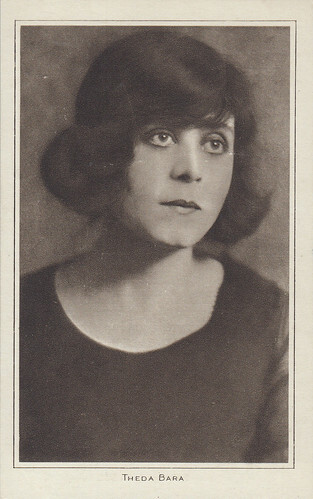
British postcard by Pictures Portrait Gallery, no. 146.
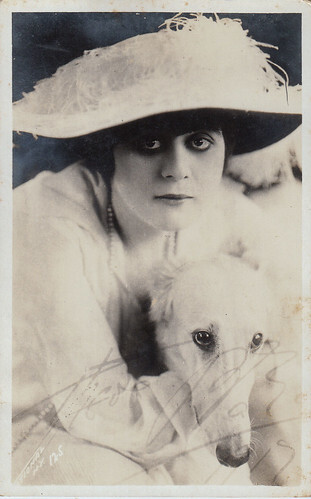
American postcard, no. 125, signed in 1919.
Theda’s legacy
In 1958, Life magazine invited Marilyn Monroe and photographer Richard Avedon to recreate images of five celebrated actresses of different eras. Theda was part of the selection, alongside Lillian Russell, Clara Bow , Marlene Dietrich and Jean Harlow . In the 1960s, a photo of Theda Bara in Salome adorned the cover of the British counterculture newspaper International Times.
Her eyes were also used for the logo of the Chicago film festival. Even in the French film Le distrait (1970), a Theda Bara poster can be seen on the wall of Pierre Richard ’s office. In 1994, she was one of ten silent stars honoured with a U.S. postal stamp, in a caricature by Al Hirschfeld. Today, she is one of the very few stars from the silent era whose name still has a certain significance.
Only four of her starring movies are known to be extant. Unfortunately, they don’t permit us to really judge her as an actress. A Fool There Was (1915) has undoubtedly important historical value but can appear to some as rather crudely made. East Lynne (1916), in which she played an ill-fated divorcee, is not representative of her body of work at Fox. As for The Unchastened Woman (1925) and Madame Mystery (1926), they have been produced when she was not in her prime anymore.
Silent movie buffs still strongly hope that some other Theda Bara vehicles will be discovered one day. It’s not a coincidence that the American Film Institute has included Cleopatra on its 'Ten Most Wanted' list of lost films.
Nevertheless, we are lucky to have plenty of photos of Theda Bara. On several of them, she is seen in a sultry or exotic mood, lying over a skeleton, appearing in revealing outfits or posing with crystal balls or buddhas. But she also looks less flamboyant, even demure, in other shots. Her portraits seem to corroborate that, maybe, there was some truth in what Theda Bara said several times in interviews, namely that she was a more versatile actress than her vamp image would have let thought.
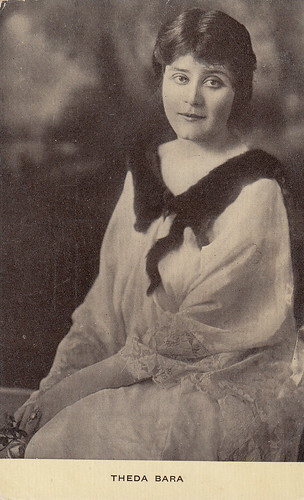
American postcard by Kraus Mfg. Co., New York.
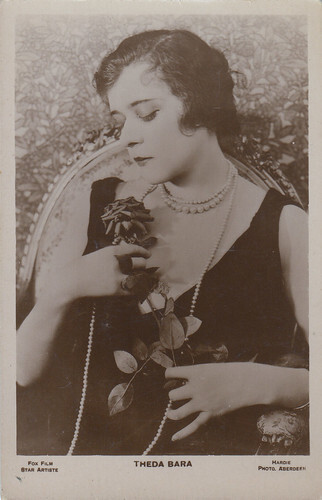
British postcard by Hardie, Aberdeen. Photo: Fox. Theda Bara in The Rose of Blood (J. Gordon Edwards, 1917).
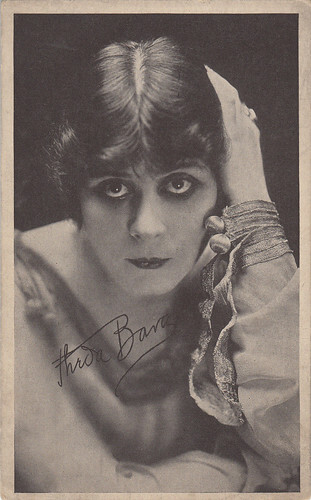
American postcard by White, 370 East 23D Street, Brooklyn, N.Y.
Text and postcards: Marlene Pilaete.

American postcard by Kline Poster Co. Inc., Philadelphia. Photo: Fox. Theda Bara in Carmen (Raoul Walsh, 1915).
To introduce her to the public, two Fox publicity agents, John Goldfrap and Al Selig launched an astonishing advertising campaign, inventing a foreign background for their new star. They claimed that Theda was born in Egypt, in the shadow of the Sphinx, to an Italian artist and a French actress and that she had been a stage star in Paris before coming to the U.S.A. None of this was true. It’s commonly assumed that those rather far-fetched stories were not meant to be taken seriously but that they were created to offer entertaining and escapist reading to thrill-seeking audiences. Anyway, it should be noted that, as early as mid-1915, several newspapers had begun to reveal that Theda was, in fact, a Cincinnati-born girl. With her heavily kohl-rimmed eyes and her racy on-screen persona, she offered for sure a distinct contrast to child women such as Mary Pickford or healthy and spunky serial heroines such as Pearl White. The public was delighted to see an actress whose primary attraction was her sexuality.
Later, Fox's publicity department came up with other weird stories, declaring e.g. that the souls of Delilah, Lucrezia Borgia and the bloody countess Elizabeth Bathory were reincarnated in Theda’s mind, that a physician had discovered that the actress had the muscular system of a serpent or that her contract included several special clauses, such as forbidding her to marry or to appear in public without veils. Photos of an unveiled and smiling Theda selling Liberty Bonds in New York in the fall of 1917 seems to indicate that this bizarre contract either was not intended to be fulfilled or only existed in Goldfrap and Selig’s minds.
Theda Bara herself was quite ambivalent about this kind of publicity. On the one hand, she knew that such outlandish press coverage stereotyped her. On the other hand, she was well aware of the value of her transgressive and exotic image. So she played the game by mentioning for example an emerald ring which "had been given to her by a blind sheikh", by declaring that she was deeply attached to two statuettes of Egyptian God Amen Ra which "have been bought in a Paris shop when she was a child" or by pretending, at the time of Carmen, that she had lived in Spain in one previous life.
From 1915 to 1919, she starred in an amazing output of thirty-nine movies and her successes enabled William Fox to lay the groundwork for his empire. In private, Theda Bara was quite unlike her image. In her heyday at Fox, she lived quietly with her mother and her sister, her off-screen reputation unblemished by any scandal or misbehaviour. She only married once, to director Charles Brabin in 1921, and their happy union lasted until her death in 1955.

British postcard by Lilywhite in the Cinema Stars series, no. C.M. 94. Photo: William Fox. Theda Bara in Salome (J. Gordon Edwards, 1918).

British postcard by Lilywhite in the Cinema Stars series, no. C.M. 413D. Photo: William Fox. Theda Bara in Salome (J. Gordon Edwards, 1918).
Theda Bara before she became the queen of vamps
Theda Bara was born Theodosia Goodman on the 29th of June 1885 in Cincinnati, Ohio, U.S.A. Her father was a Jewish Polish-born tailor and her mother was born in Switzerland.
From an early age, she was fascinated by acting and, after having spent two years at Cincinnati University, she dropped out in 1905 to go on stage. The following years are not very well documented.
Confirmed appearances include a small role in Ferenc Molnar’s 'The Devil on Broadway' in 1908 and touring in a road company with the musical 'The Quaker Girl' in 1911.
Her stage career going nowhere, she decided to give it a try to movies. She made her film debut at Pathe with a bit role in Frank Powell’s The Stain (1914). He took interest in her as he liked the way she photographed and reacted to direction.

British postcard by Lilywhite Ltd, no. C.M. 29. Photo: William Fox.

British postcard by Lilywhite Ltd, no. C.M. 410 B. Photo: William Fox.

British postcard in the Famous Cinema Stars series by J. Beagles & Co. Ltd. London, no. 132. B.
A Fool There Was
'A Fool There Was' was a 1909 Broadway play, inspired by an 1897 Rudyard Kipling poem called 'The Vampire', itself inspired by a painting. The play, which was also adapted into a book, tells the story of a diplomat falling into the clutches of an evil seductress, who ruins his life. William Fox bought the rights and hired Frank Powell to direct the film version.
At his suggestion, Fox signed, in the fall of 1914, the unknown Theodosia to play the leading female role. She was quickly rebaptised Theda Bara, Theda being a diminutive of Theodosia and Bara coming for her maternal grandfather’s name, Baranger. A Fool There Was was released in January 1915. It was a huge hit and made Theda Bara a star overnight.
Of course, it was not the first time that a temptress had been depicted in an American movie but it was certainly the first time that it was done with such force and carnal power. The heroine has absolutely no redeeming features in her actions. In the course of the plot, we see for example that one of her former victims had become a skid-row bum.
"See what you have done to me, and still you prosper, you hellcat", he says to a haughty Theda, who quickly asks a policeman to move the poor chap away. When another of her discarded ex-boyfriends confronts her, armed with a gun, she just calmly answers him "Kiss me my Fool" and, still under her spell, he shoots himself. Furthermore, her unnamed character, simply called 'The Vampire' all through the film, is not even punished in the end. Indeed, a triumphant Theda is seen in the final reel scattering flower petals over her lover’s lifeless body and we are left to imagine her ready to move on to other prey.
We can easily imagine the shock it had been to audiences at that time to see such an evil, unrepentant and erotically charged character. The New York Dramatic Mirror wrote: "Miss Bara misses no chance for sensuous appeal in her portrayal of the Vampire. She is a horribly fascinating woman, vicious to the core, and cruel". And, for the New York Morning Telegraph, the Vampire was "quite the most revolting but fascinating character that has appeared upon the screen for some time".

British postcard by Lilywhite Ltd, no. C.M. 413 E. Photo: William Fox.

British postcard in the Famous Cinema Stars series by J. Beagles & Co. Ltd. London, no. 132a. Photo: William Fox.
Fox’s undisputed queen
After A Fool There Was, Theda Bara stole her sister’s husband in Kreutzer Sonata (1915), was an unfaithful and depraved wife in The Clemenceau Case (1915) and wrecked a sculptor’s marital bliss in The Devil’s Daughter (1915). By now, she had become firmly associated with vampire roles and the abbreviation 'vamp' soon became a household word. After the disappointing box-office receipts of Lady Audley’s Secret (1915) and The Two Orphans (1915), in which she played more restrained characters, Fox wisely put her back on the vamping track in films such as Sin (1915), Carmen (1915), Destruction (1915), The Serpent (1915) or Gold and the Woman (1916). Needless to say, some of her films met with censorship problems.
From time to time, usually at her demand, she was again given non-vamping parts such as in East Lynne (1916), Under Two Flags (1916), Romeo and Juliet (1916), Her Greatest Love (1917) or Heart and Soul (1917) but it seemed that her fans always preferred her as a femme fatale. They were thrilled to see her for example in The Vixen (1916), in which her character proclaims: "It’s true that I have no heart but then, I am more comfortable without one", and in The Tiger Woman (1917), which caused one reviewer to write: "The wholesome damage that strews her pathway would put a Kansas cyclone to shame".
Just after having played the famous French courtesan Marguerite Gautier in Camille (1917), she starred in the most prestigious film of her career, the lavish Cleopatra (1917). Never to be outdone, Fox advertising services reported the discovery, in a tomb of the ancient Egyptian city of Thebes, of an inscription found on an antique stone wall forecasting the coming of Theda Bara several centuries later. The fact that her pseudonym was an anagram of 'Arab Death' added extra spice to this odd story. Theda herself suggested that she was a reincarnation of the last queen of Egypt.
All this was good publicity playfulness and was great fun to read. The risqué costumes she wore (such as a snake bra and other revealing brassieres) didn’t go unnoticed and attracted much comment. She most probably had never displayed so much flesh before. Cleopatra was one of the most popular films of 1917 and cemented her position as Fox’s nr 1 moneymaker. She later appeared in two other special big-budgeted productions, Madame du Barry (1917) and Salome (1918). In August 1918, the actress came tenth in a popularity poll held by Motion Picture Magazine, above Charlie Chaplin , who ranked 17th.
As 1919 went by, the Theda Bara vogue was beginning to wane. When Men Desire (1919), The Siren’s Song (1919) and A Woman There Was (1919) didn’t do too well at the box office. Tired of vamp roles, she then elected to play a virginal Irish peasant in Kathleen Mavourneen (1919). Unfortunately, Irish societies strongly objected to the movie. Faced with threats and riots, several theatres quickly withdrew Kathleen Mavourneen and some even preferred not to show it. After this debacle, Theda’s high hopes to give a new impetus to her career were dashed and her Fox contract came to an end with two more films, La Belle Russe (1919) and The Lure of Ambition (1919).

Swedish postcard by Ljunggrens Konstförlag Stockholm, no. 293.

British postcard by Pictures Portrait Gallery, no. 4. Photo: Fox. Theda Bara in Romeo and Juliet (J. Gordon Edwards, 1916).
A former vamp’s new lease on life
As film offers didn’t pour in, she accepted to star in the play 'The Blue Flame'. She played it to very good business in several cities before it hit Broadway on the 15th of March 1920. The critics were merciless but newspapers noted that, nevertheless, it drew large crowds. Audiences were eager to see Theda in person. On top of her regular salary, Theda had shrewdly negotiated a fifty percent interest in the play, which brought her a hefty profit.
After 'The Blue Flame' closed on Broadway, she went on a successful tour with it. In 1921, she accepted a lucrative offer to appear in a vaudeville act and went on tour again all across the U.S.A. In 1922, it was announced that she had signed a one-film contract with Lewis Selznick but nothing ever came of it.
Theda came back on the screen in The Unchastened Woman (1925), produced by a small company called Chadwick Pictures, but it failed to generate much interest. She then signed with Hal Roach to appear in a series of comedy shorts. She only made one, Madame Mystery (1926), and soon asked to cancel her contract. It was her last movie.
Later, she made her final stage appearance in Los Angeles in 1934 with 'Bella Donna', in a five-night engagement, and she occasionally took part in radio shows. But, mostly, she simply chose to enjoy life. Free from want, she became a well-known social figure, often giving parties at her Beverly Hills house. She was reputed to be a witty, cultured and engaging hostess, noted for the delicious dishes she served to her guests.
A long way from her former portrayals of homewreckers and man-eaters, she formed a happy and long-lasting couple with her husband, Charles Brabin. In her final years, she settled into a calm and peaceful existence and she allegedly used to bake cookies for neighbourhood children, who probably had no idea that this kind old lady had once been the wickedest woman on the screen. Theda Bara died on the 7th of April 1955, from abdominal cancer.

British postcard by Pictures Portrait Gallery, no. 146.

American postcard, no. 125, signed in 1919.
Theda’s legacy
In 1958, Life magazine invited Marilyn Monroe and photographer Richard Avedon to recreate images of five celebrated actresses of different eras. Theda was part of the selection, alongside Lillian Russell, Clara Bow , Marlene Dietrich and Jean Harlow . In the 1960s, a photo of Theda Bara in Salome adorned the cover of the British counterculture newspaper International Times.
Her eyes were also used for the logo of the Chicago film festival. Even in the French film Le distrait (1970), a Theda Bara poster can be seen on the wall of Pierre Richard ’s office. In 1994, she was one of ten silent stars honoured with a U.S. postal stamp, in a caricature by Al Hirschfeld. Today, she is one of the very few stars from the silent era whose name still has a certain significance.
Only four of her starring movies are known to be extant. Unfortunately, they don’t permit us to really judge her as an actress. A Fool There Was (1915) has undoubtedly important historical value but can appear to some as rather crudely made. East Lynne (1916), in which she played an ill-fated divorcee, is not representative of her body of work at Fox. As for The Unchastened Woman (1925) and Madame Mystery (1926), they have been produced when she was not in her prime anymore.
Silent movie buffs still strongly hope that some other Theda Bara vehicles will be discovered one day. It’s not a coincidence that the American Film Institute has included Cleopatra on its 'Ten Most Wanted' list of lost films.
Nevertheless, we are lucky to have plenty of photos of Theda Bara. On several of them, she is seen in a sultry or exotic mood, lying over a skeleton, appearing in revealing outfits or posing with crystal balls or buddhas. But she also looks less flamboyant, even demure, in other shots. Her portraits seem to corroborate that, maybe, there was some truth in what Theda Bara said several times in interviews, namely that she was a more versatile actress than her vamp image would have let thought.

American postcard by Kraus Mfg. Co., New York.

British postcard by Hardie, Aberdeen. Photo: Fox. Theda Bara in The Rose of Blood (J. Gordon Edwards, 1917).

American postcard by White, 370 East 23D Street, Brooklyn, N.Y.
Text and postcards: Marlene Pilaete.
Published on December 29, 2022 22:00
December 28, 2022
La multi ani!
The Romanian publishing house Casa Filmului Acin used to publish many postcards in black and white and in colour with international stars. In the early 1970s, Acin also made black and white calendar cards in mini format (6 x 10 cm) with famous stars: the series La multi ani! (Happy birthday!) Our friend Alina Deaconu from Bucharest likes to collect them and sent us many photos of her La multi ani! collection. Today, at the end of this year, we share 27 of these with you. Thank you so much, Alina!
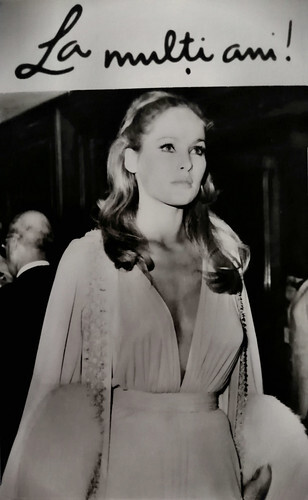
Romanian calendar card by Casa Filmului Acin. La multi ani! Ursula Andress .
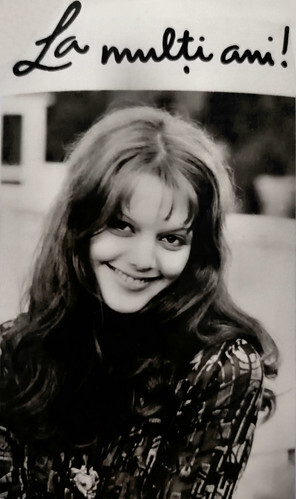
Romanian calendar card by Casa Filmului Acin. La multi ani! Tina Aumont .
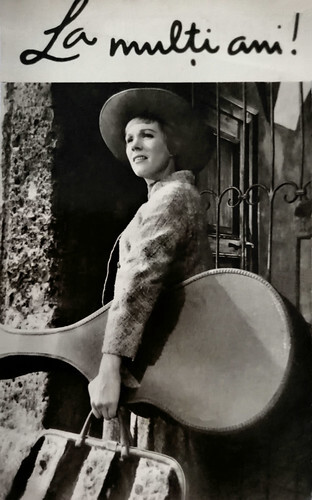
Romanian calendar card by Casa Filmului Acin. La multi ani! Julie Andrews in The Sound of Music (Robert Wise, 1965).
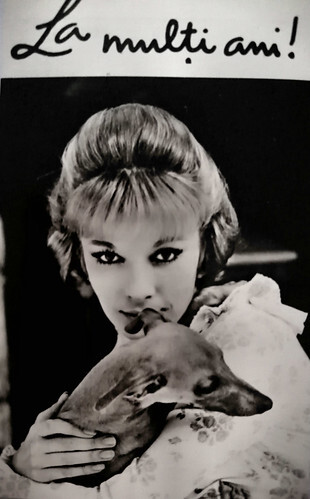
Romanian calendar card by Casa Filmului Acin. La multi ani! Dany Saval .
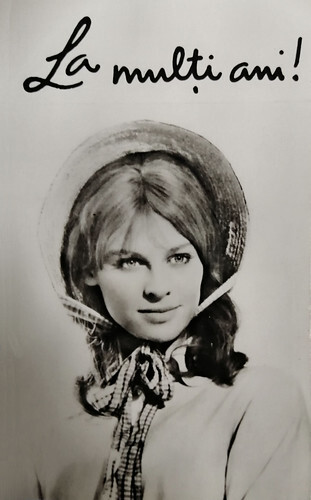
Romanian calendar card by Casa Filmului Acin. La multi ani! Julie Christie in Far from the Madding Crowd (John Schlesinger, 1967).
Acin calendar cards
Alina Deaconu wrote to me: "As you well know, writing about the Acin calendar cards is a very complicated job. Here I'm referring in particular to the small black-and-white calendar cards (6 x 10 cm) edited by Acin.
The Acin film house, Casa Filmului Acin, started editing cards with actors and scenes from films somewhere around the end of the 1960s. The vast majority of these early cards were black and white. The small calendar cards appeared between 1970 and 1973. This is all that I know about them.
In the following years, more calendar cards were published by Acin, but these were in a postcard format and in colour. An example is the Brigitte Bardot calendar card in colour in this post.
My collection of small calendar cards îs for 90% made up of cards bought in recent years. They are very rare and are very hard to find anyway. It would be interesting to know if someone else has more information about the postcards and calendar cards edited by Acin.
I don't know anything about collectors of the Acin calendar cards. A seller from whom I bought many postcards and calendar cards gave up his collection and that's how I managed to purchase a few more."
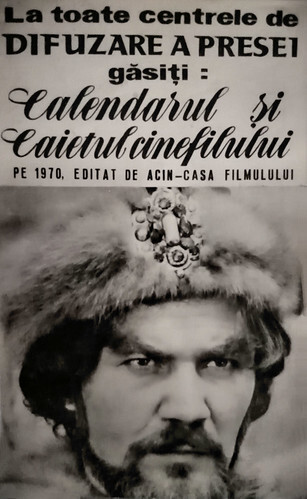
Romanian calendar card by Casa Filmului Acin. Ion Besoiu.
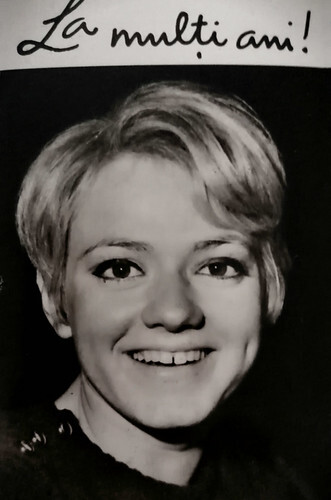
Romanian calendar card by Casa Filmului Acin, 1972. Rita Pavone - front side.
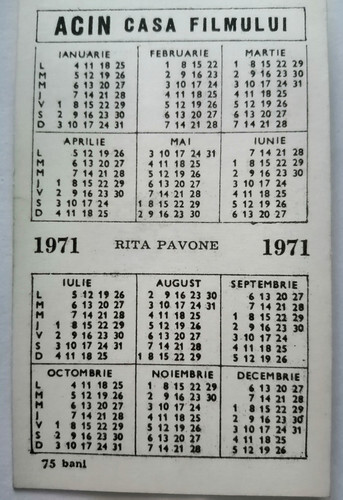
Romanian calendar card by Casa Filmului Acin, 1972. Rita Pavone - back side.
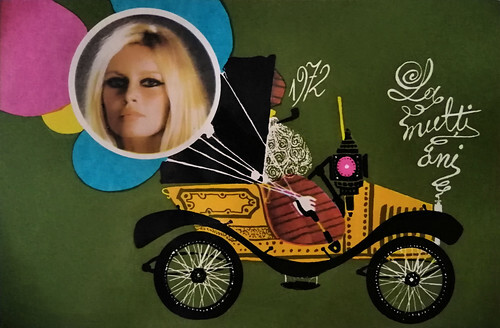
Romanian postcard by Casa Filmului Acin, no. 106. Caption: La multi ani 1972. Brigitte Bardot .
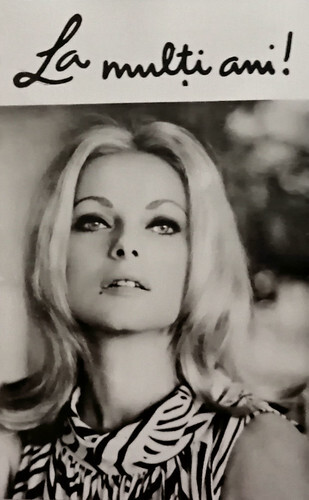
Romanian calendar card by Casa Filmui Acin, 1973. La multi ani! Virna Lisi .
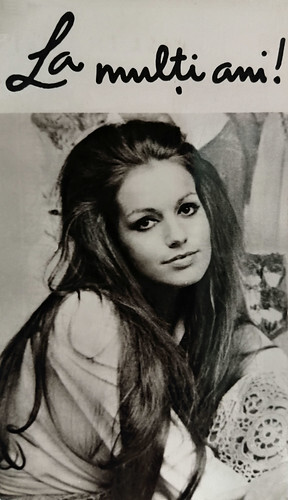
Romanian calendar card by Casa Filmui Acin, 1973. La multi ani! Catherine Spaak .
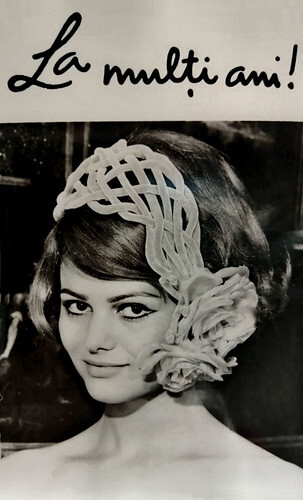
Romanian calendar card by Casa Filmui Acin, 1971. La multi ani! Claudia Cardinale .
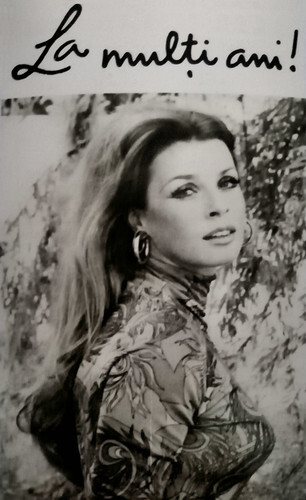
Romanian calendar card by Casa Filmui Acin, 1971. La multi ani! Senta Berger .
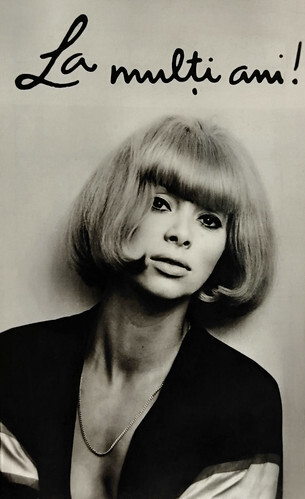
Romanian calendar card by Casa Filmui Acin, 1971. La multi ani! Mireille Darc .
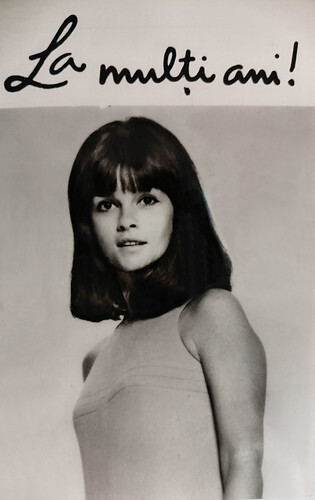
Romanian calendar card by Casa Filmui Acin, 1971. La multi ani! Geneviève Bujold.
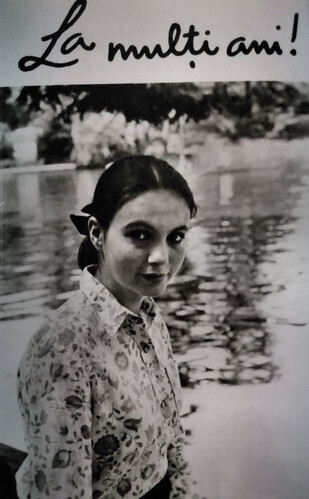
Romanian calendar card by Casa Filmui Acin, 1973. La multi ani! Sophie Darès.
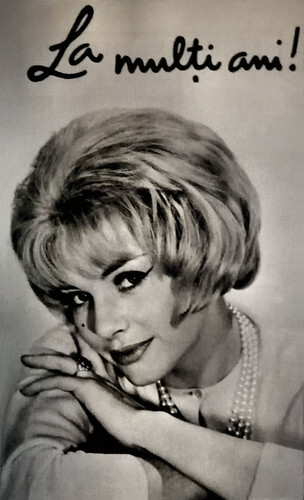
Romanian calendar card by Casa Filmui Acin, 1972. La multi ani! Sophie Hardy .
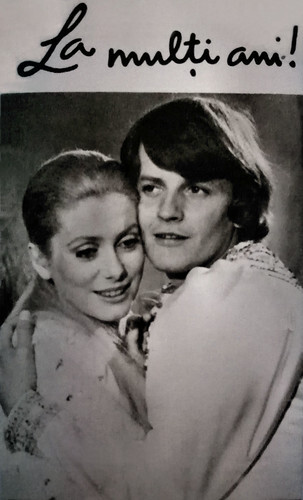
Romanian calendar card by Casa Filmui Acin, 1973. La multi ani! Catherine Deneuve and Jacques Perrin in Peau d'âne/Donkey Skin (Jacques Demy, 1970).
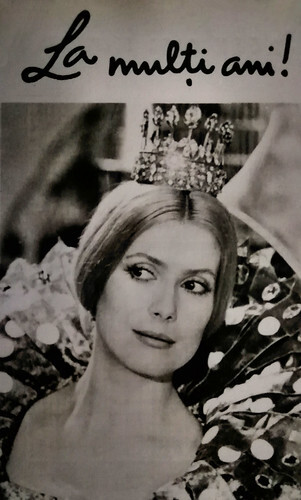
Romanian calendar card by Casa Filmui Acin, 1973. La multi ani! Catherine Deneuve in Peau d'âne/Donkey Skin (Jacques Demy, 1970).
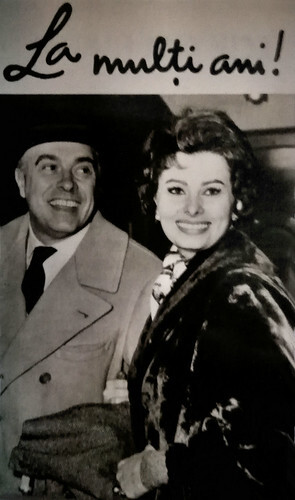
Romanian calendar card by Casa Filmui Acin. La multi ani! Carlo Ponti and Sophia Loren .
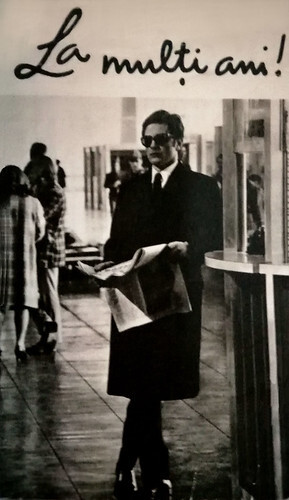
Romanian calendar card by Casa Filmui Acin. La multi ani! Alain Delon .
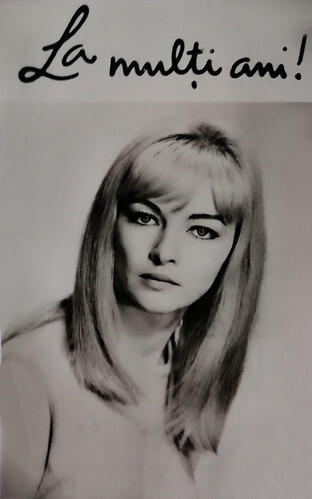
Romanian calendar card by Casa Filmui Acin. La multi ani! Barbara Brylska .
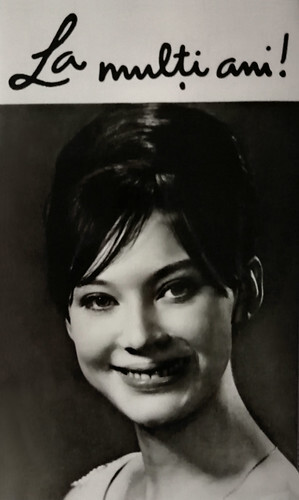
Romanian calendar card by Casa Filmui Acin. La multi ani! Lyudmila Saveleva .
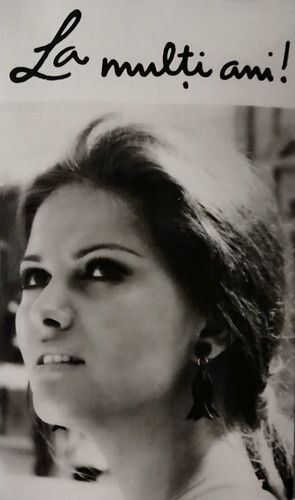
Romanian calendar card by Casa Filmui Acin. La multi ani! Claudia Cardinale .
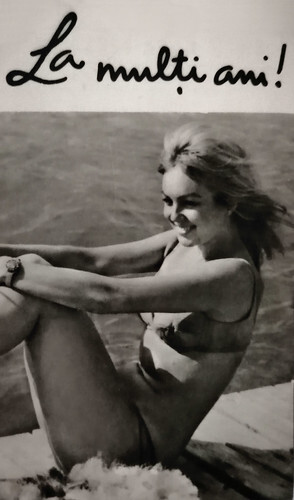
Romanian calendar card by Casa Filmui Acin. La multi ani! Mylène Demongeot .
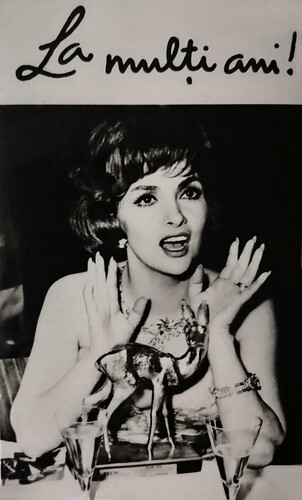
Romanian calendar card by Casa Filmui Acin. La multi ani! Gina Lollobrigida .
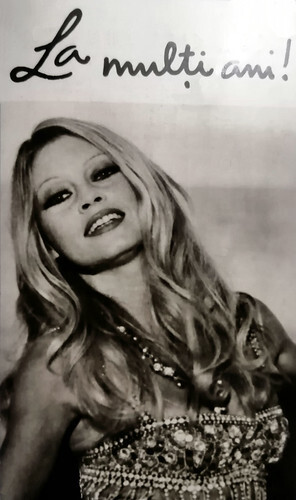
Romanian calendar card by Casa Filmui Acin, 1973. La multi ani! Brigitte Bardot în Boulevard du Rhum/Rum Runners (Robert Enrico, 1971).
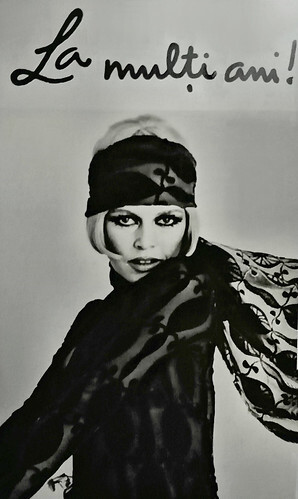
Romanian calendar card by Casa Filmui Acin, 1973. La multi ani! Brigitte Bardot .
All the calendar cards are from the collection of Alina Deaconu.

Romanian calendar card by Casa Filmului Acin. La multi ani! Ursula Andress .

Romanian calendar card by Casa Filmului Acin. La multi ani! Tina Aumont .

Romanian calendar card by Casa Filmului Acin. La multi ani! Julie Andrews in The Sound of Music (Robert Wise, 1965).

Romanian calendar card by Casa Filmului Acin. La multi ani! Dany Saval .

Romanian calendar card by Casa Filmului Acin. La multi ani! Julie Christie in Far from the Madding Crowd (John Schlesinger, 1967).
Acin calendar cards
Alina Deaconu wrote to me: "As you well know, writing about the Acin calendar cards is a very complicated job. Here I'm referring in particular to the small black-and-white calendar cards (6 x 10 cm) edited by Acin.
The Acin film house, Casa Filmului Acin, started editing cards with actors and scenes from films somewhere around the end of the 1960s. The vast majority of these early cards were black and white. The small calendar cards appeared between 1970 and 1973. This is all that I know about them.
In the following years, more calendar cards were published by Acin, but these were in a postcard format and in colour. An example is the Brigitte Bardot calendar card in colour in this post.
My collection of small calendar cards îs for 90% made up of cards bought in recent years. They are very rare and are very hard to find anyway. It would be interesting to know if someone else has more information about the postcards and calendar cards edited by Acin.
I don't know anything about collectors of the Acin calendar cards. A seller from whom I bought many postcards and calendar cards gave up his collection and that's how I managed to purchase a few more."

Romanian calendar card by Casa Filmului Acin. Ion Besoiu.

Romanian calendar card by Casa Filmului Acin, 1972. Rita Pavone - front side.

Romanian calendar card by Casa Filmului Acin, 1972. Rita Pavone - back side.

Romanian postcard by Casa Filmului Acin, no. 106. Caption: La multi ani 1972. Brigitte Bardot .

Romanian calendar card by Casa Filmui Acin, 1973. La multi ani! Virna Lisi .

Romanian calendar card by Casa Filmui Acin, 1973. La multi ani! Catherine Spaak .

Romanian calendar card by Casa Filmui Acin, 1971. La multi ani! Claudia Cardinale .

Romanian calendar card by Casa Filmui Acin, 1971. La multi ani! Senta Berger .

Romanian calendar card by Casa Filmui Acin, 1971. La multi ani! Mireille Darc .

Romanian calendar card by Casa Filmui Acin, 1971. La multi ani! Geneviève Bujold.

Romanian calendar card by Casa Filmui Acin, 1973. La multi ani! Sophie Darès.

Romanian calendar card by Casa Filmui Acin, 1972. La multi ani! Sophie Hardy .

Romanian calendar card by Casa Filmui Acin, 1973. La multi ani! Catherine Deneuve and Jacques Perrin in Peau d'âne/Donkey Skin (Jacques Demy, 1970).

Romanian calendar card by Casa Filmui Acin, 1973. La multi ani! Catherine Deneuve in Peau d'âne/Donkey Skin (Jacques Demy, 1970).

Romanian calendar card by Casa Filmui Acin. La multi ani! Carlo Ponti and Sophia Loren .

Romanian calendar card by Casa Filmui Acin. La multi ani! Alain Delon .

Romanian calendar card by Casa Filmui Acin. La multi ani! Barbara Brylska .

Romanian calendar card by Casa Filmui Acin. La multi ani! Lyudmila Saveleva .

Romanian calendar card by Casa Filmui Acin. La multi ani! Claudia Cardinale .

Romanian calendar card by Casa Filmui Acin. La multi ani! Mylène Demongeot .

Romanian calendar card by Casa Filmui Acin. La multi ani! Gina Lollobrigida .

Romanian calendar card by Casa Filmui Acin, 1973. La multi ani! Brigitte Bardot în Boulevard du Rhum/Rum Runners (Robert Enrico, 1971).

Romanian calendar card by Casa Filmui Acin, 1973. La multi ani! Brigitte Bardot .
All the calendar cards are from the collection of Alina Deaconu.
Published on December 28, 2022 22:00
Paul van Yperen's Blog
- Paul van Yperen's profile
- 13 followers
Paul van Yperen isn't a Goodreads Author
(yet),
but they
do have a blog,
so here are some recent posts imported from
their feed.



